LOCAL HERO
Rick Karney, Spawnmeister
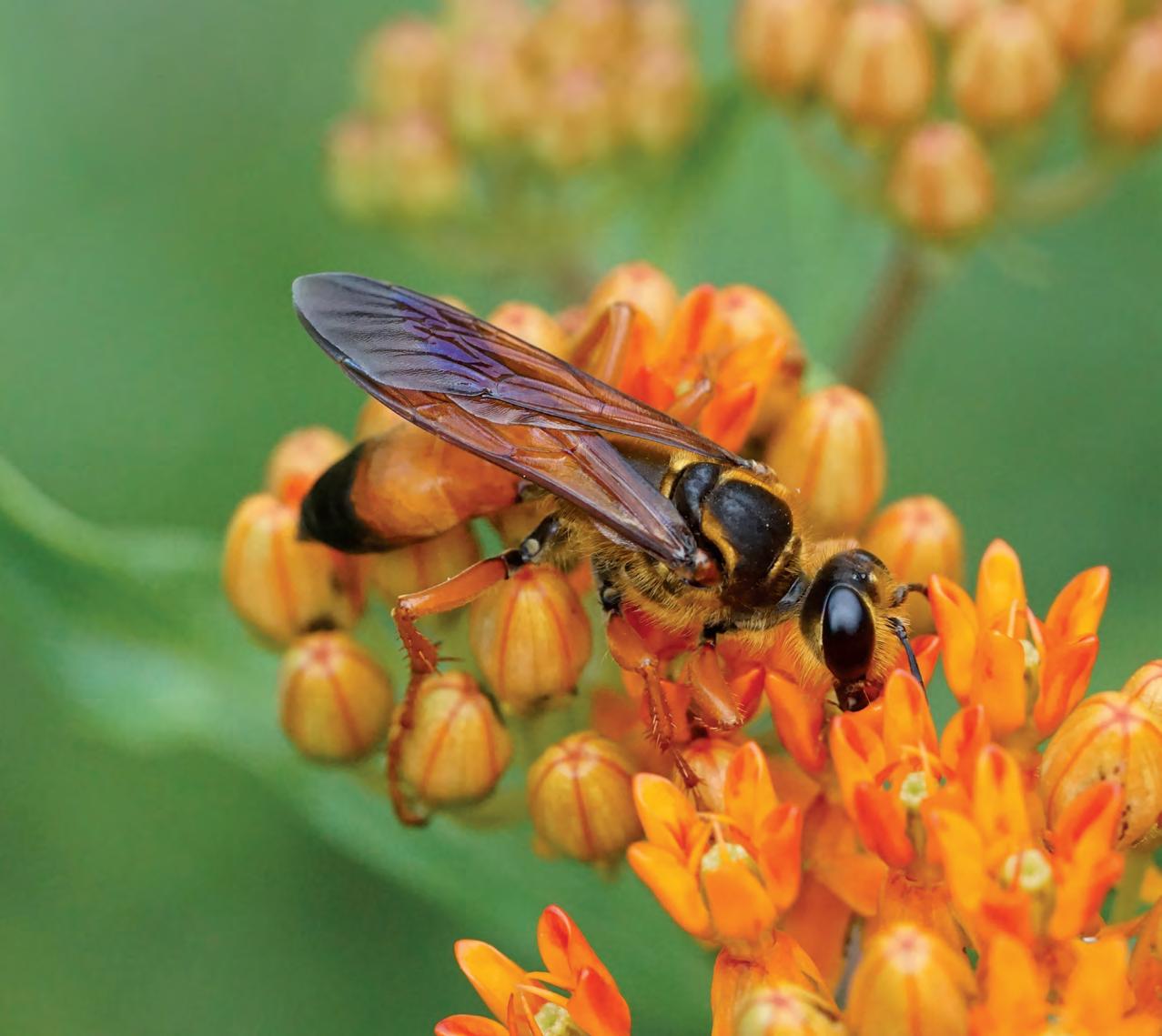
THE BLUEDOT KITCHEN
Cooking With Carol Gilligan
CURRIER CRUISES
With Anna Edey
in Matt Pelikan’s Abundant Meadow
Photographing Champion Trees
SIMPLE / SMART / SUSTAINABLE / STORIES
What’s So Bad About Chocolate? · Where's the Eco- Yoga Gear? · 2024 Climate Fair · MoGlo’s Food Truck
MARTHA’S VINEYARD / SPRING 2024
TM @bluedotlivingmv
BACKYARD BUGS
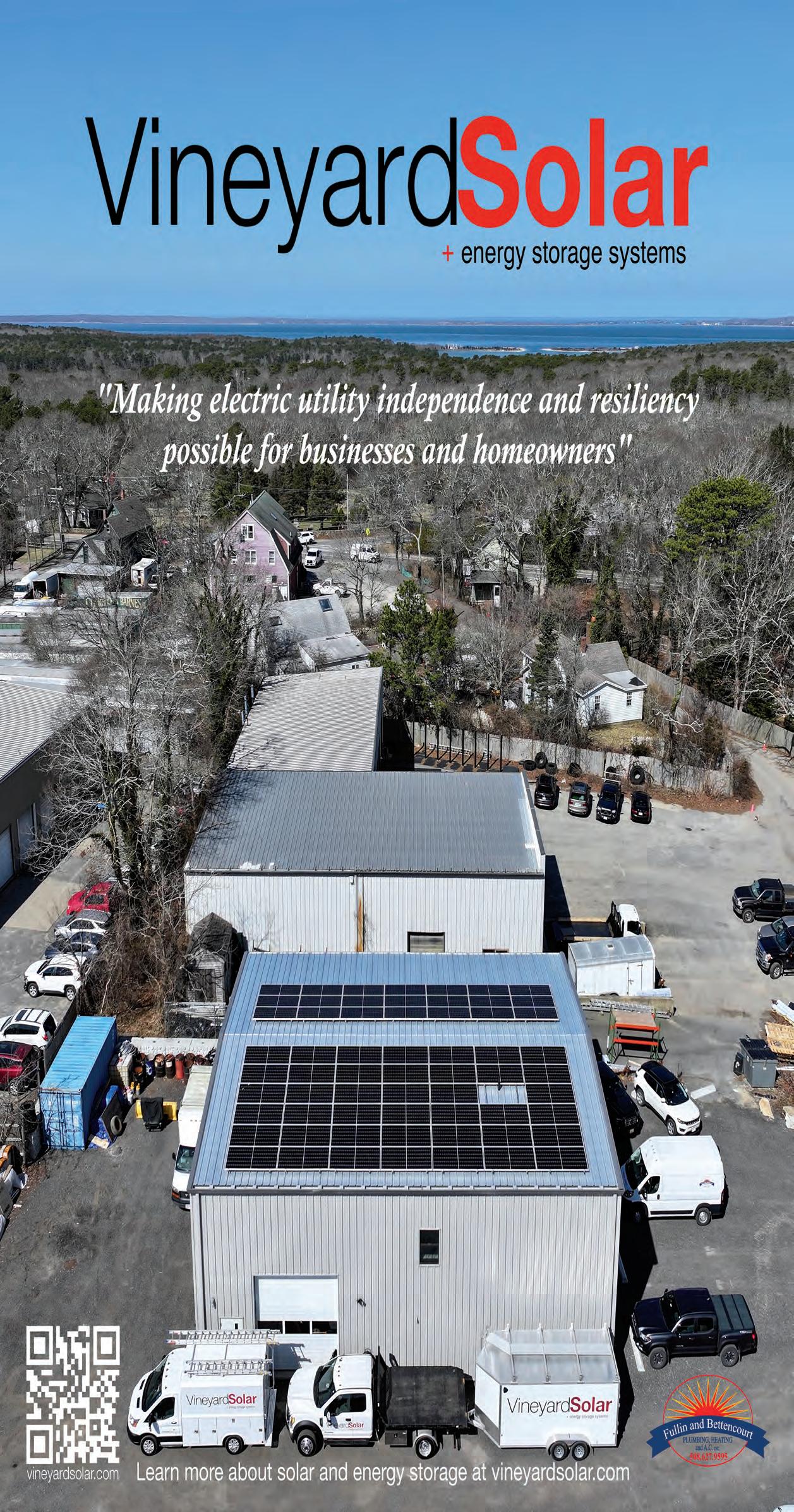
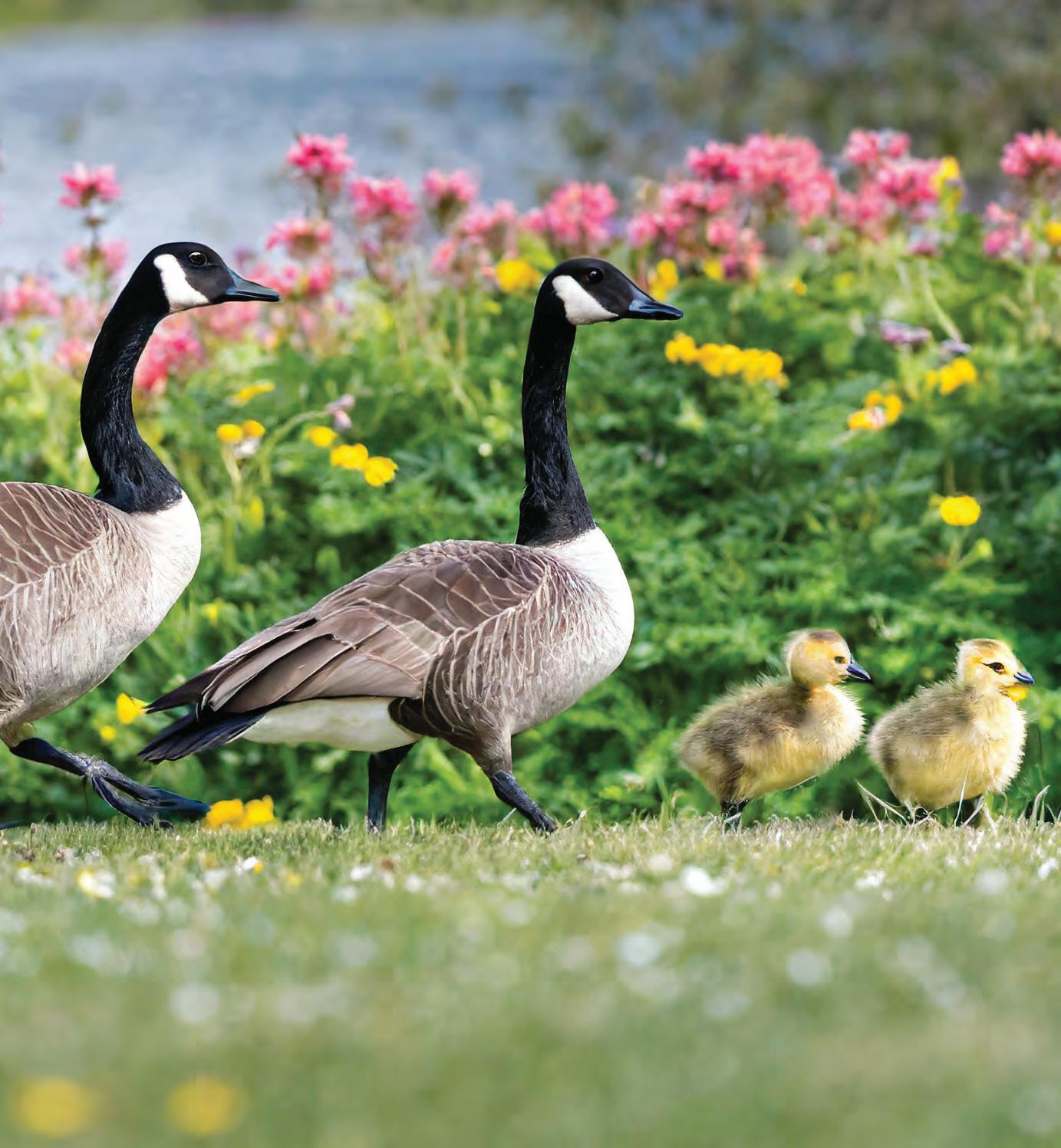

BDL 1 marthasvineyard. .com Don’t let geese take over your property. Contact us today to schedule a consultation and find out how we can help. Contact geese partners now! (508) 627-2454 MV@GeesePartners.com | GeesePartners.com COMMERCIAL, RESIDENTIAL & EVENT GOOSE CONTROL ON MARTHA’S VINEYARD TAKE BACK YOUR TURF SAFE & ECO-FRIENDLY GOOSE CONTROL


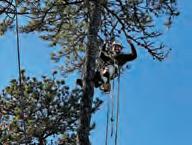

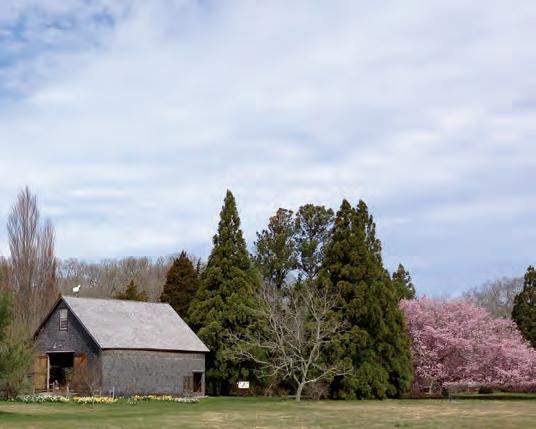

Look again at that dot. That’s here. That’s home. On it everyone you love .” –Carl Sagan
President Victoria Riskin
CEO Raymond Pearce
Editor Jamie Kageleiry, editor@bluedotliving.com
Senior Writer Leslie Garrett
Associate Editors Lucas Thors, Julia Cooper
Copyeditor Laura Roosevelt
Creative Director Tara Kenny
Production Manager Whitney Multari
Design and Production Vesna M. Nepomuceno
Digital Projects Manager Kelsey Perrett
Digital Assets Manager Alison Mead
Contributing Editors Mollie Doyle, Catherine Walthers
Ad Sales Josh Katz, adsales@bluedotliiving.com
Contributors, this issue Randi Baird, Tom Chase, Geoff Currier, Mollie Doyle, Kate Feiffer, Jack Fruchtman, Brian Kelley, Sheny Leon, Tessa Permar, Matt Pelikan, Laura D. Roosevelt
Bluedot and Bluedot Living logos and wordmarks are trademarks of Bluedot, Inc.
Copyright © 2024. All rights reserved.
Bluedot Living: At Home on Earth is printed on recycled material, using soy-based ink, in the U.S.
Bluedot Living magazine is published quarterly and is available at newsstands, select retail locations, inns, hotels, and bookstores, free of charge. Please write us if you’d like to stock Bluedot Living at your business.
Editor@bluedotliving.com
Sign up for the Martha’s Vineyard Bluedot Living newsletter, along with any of our others: the BuyBetter Marketplace, our national ‘Hub” newsletter, and our soon-to-be-launched Bluedot Kitchenr: bit.ly/MV-NEWSLETTER
Subscribe! Get Bluedot Living Martha’s Vineyard and our annual Bluedot GreenGuide mailed to your address. It’s $24.95 a year for all four issues plus the Green Guide, and as a bonus, we’ll email you a collection of Bluedot Kitchen recipes. Subscribe at bit.ly/MVBluedotSubs
Read stories from this magazine and more at marthasvineyard.bluedotliving.com

Find Bluedot Living on Twitter, Instagram, Facebook, and YouTube @bluedotliving
2 MARTHA’S VINEYARD /SPRING 2024
BDL • OUR TEAM
• • • • • •
A MARTHA’S VINEYARD PUBLIC GARDEN Grounds open sunrise to sunset year-round. Visitor Center & Plant Sales open seasonally. 795 State Road, West Tisbury Pollyhillarboretum.org · 508-693-9426 Explore the 72-acre horticultural and historical Island landmark. Be inspired by the globally recognized plant specimens and collections. Learn from the classes, programs and tours · 508-645-2877 beetlebung tree care.com TREE CARE LANDSCAPE CONSTRUCTION LANDSCAPE MAINTENANCE FINE GARDENING PLANT HEALTH CARE INTEGRATED PEST MANAGEMENT TICK & MOSQUITO CONTROL IRRIGATION INSTALLATION & MAINTENANCE CERTIFIED ARBORISTS · CERTIFIED IRRIGATION CONTRACTOR MASS CERTIFIED PESTICIDE APPLICATORS
“
Hello Readers,
Do you have a favorite tree on the Vineyard?
New contributor Tessa Permar introduces us to Brian Kelley, who photographs “Champion” trees around the country (including several here on the Island) in order to raise awareness about protecting them. (And should they have the same legal rights as people? Constitutional law professor Jack Fruchtman weighs in.)
With spring, we celebrate Earth Day, with an Island-wide beach cleanup on Saturday, April 27, followed by a party at the Museum, organized by Vineyard Conservation Society (vineyardconservation.org/events). On Sunday, May 19, the Island’s Climate Action Plan folks host the annual Climate Action Fair at the Ag Hall from noon to 4 pm. Stop by the Bluedot Living table and say hi!
Do you find yourself confused about what distinguishes Vineyard Power from Vineyard Wind? Check out our sponsored article from Vineyard Power about what this Island organization dedicated to a renewable energy future is all about.

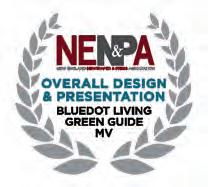

It's Bluedot's third birthday! We just got some very welcome gifts from the New England Newspaper Publishers Association (NENPA): We were named finalists for two Sam Moore stories — Social Issues Features (“What’s So Bad About Coffee?”), and Environmental Reporting (“Secrets of the Salt Marshes”); Serious Columnist (Laura Roosevelt’s “Garden to Table” series). Our website (produced by Kelsey Perrett and Alison Mead) came in second in New England for Best Overall Website. And we won the top prizes for Tara Kenny’s illustration of seasonal wild fish in our waters that accompanied our “Wild Caught” story. That Bluedot Kitchen story, by Catherine Walthers (with photos by Sheny Leon), won first place for “Best Food Section.”
Our inaugural issue of Martha’s Vineyard Green Guide won first place for Overall Design and Presentation (Tara Kenny and Whitney Multari). And Bluedot Living Martha’s Vineyard won the overall top prize (General Excellence), a product of hard work by the staff above, all our regular contributors, and other staff (senior writer Leslie Garrett, associate editors Lucas Thors and Julia Cooper, copy editor Laura Roosevelt, director of sales Josh Katz, CEO Ray Pearce, and founder and president Victoria Riskin.)
We appreciate all your support and ideas and contributions over the last three years.
Thank you!
Jamie Kageleiry



Solar System & Battery Installation Commercial & Residential Canopies & Pergolas


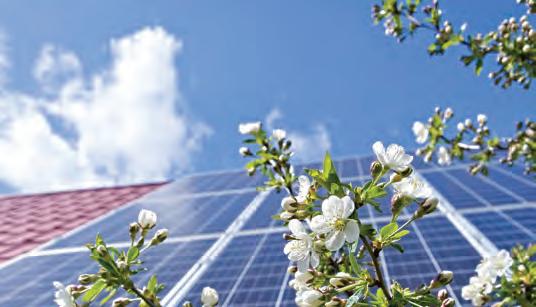


3 marthasvineyard. .com EDITOR'S LETTER
Serving the Community of Martha’s Vineyard
We’ll help you build a brighter future. Offset energy costs and reduce the environmental impact of your home by switching to solar. Cape Cod 5 offers solar financing with flexible terms and competitive rates to qualifying homeowners. Member FDIC NMLS #401717 SCAN ME Reach out to us. We’re here to help. capecodfive.com | 888-225-4636 Visit our Vineyard Haven Banking Center or scan the QR code to learn more.
26 Gathering Growth By
Tessa Permar
Brian Kelley was awed by Martha’s Vineyard’s windswept and salt-scarred trees. He’s memorialized them by photographing them, along with “Champion Trees” from around the country — the nation’s largest and oldest (we have one here in Edgartown). 34 Do Trees Have the Same Rights
By Jack Fruchtman
If a corporation can have the same rights accorded to a person, why not a tree? Or a river? Or an elephant?
By Matt Pelikan
Naturalist Matt Pelikan replaced his lawn with a meadow and now gets to watch (and photograph) bugs all day.
What’s So Bad About Chocolate?
By Leslie Garrett
Chocolate has a bittersweet pedigree that includes child labor and deforestation. But don’t give up yet on your favorite treat — you just need to know where to look for it.
24 Vineyard Power
Some Islanders sat around someone’s living room in 2009 and ended up creating an organization that they hoped would propel the Vineyard toward a more renewable energy future. Fifteen years later, they’ve accomplished a lot of what they set out to do. We asked questions (including: What’s the difference between Vineyard Power and Vineyard Wind?).

18 Dear Dot: Help Me Find a (Healthy) Cologne!
20 Cruising with Currier
Geoff rides around with eco-innovator Anna Edey in one of her two Nissan Leafs (Anna really likes Nissan Leafs).
42 Field Note: Village and Wilderness Microhabitat solutions, on MV and beyond.
50 The Bluedot Kitchen
Laura Roosevelt cooks with Carol Gilligan.
56 Room for Change: The Workout
Mollie Doyle just loves her stretchy yoga clothes, which aren’t so eco-friendly. What to do?
64 Local Hero: Rick Karney
By Lucas Thors
Rick Karney and the MV Shellfish Group have been championing Island aquaculture for almost fifty years. The “Spawnmeister” is still at it in his retirement, but he’s also growing figs in his backyard.

4 MARTHA’S VINEYARD /SPRING 2024
Departments CONTENTS 2 Our Team 3 Editor's Letter 6 All About the Morning Glory Food Truck
12 Stories From All Over
By Lucas Thors
universe
Connecting the dots from around the Bluedot
16 Save the Date: Annual Climate Fair, May 19
as People?
36
The Bugs in My Backyard
44
Features
Newsletters to sign up for Martha's Vineyard Bluedot Living: bit.ly/MV-NEWSLETTER The
BuyBetter Marketplace, Your Daily Dot:
up here: bit.ly/BDL-newsletters
Upfront
Bluedot Kitchen, The
Sign
Sponsored
Cover photograph: A great golden digger wasp, Sphex ichneumoneus, forages on a butterfly weed flower head in Matt Pelikan’s backyard meadow. Photo by Matt Pelikan
Photograph
this page:
The Del Norte Titan Coast Redwood, Jedediah Smith Redwoods State Park, California. By Brian Kelley
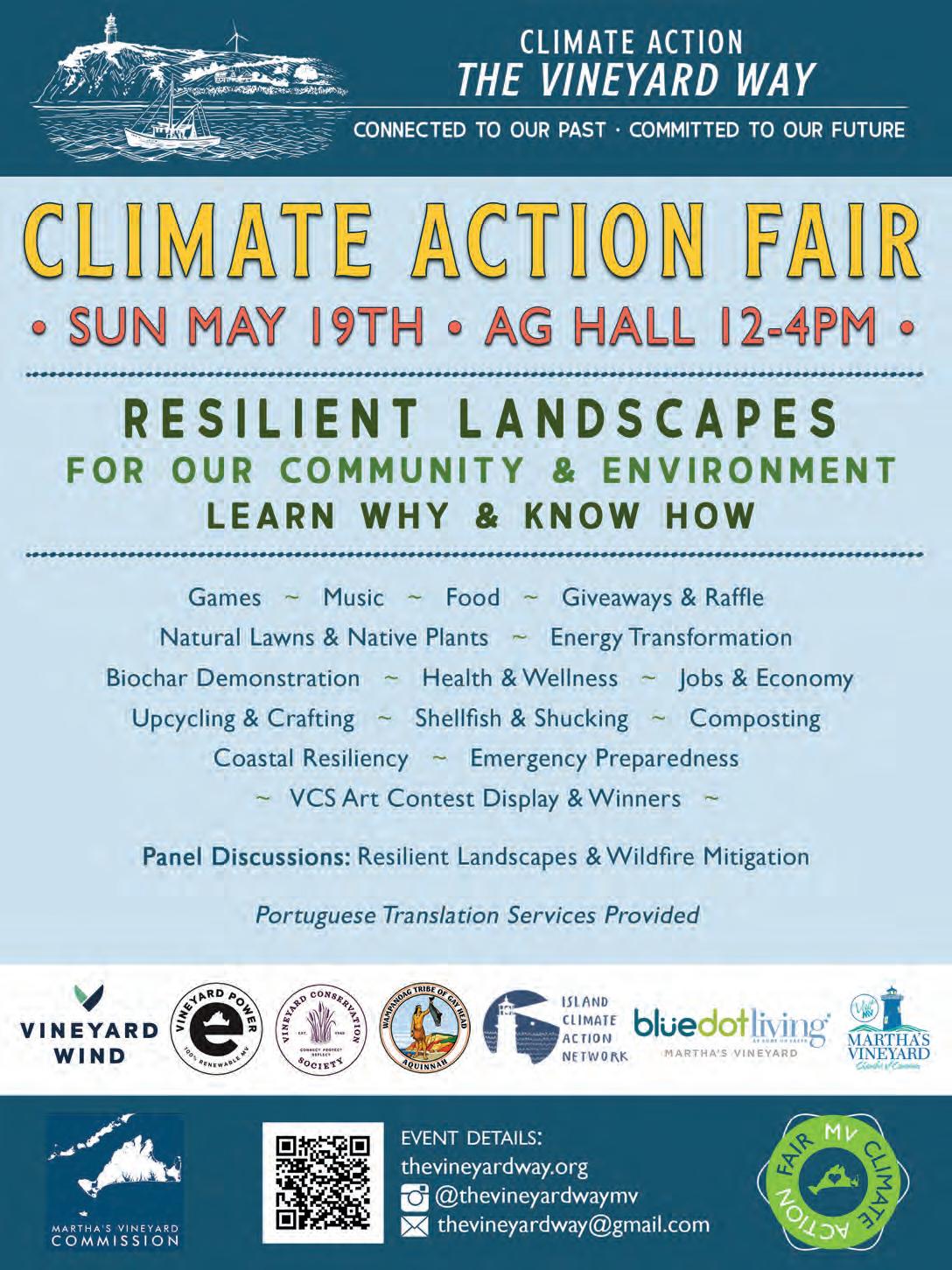
BDL 5 marthasvineyard. .com
Morning Glory Food Truck: Fresh From the Farm
Local produce is the main attraction of this beloved food truck and farmstand.
Story and Photos by Lucas Thors
Ever since its founding by James and Deborah Athearn in 1975, Morning Glory Farm has been known for its fresh local produce, which it sells exclusively here on the Vineyard. It’s no secret that Morning Glory’s tomatoes, zucchini, apples, pumpkins, corn, and more are sought-after ingredients for meals that aim to go above and beyond. But the prepared food that Morning Glory makes (using its own, farm-grown ingredients) is also widely popular, and with the

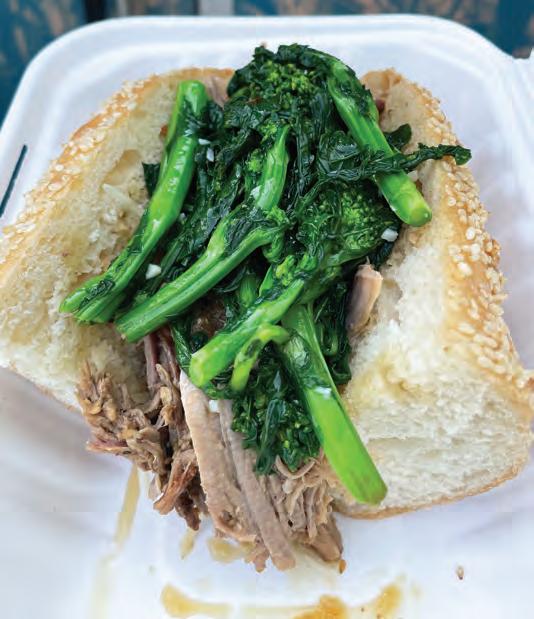
addition of the MoGlo Food Truck, there is now yet another way to enjoy fresh produce.
About two years ago, after Morning Glory Chef de Cuisine Douglas Williams moved to the Island, he and other food professionals at the farm wanted to make something that would satisfy visitors in the busy summer season, but would also stick around in the off-season to provide year-rounders with tasty variety. After gathering a small crew, acquiring a food truck, and parking it directly adjacent to the farm stand parking lot (its permanent home), the farm debuted the MoGlo Food Truck in summer of 2022 with a Fourth of July pulled pork trial run. A crowd of people showed up to try Chef Williams’ pork, but the large turnout for the initial event was only a preview of how popular the food truck pop-ups would become.
“For breakfast, lunch, and dinner, we try to use as much from the farm as we can. It’s all based on the seasonality of our produce.”
–Douglas Williams, Morning Glory Chef de Cuisine
The fresh produce MoGlo grows is the highlight of both their farmstand and food truck. Whether it’s cabbage, zucchini, strawberries, or apples, all the fruit and veggies that farmers grow is harvested and brought back to the vegetable barn by field crew manager Ryan Hassell and his team. Each piece is washed, packed, and prepped for sale or for use in the kitchen and food truck.
Hassell, who started in 2018 as a field hand, said he has
MOGLO FOOD TRUCK • UPFRONT 6 MARTHA’S VINEYARD /SPRING 2024
THE
The bok choy sandwich from the MoGlo Food Truck.
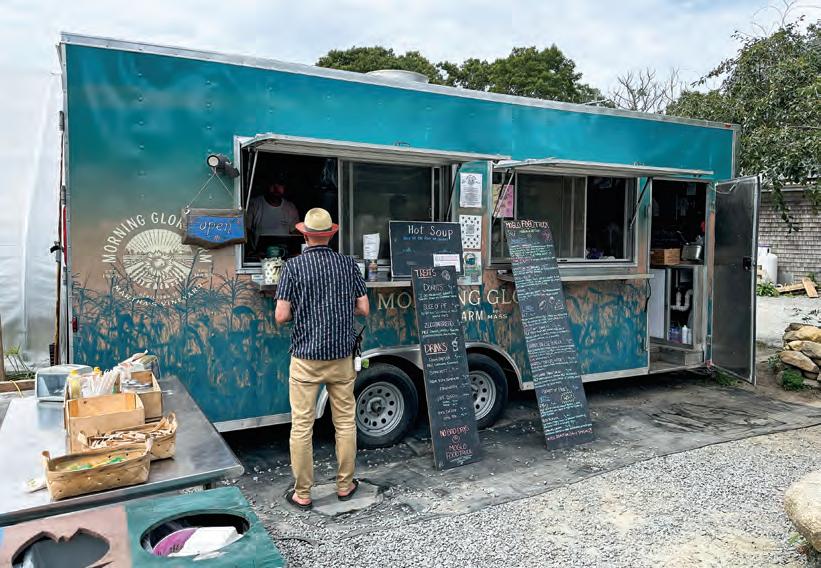
learned a lot about growing great food over the years. “I basically provide everyone with all the tools and guidance they need to go out into our fields and get the job done,” Hassell said.
For Hassell, being able to both stock the farmstand and provide Williams and executive chef Augustus Paquet-Whall (who’s responsible for making the prepared foods sold at the farmstand) with the ingredients they need to make their dishes is always a challenging yet enjoyable puzzle to piece together. “There

are often obstacles that can come up during the growing season — torrential rains, or animals like deer or geese that can wipe out an entire crop virtually overnight,” Hassell said. “We have the farmstand and the food truck, but we also have to provide food for our wholesale market and the CSA program, so there is a lot of demand for what we grow.”
Apart from tomatoes, potatoes, squashes, and leafy greens, Hassell said he enjoys growing the broad array of herbs that cooking staff use to enhance their culinary creations: thyme, rosemary, and a whole lot of basil. While MoGlo might be best known for its corn, Hassell said he is equally proud of other homegrown foods, like bok choy and spinach. “Doug will use the bok choy for his Asian pop-up, and he’s doing baked russet potatoes for the pop-up this week, so we’re happy we can provide that,” Hassell told me when I visited. While each food truck pop-up is unique, some pop-ups, like the Asian-themed night featuring a pork and bok choy sandwich on a sesame roll, are so successful that they become recurring events.
It can be challenging for farmers to know what produce
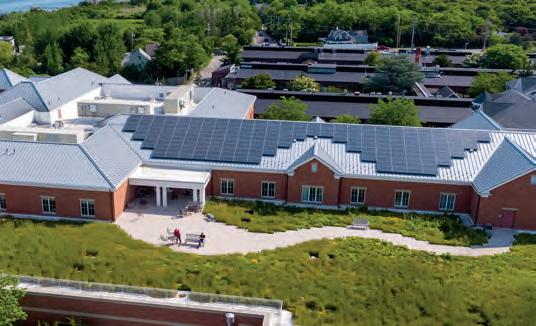


7 marthasvineyard. .com
Martha’s
Taking the LEED In
At Martha’s Vineyard Hospital, we believe a healthy Island starts with a healthy environment. www.mvhospital.org UPFRONT • MOGLO FOOD TRUCK The MoGlo Food
has a ton of farm-fresh ingredients included on the menu. JOIN US FOR LOCAL NEWS, LOCAL FOOD, AND TIPS FOR LIVING MORE SUSTAINABLY SIGN UP FOR OUR BI-WEEKLY NEWSLETTER marthasvineyard.bluedotliving.com
Vineyard Hospital is committed to the highest standards of environmentally sound building practices.
2011, shortly after the new hospital was completed, MVH was awarded Gold certification by the U.S. Green Building Council’s Leadership in Energy and Environmental Design (LEED) program. From bio-retention areas aimed at capturing, treating, and controlling stormwater runoff to the use of energy efficient systems such as photovoltaic solar panels, MVH is dedicated to the protection of precious Island resources.
Truck


DEER, TICK & MOSQUITO CONTROL!
(508)627-2928 | MV@oh-DEER.com oh-DEER.com/locations/MV
• SAFE FOR YOU, YOUR FAMILY & PETS!
• KILLS TICKS & MOSQUITOS ON CONTACT.
• AN EFFECTIVE ‘GREEN’ ALTERNATIVE TO PESTICIDES & CHEMICALS
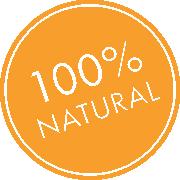
ohDEER offers you and your family a proven and safe solution to control ticks and mosquitoes so that you can enjoy your yard. Our products are true all-natural repellents that contain no pesticides or chemicals of any kind.
to save for the off-season, and how much. But by constantly communicating with the chefs about what they anticipate for the fall and winter, and by freezing and storing the necessary produce, Hassell is able to stock enough food to keep the kitchen and the food truck running off hyperlocal produce well into the cold season. “It’s gratifying, because they are always telling me how much better our own produce is than anything else they could possibly get,” Hassell said.
“You can see the difference between those fresh greens and something store-bought right away, and you can definitely taste the difference.”
–Douglas Williams
Williams, who grew up in New York City, has extensive experience working with different types of food from around the world, which helps when it comes time for him to dream up another creative pop-up for the food truck. “When we did the Bolognese and lasagna pop-up, I hand-rolled all the noodles,” Williams said.
For the first part of the fall and winter, the food truck is in its usual spot at the farm from 7 am to 2 pm, Thursday through Sunday. In late January, the truck shut down its regular hours of operation and continued hosting weekly pop-ups each Saturday.
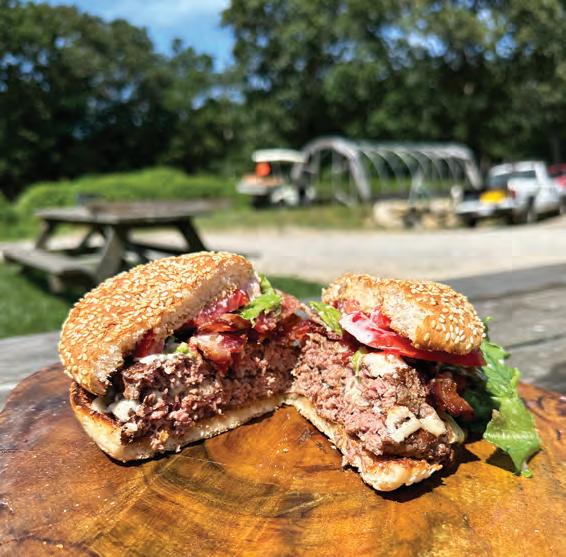
MOGLO FOOD TRUCK • UPFRONT 8 MARTHA’S VINEYARD /SPRING 2024
ENJOY MORE TIME
OUTSIDE!
A juicy MoGlo burger with all the fixings.

Their breakfast sandwiches use farm-raised eggs served on MoGlo bread or a freshly-baked biscuit. “For breakfast, lunch, and dinner, we try to use as much from the farm as we can,” Williams said. “It’s all based on the seasonality of our produce.” This means that Williams’ ingredient options are based on what’s just been harvested, what’s left in the freezer, and what other larger regional farms with more backstock have to offer (for when fresh MoGlo food dwindles).
MoGlo vegetables are in high demand year-round, so when the lettuce, arugula, and other leafy greens run out, the farm uses Massachusetts greens to supply their farmstand and food truck operations. Littleleaf Farms, a larger-scale hydroponic lettuce farm in Devens, is a go-to for MoGlo during the offseason. Little Leaf Farms grows so much lettuce that they have stores of it throughout the year. Williams has high praise for their crisp and sustainably-raised baby lettuce — “You can see the difference
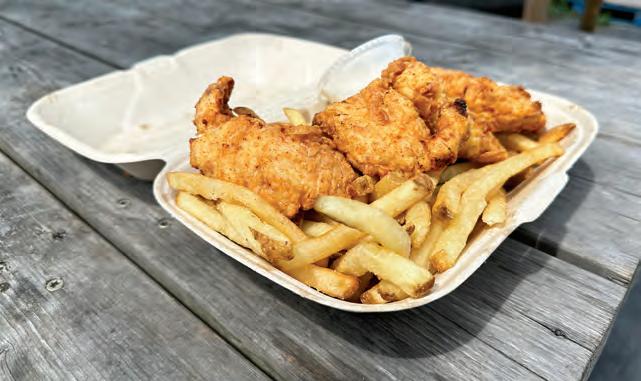


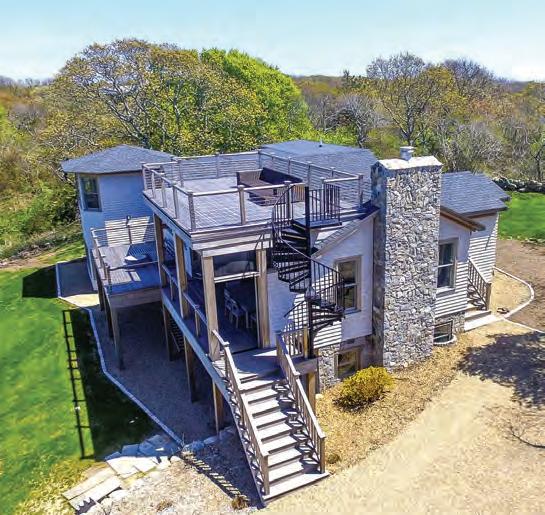
Webster’s Dictionary defines “cooperation” as: “operating together to one end; joint operation; concurrent effort or labor.’’ This accurately describes VINEYARD HOME IMPROVEMENTS’ culture and approach to every project. Our staff recognize the importance of partnership, and the ability to work as a team, as well as the necessity of being fair and flexible.

• Experienced in all phases of residential and commercial building construction.
• Skilled Craftsmen
• Design & Value Engineering
• Team Approach
Equipped to handle the more complex multi-story/multi-unit new projects, yet agile enough to execute the smaller jobs with the same degree of professionalism.
MOGLO FOOD TRUCK 9 marthasvineyard. .com
VINEYARD HOME IMPROVEMENTS INC. RENOVATION · RESTORATION · NEW CONSTRUCTION REQUEST A FREE ESTIMATE SERVICES EDGARTOWN . MA 508-560-5054 · idoimprovements@gmail.com Founded by Gustavo M. Lioncio Over 20 years of experience www.vhimprovements.com
A BLT from the MoGlo Food Truck comes with fried green onions and MoGlo lettuce.
Chicken tenders brined overnight and breaded with MoGlo buttermilk.
between those fresh greens and something store-bought right away, and you can definitely taste the difference,” Williams said.
For BLT fans, the food truck BLT uses fresh and frozen tomatoes from the farm, along with MoGlo lettuce and MoGlo bread. Williams said one of his favorite regular menu items is the burger, and although MoGlo doesn’t raise their own cows, they always source their beef from responsible ranchers in Massachusetts. “We try not to use as much beef, because it’s not as sustainable as some other meats, but the burger is really popular and really delicious,” Williams said.
The popular MoGlo Food Truck pop-ups also integrate local produce whenever possible.
Williams recalled the Oktoberfest pop-up they put on featuring braised MoGlo cabbage and baked MoGlo russet potatoes with all the fixings that drew throngs of hungry locals. To help Islanders recover from a night of celebrating New Year’s Eve, Williams and his crew hosted a pancake breakfast on January 1, with pancakes made from MoGlo pumpkins and heaping sides of homemade corned beef hash and breakfast sausage.
Wintertime provides the perfect opportunity for Williams to try out new and innovative ways of preparing all the fresh ingredients he can get his hands on. Williams is excited to bring back his Asian noodle bowl pop-up, with warming pho and ramen. “[When] we did the Asian noodle bowl special in the summer, it was incredibly popular — we almost didn’t have
INDIGO FARM
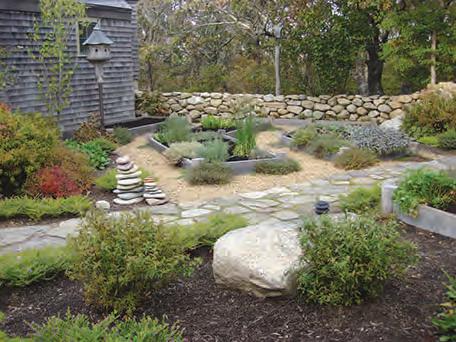

enough to go around,” Williams said.
The eggplant banh mi is another hugely popular menu item that uses farm-grown eggplant, and with such a rich harvest of different winter squashes, hot soups are always on the food truck menu and sold inside at the farmstand. “This kind of cooking isn’t pretentious, it isn’t overpriced, and it’s all made using really fresh ingredients,” Williams said. “I love seeing people’s reactions when they try a new dish at one of our pop-ups, or even just take a bite of a breakfast sandwich or our chicken fingers.”
Find the MoGlo Food Truck hours and popup schedule here: morninggloryfarm.com/food-truck-2






Landscapes inspired by the spirit of the Vineyard
MOGLO FOOD TRUCK • UPFRONT 10 MARTHA’S VINEYARD /SPRING 2024
Landscape Design • Lawn & Garden Maintenance Native Plants • Perennial & Vegetable Gardens Flower & Herb Pots • Organic Methods • Brush Cutting Pruning • Chipping • Pools • Stonework • Bobcat Services www.indigofarm.com
Landscape Design, Build & Maintenance 508.696.6114 info@indigofarm.com
Did you know that Bluedot Living is on Social Media? Follow us to have the best of Bluedot Living and more delivered straight to your feed. @BLUEDOTLIVING
Hippie Head Chef is an experienced meat smoker.


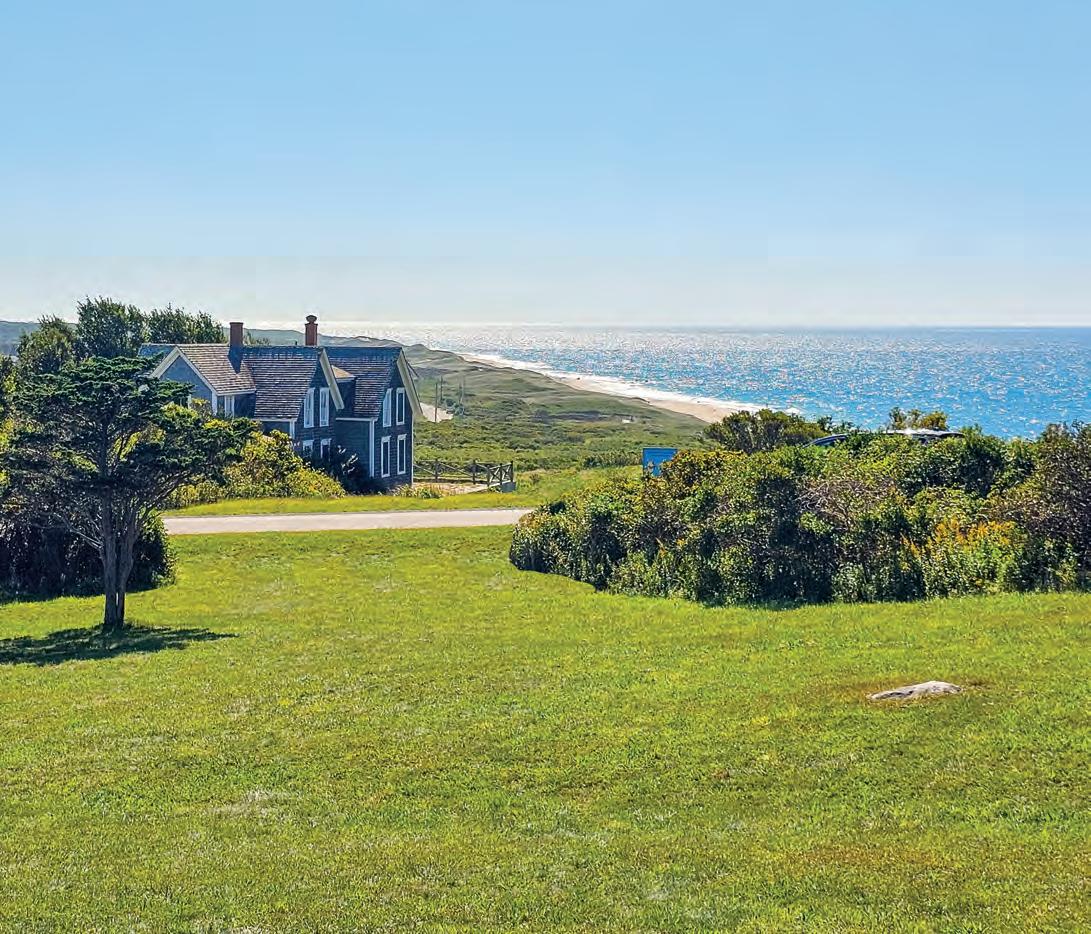





BDL WORKING TOGETHER FOR A CLEANER ENVIRONMENT FOR ALL YOUR COMMERCIAL EV TRUCK NEEDS AVON, MA / NORTH SMITHFIELD, RI · 508-427-6524 netrucksolutions.com AUTHORIZED NEW ENGLAND DEALER FOR REBATES AVAILABLE TEST DRIVE OUR TRUCKS CALL FOR MORE INFO
DISPATCHES From All Over
Lived By the Sea: Plastic Sharks and Coveted Dragons
By Reshmi Chakraborty
On February 13, 1997, a huge storm near the coast of Cornwall, U.K., pushed sixty-two containers off the cargo ship Tokio Express. One of these containers held five million pieces of the popular children’s toy, Lego. Coincidentally, many of the Lego pieces were ocean-themed — octopuses, sharks, mermaids, and, ironically, life jackets. Twenty-six years later, the pieces are still turning up all over the Northern Hemisphere, in locations as diverse as Galveston Island, Texas; the coastal town of Zandvoort in the Netherlands, and Tracey Williams’ favorite beachcombing spot in Cornwall.
Williams is the founder of Lego Lost at Sea (facebook. com/LegoLostAtSea), a project that combines citizen science, Anthropocene archaeology, oceanography, design, and community awareness to address the issue of plastic pollution in the ocean. On the Lego Lost at Sea Facebook page, more than


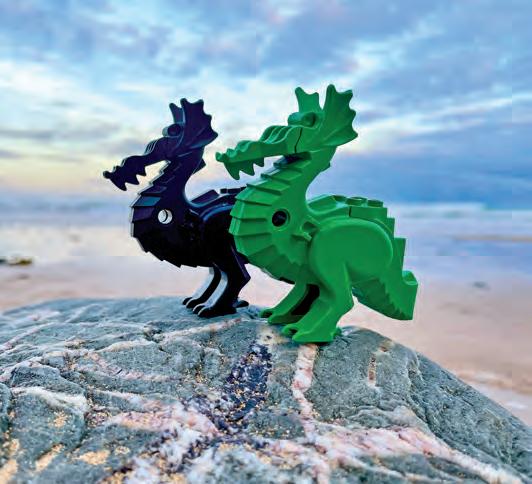

DISPATCHES • UP FRONT 12 MARTHA’S VINEYARD /SPRING 2024
BECAUSE THERE ARE SOME REALLY BIG IDEAS IN OTHER SMALL PLACES. Support Us Today! Your support of Bluedot Living enables us to shine a light on how to live more sustainably, plus: • Publish more stories spotlighting climate action. • Discover recipes and waste-saving kitchen ideas. • Introduce you to eco-friendly goods. • Highlight local changemakers. • Share green tips and tricks. Visit: Bluedotliving.com/support-us
CONNECTING THE (BLUE)DOTS
Bluedot Living founder Victoria Riskin
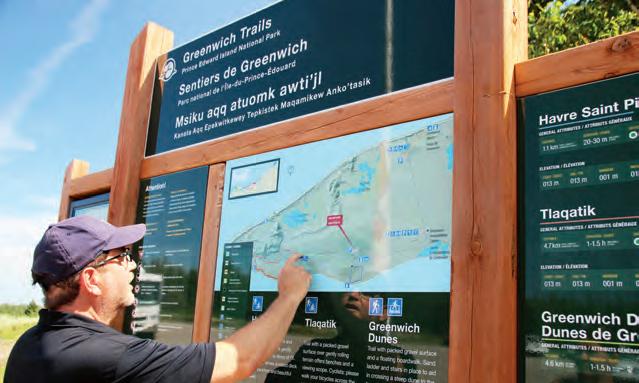
75,000 members share their beachcombing finds and turn the task of cleaning up the ocean into an exciting treasure hunt.
“Ultimately it opened my eyes to the rest of the plastic in the sea and sand,” Williams says. “When your eyes are down, searching, you start to notice the rest of the debris polluting the coastal environment.” When Williams first started picking up plastic items from beaches, she assumed that their presence was fairly recent. “But the more you delve into it, the more you realize how long some of the plastic has been lying at the bottom of the sea or buried in sand,” she says. “Some of the plastic we pick up is sixty to seventy years old — toothbrushes, curtain rings, bottles.”
On Martha’s Vineyard, read about the “Plastic-Free MV” kids who work to help rid the Island of plastic: bit.ly/Plastic-freeMV
Do you know someone making something cool out of discarded trash or plastic? Write us at editor@bluedotliving.com
High Tech Helps Prince Edward Island Prep for Climate Change
Prince Edward Island, Canada
By Darcy Rhyno
Dr. Adam Fenech is working with his University of PEI graduate students to protect this small, island province of Canada from the effects of climate change. The Centre for Climate Change and Adaptation on Prince Edward Island (PEI) is an ultra-modern, carbon-neutral, wood-and-metal clad structure that generates its own geothermal and solar power. The nearby PEI National Park is a series of coastal strips that serves as an outdoor classroom where students and staff conduct course work, collect data, and study the impacts of climate change on coastal landscapes (as well as on the wetland, field, and forest ecosystems behind them). “PEI is particularly vulnerable, because we’re essentially a big sand bar,” says Fenech, adding that the island faces multiple threats: higher temperatures, more frequent and more powerful storms, sea level rise, and coastal erosion.
“We have so much data, drone technology, and virtual reality,” Dr. Fenech says. “We’re going to try and address climate change utilizing the most advanced technologies we have.” Based on the center’s research, PEI government officials have created changes in land use and construction policy. New buildings must be situated 100 feet or sixty

OUR CONNECTIONS RUN DEEP
UP FRONT • DISPATCHES 13 marthasvineyard. .com
mvbank.com Member FDIC | Member DIF
On our one-year anniversary as the first B Corporation certified bank in Massachusetts, our deep connections to community, local business, and environment continue to inspire our mission of banking as a force for good. Connect with us today.
times the rate of erosion from the water. The eastern town of Souris built a breakwater to protect a causeway from erosion. Now, the changes in tidal action are actually building up the shoreline. Dr. Fenech calls this “future-friendly thinking” that takes natural forces into consideration when planning adaptation strategies.
Here at home, we’re lucky to have all hands on deck when it comes to future-friendly thinking, including MVRHS students working with Felix Neck’s Climate Summit (see that story here: bit.ly/High-school-Felix-neck).
Turning to Indigenous Knowledge
Okitipupa, Nigeria
By Chidinma Iwu
In Africa, climate change is testing centuries of accumulated and evolved indigenous knowledge. The methods, so far, are holding up. Nigeria's rains have been heavier than usual in recent years — too intense for root and tuber production; too severe, really, for any crops at all — but the farmers in Okitipupa aren't worried. Their indigenous practice of using mound mulching to combat the impact of floods has saved them numerous times in the past. When the rains come hard, they’re ready.
Africa is highly vulnerable to the effects of climate change. But regions populated by indigenous people are often the most
climate resilient. Applying Indigenous and Local Knowledge (ILK) — born out of their lived experiences — helps them sustain soil and crop health while adapting to new climate developments. “As the climate changes, indigenous people are responding accordingly,” says Dr. Bridget Bwalya, a researcher in the Department of Geographical and Environmental Studies at the University of Zambia.
For example, in Southern Africa, ILK of fire prevention helps the government mitigate the impact of wildfires, says Dr. Rhoda Kachali, a former researcher with Zambia’s Department of National Parks. Fighting fire with fire is one valuable method. In Mali, Indigenous people set off controlled fires in dry, fire-prone vegetation to create what’s called a seasonal mosaic — a strategy that protects the landscape against more disastrous fires later in a season. In the Sahel, indigenous people use controlled pastoral fires to prevent wildfires; they use ILK to forecast the weather by monitoring bloom periods and the behaviors of birds and other animals to inform the timing of their burns. In Zambia, locals plant fire-adapted crops like the Eucalyptus and Banksia, which produce large quantities of seeds when fire occurs in order to replenish themselves afterward.
Read aboutTraditional Ecological Knowledge (TEK) among the Wampanoag: bit.ly/TEKmv, and this story about The Nature Conservancy’s controlled burns in Katama: bit.ly/TMC-burns
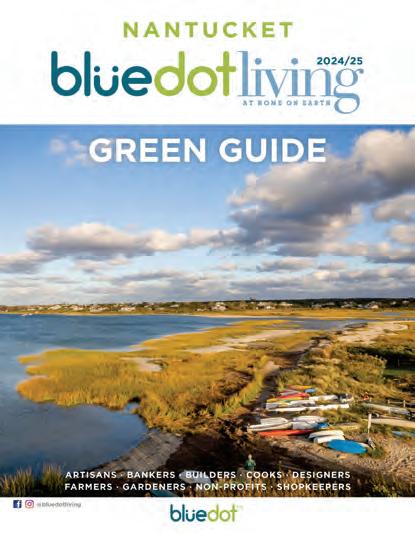





DISPATCHES • UP FRONT 14 MARTHA’S VINEYARD /SPRING 2024
Contact adsales@bluedotliving.com to reserve a space in our publications! Reach 100,000+ eco-conscious readers on Nantucket and Martha’s Vineyard Introducing our 2024/25 NANTUCKET Green Guide, website, and biweekly newsletter. Plus four annual MV issues (and the MV Green Guide). 1/2 PAGE VERTICAL 1/4 PAGE FULL PAGE

Pollenteers Build Pollinator Habitats
Asheville, North Carolina
By Daniel Walton
Since becoming the country’s first Bee City USA affiliate in 2012, the local government of Asheville, North Carolina has worked in collaboration with nonprofits and volunteers to plant pollinator habitat on city-owned land. Phyllis Stiles is the director emerita of Bee City USA and created
the program to encourage civic leaders to get behind the conservation of native bees and other pollinators.
On Asheville’s greenway, the gardens and meadows provide a perfect example of ongoing community engagement. Volunteers with Asheville GreenWorks — Stiles calls them “pollenteers” — water and weed the plantings, making sure they continue to serve as good habitats for pollinators. “With all the traffic from the public coming by, it’s a huge educational opportunity, and it inspires the whole community,” says Stiles of the public gardens initiative. “What we’re trying to get people to think is that every single inch of land can be a pollinator habitat, as long as you don’t use pesticides and you have native plants.”
Since Asheville joined Bee City USA, the program has expanded to include 370 municipalities and college campuses across forty-six states, Puerto Rico, and Washington, D.C. Affiliates commit to actions like incorporating pollinatorconscious practices into their policies, hosting pollinator awareness events, and enhancing pollinator habitat.
So many Vineyarders working to create pollinator pathways on the Island; check out Tom Chase’s Wild Idea for your backyard (bit.l y/Tom-Chase) and BiodiversityWorks’ Natural Neighbors program (bit.ly/natural-neighbors).
To see more dispatches from all over go to bluedotliving.com/ bluedot-climate-dispatches/

UP FRONT • DISPATCHES 15 marthasvineyard. .com
Volunteers stand by educational signage installed at a pollinator habitat in Asheville's River Arts District.
—Photo courtesy of Asheville GreenWorks
THE MARTHA’S VINEYARD Climate Action Fair
Last year's Climate Fair featured a panel on the waste stream.
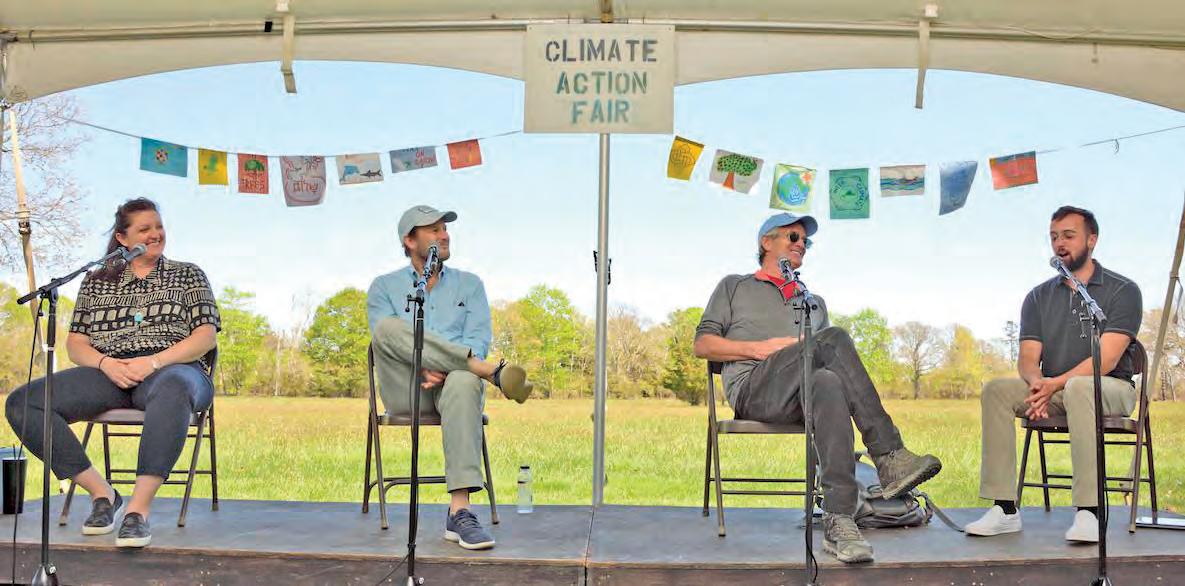





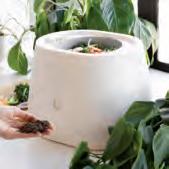




CLIMATE ACTION FAIR • GREENING VINEYARD LANDSCAPES 16 MARTHA’S VINEYARD /SPRING 2024
Sign up for Bluedot Living’s BuyBetter Marketplace, a biweekly newsletter that navigates the confusing world of stuff. Shop the BuyBetter Marketplace Buy less, but when you do — buy better.
PHOTO BY LISA VANDERHOOP
How can Vineyarders have a stronger and more sustainable relationship with the land? (Hint: Resilient roads, regenerative agriculture, native plant species in your backyard.)
On Sunday, May 19, from noon to 4 pm, the Martha’s Vineyard Commission’s 2024 Climate Action Fair (at the Ag Hall) will provide the most up-to-date and actionable answers, and materials to take home. This year, the MVC is offering materials in Brazilian Portuguese as well.
The Climate Action Fair was created after Island planners, local government officials, and other members of the community got together to create the Island Climate Action Plan, also known as “The Vineyard Way.” It outlines possible solutions to impending environmental and economic challenges. Island organizations working in the climate change sphere will be set up in the main hall with table displays and hands-on demonstrations based on the themes of the plan. These include land use, natural resources, and
biodiversity; transportation, infrastructure, and waste; public health and safety; food security; and economic resilience.
This year, the MVC is using grant funding from the Massachusetts Municipal Vulnerability Preparedness program to explore some of the barriers
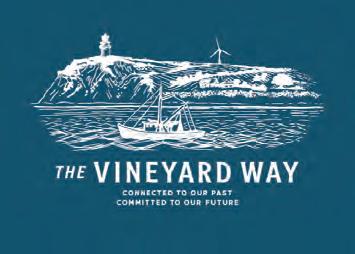
to resilient landscaping, and provide the public with access to essential resources. The project has enabled the commission to host ongoing focus groups with landscapers, landscape architects, and nursery owners that will be the basis for broad community outreach.
Similarly to last year’s Down and Dirty Waste Panel, a number of experts will discuss and answer questions about why the resilient landscaping project was created, and how the commission is using grant funding to bring the entire Island into the conversation. Another panel at the fair will revolve around wildfire dangers and how to prevent them.
MVC Climate Change Coordinator Liz Durkee said one of the project’s core goals is to encourage people to use more native species in their yards and gardens, and start to rethink what the ideal Vineyard lawn looks like. “Of course, at the CAF, ‘resilient landscaping’ will also focus on all the other landscapes,” Durkee said. “The human, economic, and renewable energy ones, for instance.”

For more info in the coming weeks visit thevineyardway.org. Come by and see us at the Bluedot Living table at the fair, and look for more coverage about the topics presented there in future newsletters and magazines.
– Lucas Thors
Garden Angels

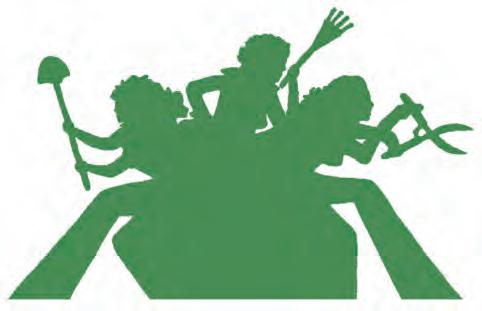
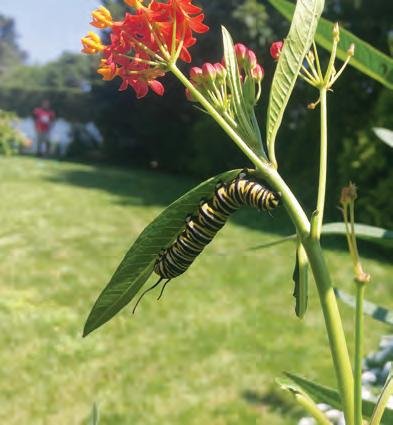
17 marthasvineyard. .com GREENING VINEYARD LANDSCAPES • CLIMATE ACTION FAIR
Native plant specialists and environmentally focused organic garden practices. Design • Installation • Maintenance (508) 645-9306 www.vineyardgardenangels.com
Bring beauty to your property
dot DEAR

Dear Dot, I like to wear fragrance. Is there a company that will make me smell great but has healthy ingredients for both me and the planet?
– Bobbi
Dear Bobbi, Spritzing on your signature scent before you leave the house is luxurious, confidence-boosting, and — carcinogenic? As you mention, the ingredients in your perfume bottle might really stink — there may well be some dark secrets lurking in your perfume bottle.
If you’ve ever checked out the ingredients on a bottle of perfume or cologne — or for that matter any number of scented products from shampoo to detergent — you might have noticed one ingredient simply labeled “fragrance.” Well, it turns out that there are over 3,000 chemical ingredients that could be included in the “fragrance,” but there are no current laws in the U.S. requiring manufacturers to list fragrance ingredients. The EU, on the other hand, requires the individual labeling of certain ingredients listed as allergens when they appear in concentrations greater than 0.001 percent
in leave-on products and greater than 0.01 percent in rinse-off products. And among these fragrance ingredients are some harmful chemicals that have been linked with endocrine disorders, cancers, and other adverse health effects.
According to a story in the Guardian, “more than 1,200 fragrance chemicals currently in use have been flagged as potential or known ‘chemicals of concern,’ according to a 2018 report from [Women's Voices for the Earth]. These include seven carcinogens, 15 chemicals prohibited from use in cosmetics in the EU, and others cited in various international warning lists.” Of particular concern, the article notes, are endocrine disruptors, which mimic human hormones. Those, researchers warn, can harm us even in small doses.
Canadian environmental organization the David Suzuki Foundation reports that “Environment Canada is currently assessing one synthetic musk (moskene) under the government’s Chemicals Management Plan and has flagged several others for future assessment. Health Canada recently announced regulations banning six phthalates in children’s toys (including DEP), but the use of DEP in
cosmetics is unrestricted.” DEP is diethyl phthalate, widely used in fragrances to make the scent last longer.
According to a 2018 study, “Fragranced consumer products, such as cleaning supplies, air fresheners, and personal care products, are a primary source of indoor air pollutants and personal exposure.” The study found that 34.7 percent of people exposed to fragrance products reported adverse health effects, such as migraines and respiratory issues.
The Environmental Working Group (EWG) found that 75 percent of products that list the ingredient “fragrance” contain phthalates, which have been linked to hormone disruption, reproductive harm, and cancer. And your favorite fragrance may not just be unhealthy for you — those synthetic chemicals affect our air quality as well.
So without a mandate on ingredient transparency, how can you verify that the perfume you want to buy is free of such harmful synthetic chemicals?
If the ingredient label on your product just lists “fragrance,” you might want to be wary, because you don’t know exactly what’s in the fragrance. If the ingredient label offers more elaborate information,
DEAR DOT 18 MARTHA’S VINEYARD /SPRING 2024
Illustration Elissa Turnbull
that could be an indication that the product isn’t hiding harmful chemicals. But Dot gets dizzy just looking at all of the unfamiliar ingredient names. And it’s a full-time job to research each one.
This is where clean cosmetic databases will come in handy — where it has literally been someone’s job to examine the ingredients for us and flag those of concern. Check out databases like Think Dirty (thinkdirtyapp.com) or EWG’s Skin Deep (ewg.org). Simply type in the product name, and these databases will tell you what data is and isn't available, and will conjure up a list of ingredients and their potential health effects.
Dot urges you to do some digging into those sources. But also, my motto is, “why take chances where better options exist?!” So here are a few suggestions that pass Dot’s smell test to get your clean fragrance journey started:

The 7 Virtues
Let Dot briefly wax poetic about The 7 Virtues (bluedotliving.com/7-VirtuesMV), an aromatherapy clean perfume company. I adore their scents and the company’s ethos (woman-owned; supports small farmers around the world rebuilding after war or natural disaster). And I promise anyone who wears The 7 Virtues scents that people will trail you, demanding to know what scent you are wearing — they are that tantalizing. (Incidentally, Dot’s current fave is Santal Vanilla.)
This brand received a 1 (low hazard) from Skin Deep. This is the best possible rating.
Henry Rose
This company (bluedotliving.com/HenryRose-MV) offers fragrances for men and women, and is EWG certified.
Just the Goods
You’ll find a few options for perfume oils by this brand (justthegoods.net) on Skin Deep, and better yet, they are EWG certified.
Rosy and Earnest
This brand (rosyandearnest.com) offers just two scents — one each for men and women. They are also EWG verified.
Scent is so personal, Bobbi. But once you’ve found a fragrance absent those nefarious synthetic chemicals, you won’t have to worry that there’s something notso-beautiful behind that gorgeous scent. Fragrantly, Dot

Check out our Daily Dot newsletter and get a Climate Quick Tip each weekday, and an answer from Dot each Saturday. On Sunday, Dot rests. Sign up here:

DEAR DOT 19 marthasvineyard. .com
Embrace a GREENER journey with The Martha’s Vineyard Transit Authority! VTA HAS GONE GREEN! 8 Solar Carports that generate power for bus charging 17 Electric Buses 3 Electric Mini Buses Energy Storage System VTA provides clean transportation for the Island Community and powers the transition to a sustainable future with ELECTRIC BUSES !
Cruisin g
With Currier
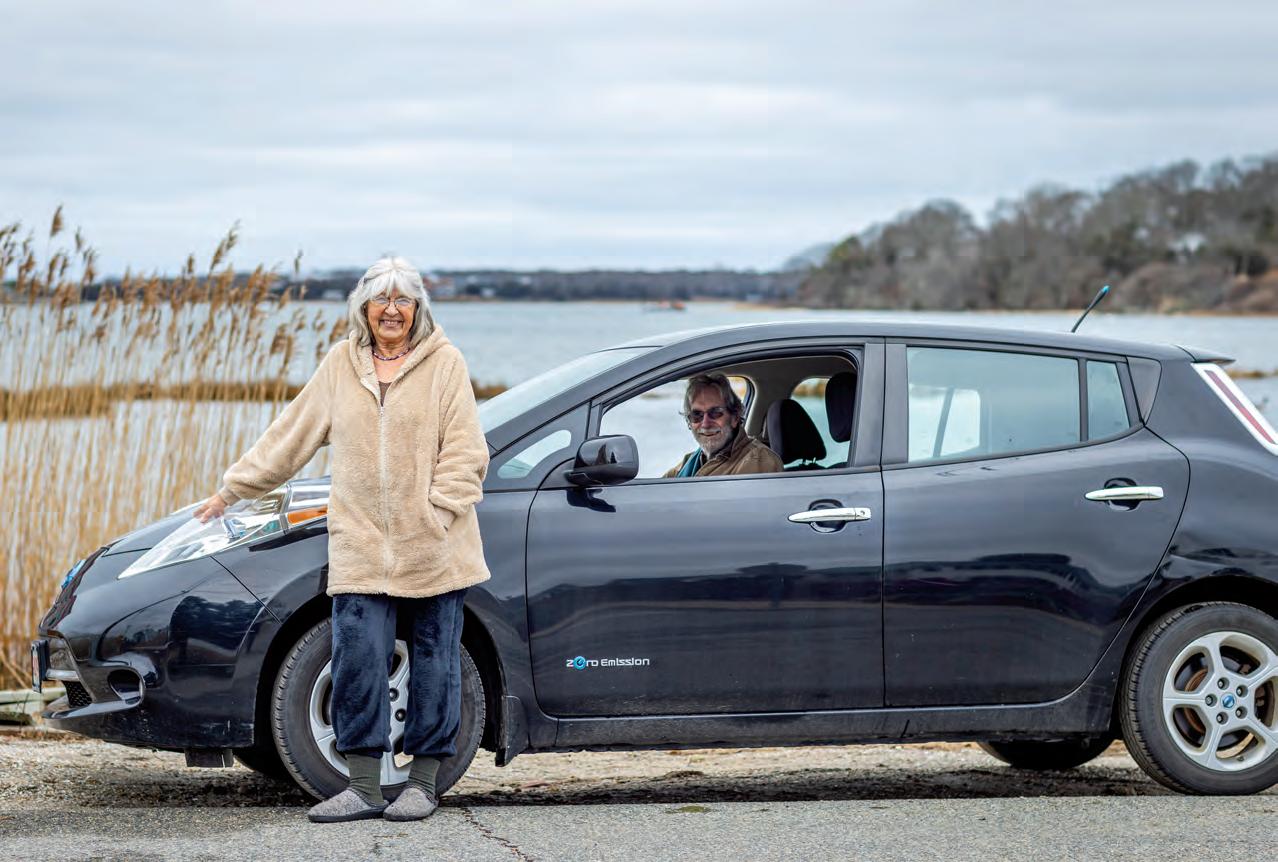
ANNA EDEY AND HER NISSAN LEAF
VVineyard resident and noted solar designer, Anna Edey, picked me up at my house in Oak Bluffs in her 10-yearold Nissan Leaf. We drove to her house on Skiff Avenue in Vineyard Haven, which she will soon be converting to be totally solar powered and energy selfsufficient. (More about that in a followup story in Blue Dot, later this year.)
Now in her mid eighties, she filled me in on some biographical details of her life. Born and raised in Sweden, Anna was traveling through Europe with her family in her late teens, when she heard the sound of boogie-woogie piano music wafting out of a little cafe in the Montmartre neighborhood of Paris — an event that would eventually lead to a profound change in her life.
Written by Geoff Currier Photos by Randi Baird
She and her family went into the cafe to check out the music. There, they met a young man (who had also been drawn in by the music) who turned out to be a summer resident of Martha’s
Vineyard by the name of Mait Edey. A recent graduate of Princeton University, Mait had come to Paris to write and live on a houseboat on the Seine. He and Anna struck up a
In 1971, Mait and Anna bought thirteen acres of the Norton farm in West Tisbury, where Anna hoped to build a sustainable farm (called Solviva), where they could grow their own organic food and eventually convert to solar energy and reduce dependence on heating oil and propane.
20 MARTHA’S VINEYARD /SPRING 2024
The founder of Solviva drives Currier to Vineyard Haven.
CRUISING WITH CURRIER • ANNA EDEY
Anna was also an early adopter of electric vehicles.
In 1994, she bought an all-electric car from a gentleman in Gay Head who had converted it from an old 1981 Honda.
relationship and would later go back to Sweden, get married, and move to the U.S. in the late 1950s. It took a while for Anna to adjust to life in the U.S., since it trailed so far behind Sweden environmentally. “There was smoke belching out of chimneys, and trash everywhere, and all these enormous cars,” she recalled.
In 1971, Mait and Anna bought thirteen acres of the Norton farm in West Tisbury, where Anna hoped to
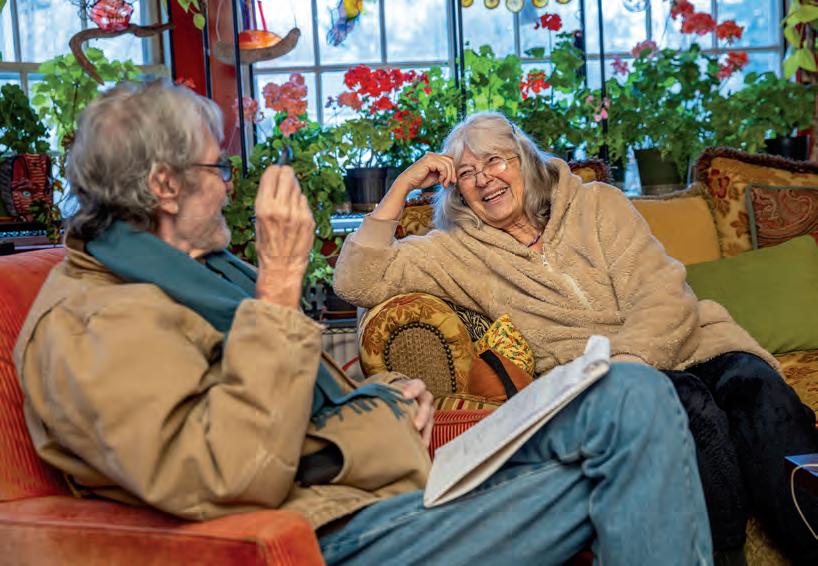
build a sustainable farm (called Solviva), where they could grow their own organic food and eventually convert to solar energy and reduce dependence on heating oil and propane. Anna even designed her own non-polluting waste water management system.
In 1974, Anna and Mait separated, and Anna stayed on at Solviva. In 1979, the house burned down, and Anna became even more committed to living sustainably, and learning how to live
Anna loves Leafs so much, and found such a great deal, that she bought two.
with only solar energy, and this became her life's work. She’s currently building a new home on Skiff Ave. that’s fully solar heated, without the need for any heating oil or propane.
As might be expected, Anna was also an early adopter of electric vehicles. In 1994, she bought an all-electric car from a gentleman in Gay Head who had converted it from an old 1981 Honda, with the option for full refund if it did not provide reliable transportation. It
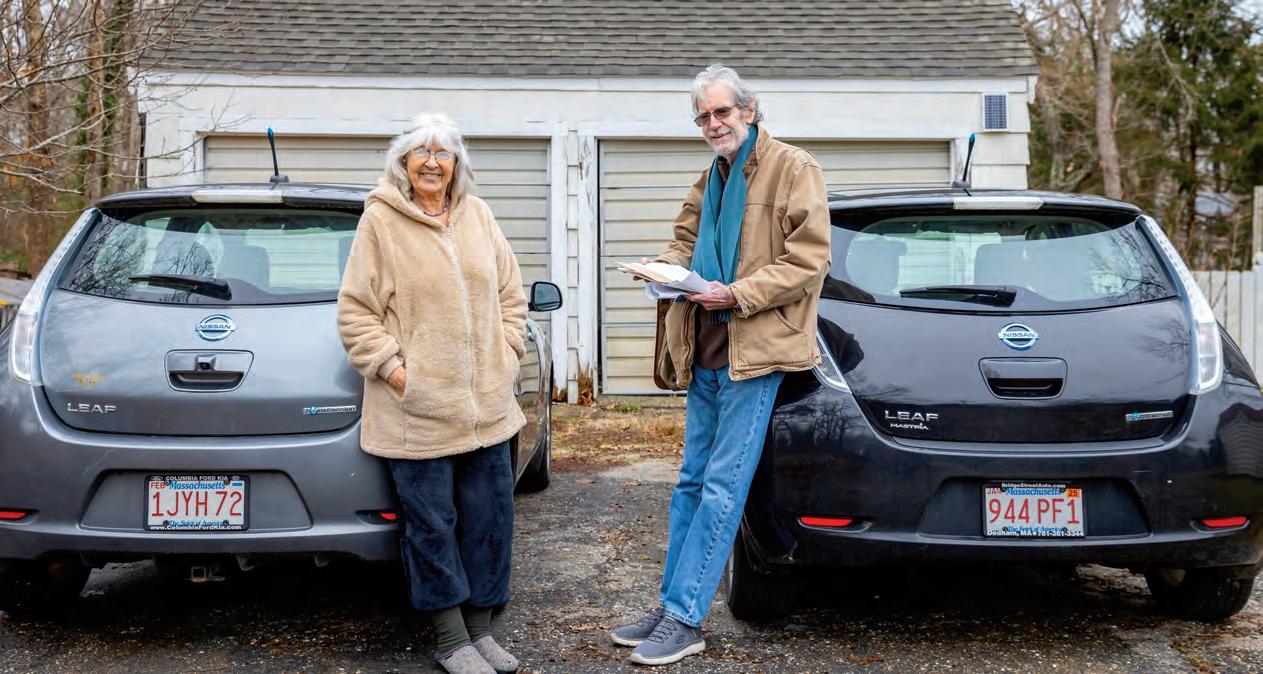 Geoff visits with Anna Edey in her living room.
Geoff visits with Anna Edey in her living room.




CRUISING WITH CURRIER • ANNA EDEY 22 MARTHA’S VINEYARD /SPRING 2024
best price,
what
bargain it was,
found
bought
selling
hasn't bought a gallon of gas since she bought
first Leaf
years ago. Sign up for our bi-weekly newsletter! boston.bluedotliving.com ADVICE · LOCAL NEWS · FOOD/RECIPES · CLIMATE NEWS HOME & GARDEN · MARKETPLACE CHECK OUT OUR BOSTON BLUEDOT LIVING SITE AND NEWSLETTER! BOSTON
Seeking one with the best battery and the
she found a used 2014 Leaf selling for $10,000. Realizing
a
she
and
one more — a 2013
for $9,000. Anna
her
eleven
The Facts
Vehicle type: Front-wheel-drive, 5-passenger, 4-door hatchback.
Transmission: 1-speed direct drive.
Base Price: $37,445.
Nissan has announced that it will discontinue production of the Leaf in 2024 in order to focus on their new EV, the Nissan Ariya. But Anna points out that you can buy a used Leaf for around $10,000, and they last seemingly forever, so it’s not as if the Leaf is going to just fade away.
And if you need longer range, get a new long-range battery for it.
had too many flaws, so she returned it. After Nissan revolutionized the concept of the electric vehicle with the introduction of the Nissan Leaf in 2010, she bought a new 2012 Leaf. It far exceeded her highest hopes: For ten years, nothing ever went wrong with it, and in all that time, it didn’t require a single servicing.
Then, in 2022, her Leaf was sideswiped by another car, and to her immense grief was declared “totalled.” Anna knew she wanted another Leaf.
Seeking one with the best battery and the best price, she found a used 2014 Leaf selling for $10,000. Realizing what a bargain it was, she found and bought one more — a 2013 selling for $9,000.
“I haven’t bought a gallon of gas since I bought the original Leaf, eleven years ago,” she said. “And there has been zero servicing on the cars, except
tires, windshield wipers and washer fluid, because electric cars have so few moving parts relative to cars with internal combustion engines.”
Anna gets enough energy to charge the cars from just a regular 120 volt outlet. She simply plugs it in when she gets back home, and it’s fully charged in the morning.
She says there’s no need to spend $2,000 for a 220v charger, and also no need for a garage; her Leafs have always been fully exposed to the weather, and have always been 100 percent reliable. Nothing has ever gone wrong with them.
“It’s the perfect ‘Island car,’” Anna says; for long trips off-Island, she prefers to take the bus.

To purchase Anna Edey’s books, “Solviva” or “Green Light at the End of the Tunnel” contact her at solvivagreen@gmail.com
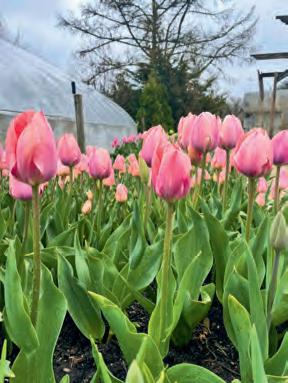
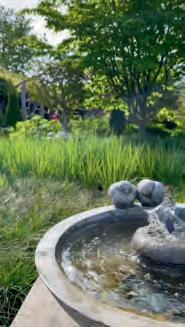


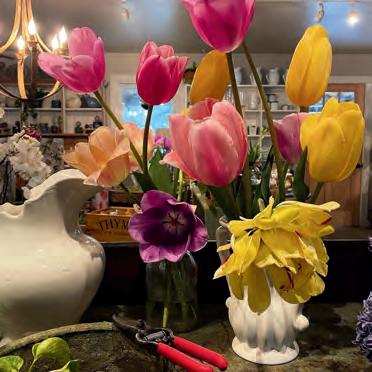
ANNA EDEY • CRUISING WITH CURRIER 23 marthasvineyard. .com
680 State Rd, West Tisbury, MA 02575 ∙ (508) 696-7600 middletownnursery@gmail.com ∙ middletownnurserymv.com Unique Nursery with Specimen Plants ∙ Botanical Shop Fresh Cut Flowers ∙ Beautiful Planters & Fountains

WHO IS VINEYARD POWER?
Born
from a living room conversation, the Island’s preeminent renewable power nonprofit is leading the charge in the energy transition.
BY LUCAS THORS
In the five issues of Bluedot Living Martha’s Vineyard in 2024, we’ll introduce you to Vineyard Power through these sponsored pages. In this issue, the Vineyard Power team explains how the organization was founded, and what spurred the need for a local renewable energy nonprofit. They clarify the relationship between Vineyard Power and Vineyard Wind, along with how the two organizations’ goals are aligned, and how they differ. The team also describes some of the work they’re doing now, with their Energy Transition Program, to help move the community toward one hundred percent renewable energy by 2040.
In 2009, when terms like “greening the grid” and “clean energy infrastructure” were gaining usage in the climate change conversation, a concerned group of Islanders formed Vineyard Power, hoping to make the community an active participant in the shift to renewable energy.
At the same time that federal, state, and local policy slowly started to move toward green energy, a small contingent of community members gathered to discuss how Martha’s Vineyard could play a real role. Director and President of Vineyard Power, Richard Andre, asked the critical question: “How are we, as an island, going to take on this challenge of creating a future that is not reliant on the burning of fossil fuels? That’s ultimately what led to our creation. It really all started with a conversation in Paul Pimentel’s living room.”
“How are we, as an Island, going to take on this challenge of creating a future that is not reliant on the burning of fossil fuels?”
to address the adverse effects of climate change in our community, the plan recommended establishing an electrical cooperative that would ensure that locals benefit from community-scale solar energy production, along with utility-scale offshore wind projects that were being explored by the federal government south of the Vineyard. We were watching Cape Wind as it failed [in 2015],” Andre said, “and we came to the conclusion that there were several reasons it did: One was that it was ahead of its time; another was that it was in the wrong location; but maybe the most important reason was that it didn’t involve the community.”
–Richard Andre, Director and President of Vineyard Power
That first get-together, according to Andre, galvanized the late Harvard engineer Pimentel, David Damroth, Suzi Wasserman, Sue Hruby, Andre, and several others, to establish Vineyard Power.
According to Andre, the Martha’s Vineyard Commission at the time was distributing its newly completed Island Plan — a comprehensive look forward into some of the most pressing challenges the community will face. Among other proactive measures
When the federal government announced that it would soon begin leasing swathes of ocean off Vineyard shores to develop wind farms, it was clear to Andre that the community needed a voice in the process. He also knew that existing electrical infrastructure would have to be rebuilt in order to accommodate the new forms of energy production. “Nobody fifteen years ago was focused on trying to electrify our buildings or transportation, because what good would it do electrifying those things when all your electricity is coming from fossil fuel sources, like coal?” Andre said. “The question was, how do you green the grid?” For Massachusetts,
• SPONSORED 24 MARTHA’S VINEYARD /SPRING 2024


offshore wind is the most abundant renewable energy resource, while solar, though less efficient, can be deployed locally with relative ease.
In January 2015, Vineyard Power and Vineyard Wind signed the nation’s first federally recognized offshore wind Community Benefit Agreement in the United States. The agreement delivered the local community a ‘seat at the table’ in the responsible development of offshore wind and ensured that a local, community-based organization could shape the ongoing discussion around wind energy. “It was all about envisioning the inevitable trend toward renewables, and wanting to be proactive in that debate — to get in on the ground level, influence outcomes, and secure benefits for the community,” Andre explained. For example, Vineyard Power, through the agreement, negotiated for new clean-energy jobs to be based on the Island. The agreement would also help fund much of Vineyard Power’s important education, advocacy, and development work, like no-cost energy coaching sessions for Vineyarders who are looking for advice on building mechanical systems, solar, electric vehicles, and income-eligible ratepayer assistance programs, as well as providing grant funds to towns and non-profits for solar and battery storage projects at critical Island facilities.
In January 2022, Vineyard Power launched the Energy Transition Program for Martha’s Vineyard, with support from the Martha’s Vineyard Vision Fellowship. The Program aims to educate and support residents, small businesses, and the building trades in the transition toward a 100 percent renewable energy economy, including an aspirational goal of a 100 percent reduction in fossil fuel use by 2040. These goals have been adopted by all six Island towns, as well as by the Martha’s Vineyard Commission. “This deadline runs parallel to the state’s 2050
goals. There is a big picture to look at. It’s happening here, but it’s also happening at a much broader level,” Andre said.
Vineyard Power Controller and Renewable Development Manager Luke Lefeber told Bluedot that while identifying and advocating for renewable energy resources is critical, simultaneously developing the necessary infrastructure to handle those resources is equally as important.
As an example, Lefeber stressed that our electrical infrastructure requires energy storage capabilities to address intermittency and resilience. “We must be able to provide power when generation from wind or solar is low. There needs to be distributed energy storage systems, such as batteries, that will capture excess energy when generation is high, but demand is low, then release that energy when demand is high or when there is a power outage,” Lefeber said.
In January 2015, Vineyard Power and Vineyard Wind signed the
nation’s first
federally recognized offshore wind Community Benefit Agreement in the United States.
As more renewable energy resources come online and electrical infrastructure continues to be improved, another one of Vineyard Power’s missions is to help people reduce their energy usage and ultimately save money. Last year, Vineyard Power and the towns on Martha’s Vineyard were selected by the Cape Light Compact to participate in the Mass Save Community First Partnership. Vineyard Power works through this partnership to help residents and small businesses participate in energy efficiency programs, which provide rebates and subsidies to better insulate buildings and transition away from fossil fuels. The first part of the process is working with Islanders to sign up for a no-cost energy assessment.
In 2023, Vineyard Power held over ninety outreach events on the Vineyard and has actively
Continued on page 63
SPONSORED • 25 marthasvineyard. .com
The Vineyard Power team, from left: Richard Andre, Sophie Pittaluga, Luke Lefeber, and Thamiris Marta.
THE ANCIENTS AMONG US
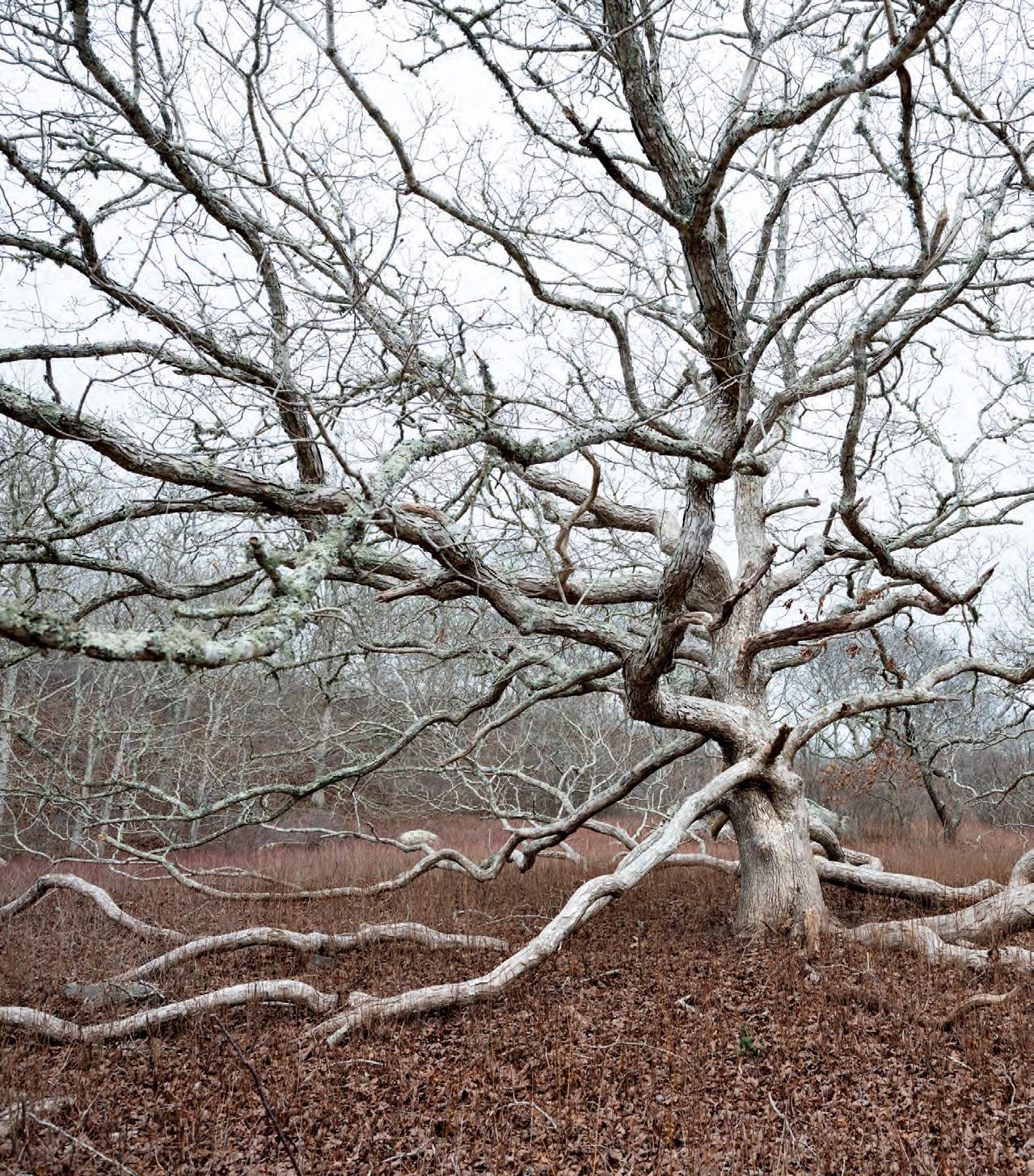
The Peaked Hill Oak, in Chilmark, was one of Brian Kelley's first favorites in his quest to memorialize the nation's greatest trees.
THE NATION'S CHAMPION TREES • FEATURE 26 MARTHA’S VINEYARD /SPRING 2024
Brian Kelley Photographs the Nation's Champion Trees
And the Vineyard's wind- and salt-hewn beauties.
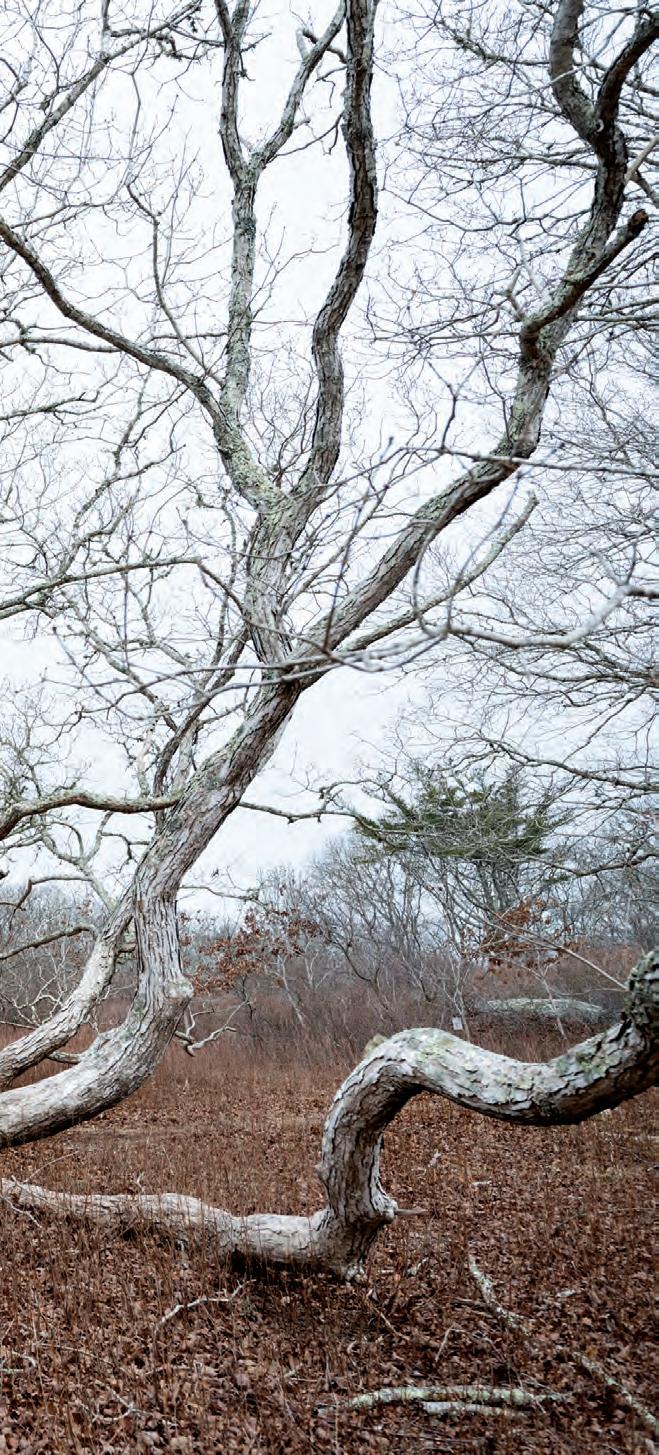
Photographer Brian Kelley is a tree detective. He scours the internet, searching message boards and online threads to discover the locations and histories of old trees across the country. Kelley is looking for Champion Trees — the oldest and largest of a species in the country — as well as other old trees with unique histories. While many of Kelley’s photographs feature massive old-growth trees from upstate New York and the Pacific Northwest, he has a particular love for the wind- and salt-hewn trees of Martha’s Vineyard. In 2017, his girlfriend brought him to the Island for the first time; a few years later, they got married here, and had their son on the Island. They haven’t yet been able to make the Vineyard their permanent home, but they visit friends, family, and the local forests often. “What I find awesome is the trees that are shaped by harsh conditions,” Kelley says of the unique Vineyard forests. “Whether it’s the high winds, the salt spray, or the coasts that don’t allow for super old growing conditions as far as soil quality, you get these stunted trees that are wind-grown and beautiful.”
“Whether it’s the high winds, the salt spray, or the coasts that don’t allow for super old growing conditions as far as soil quality, you get these stunted trees that are windgrown and beautiful.”
–Brian Kelley
“I fell in love with the oak tree at Peaked Hill,” he says of one of the precious Chilmark tree. “It’s one of my favorite photographs that I’ve ever taken of a tree.” He displays these photos on Gatheringgrowth.org — the website of the nonprofit Kelley started in 2017 to “visually preserve the legacy of trees and forests.” Each photo lists the tree’s name, general location, age, and other details. Characteristic of all his work, and in Kelley’s Peaked Hill oak photos, is a sense of invitation: branches spiral out, inviting our gaze inward toward its prolific trunk. The tree asks to be closely examined, and Kelley brings the tree to us. We need not climb the tree nor collect its bark residue between the treads of our boots in order to feel its presence and care about it.
Early in his quest to document Vineyard trees, Kelley connected with Adam Moore, executive director of the Sheriff’s Meadow Foundation and Tim Boland, the director of Polly Hill Arboretum, who shared the Island’s unique ecological history.
FEATURE • THE NATION'S CHAMPION TREES 27 marthasvineyard. .com
Story by Tessa Permar Photos by Brian Kelley
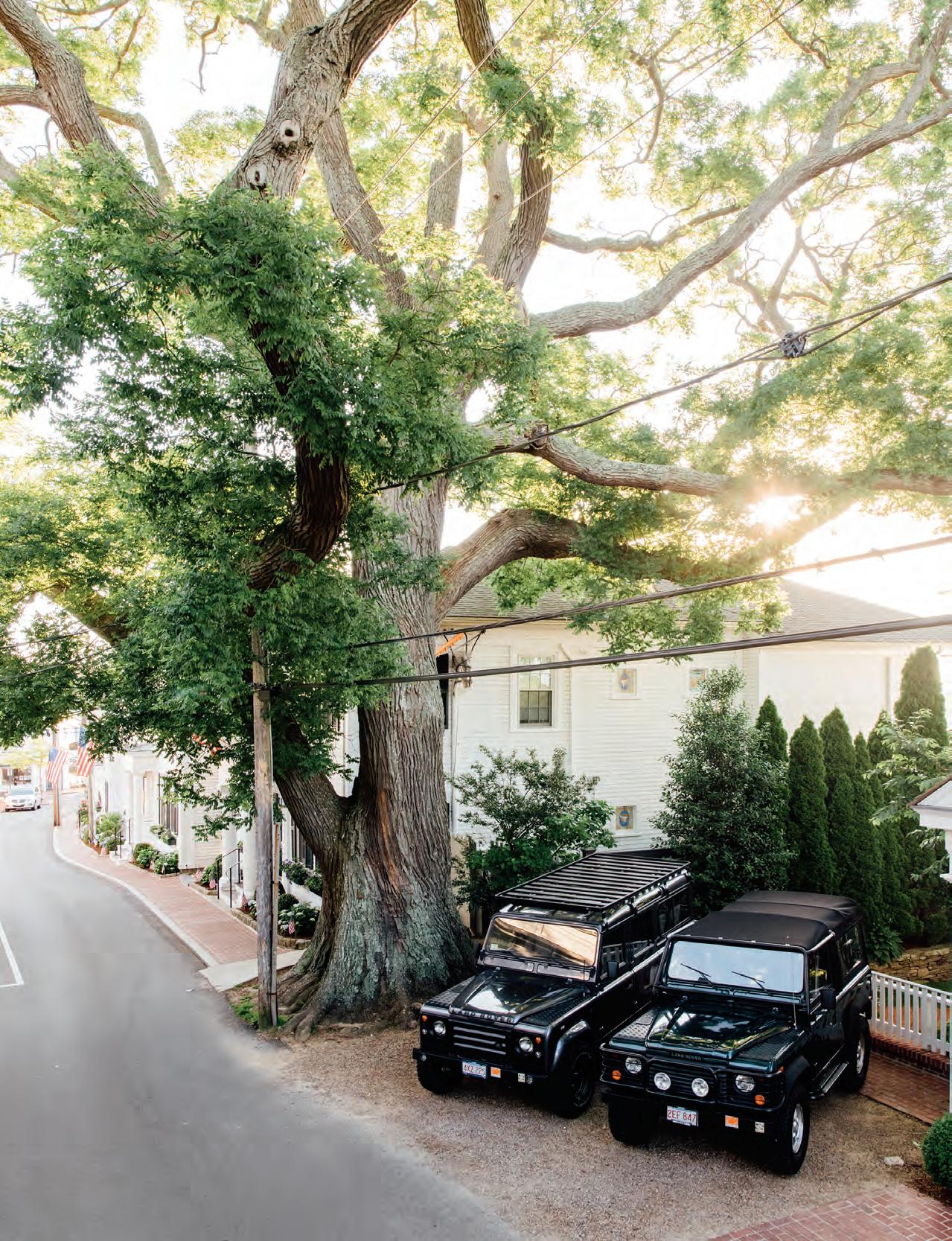
THE NATION'S CHAMPION TREES • FEATURE 28 MARTHA’S VINEYARD /SPRING 2024
The Japanese Pagoda tree on South Water Street has been saved by conservationists and is now the country's oldest.
Despite the Vineyard’s not-so-long-ago history of forest clearing on a massive scale, Kelley discovered some remarkable old and unique trees, contributing to their preservation.
On the opposite side of the Island was another remarkable Island tree: the Japanese pagoda tree in Edgartown. On an Island blanketed by young scrub oaks, the oldest Japanese pagoda tree in the country spreads its branches over South Water Street in Edgartown. With the help of the MV Museum, Kelley learned that in 1873, Captain Thomas Milton returned home from his international sea travels, bringing with him a seedling he’d picked up in China. Upon his return, he planted the seedling — then known as a Chinese Huai tree — beside his home in Edgartown. The tree thrived and grew, despite unfamiliar soil and, later, pavement laid across its roots. In 2014, the then-owner of the Milton property proposed a renovation which included a two-story garage located near the Japanese Pagoda tree. While his plans included steps to mitigate the impact to the tree, the people of Edgartown — alerted by an article in the Vineyard Gazette — rallied to halt the building process that could put the old tree at risk. The Edgartown conservation commission heeded the public outcry and prevented the building of the garage so close to the historic pagoda.
Kelley decided to document this tree and share its story. He photographed its leaves, trunk, and branches, as well as its home beside two sleek Range Rovers. He also collaborated with Ollie Becker

In 1873, Captain Thomas Milton returned home from his international sea travels, bringing with him a seedling he’d picked up in China. Upon his return, he planted the seedling — then known as a Chinese Huai tree — beside his home in Edgartown. The tree thrived and grew, despite unfamiliar soil and, later, pavement laid across its roots.
FEATURE • THE NATION'S CHAMPION TREES 29 marthasvineyard. .com
The Stagg Tree, in California's Tulare County, is recognized as the fifthlargest tree in the world. Firefighters saved it when the 2020 Castle fire destroyed parts of the forest around it. It is 243 feet tall.
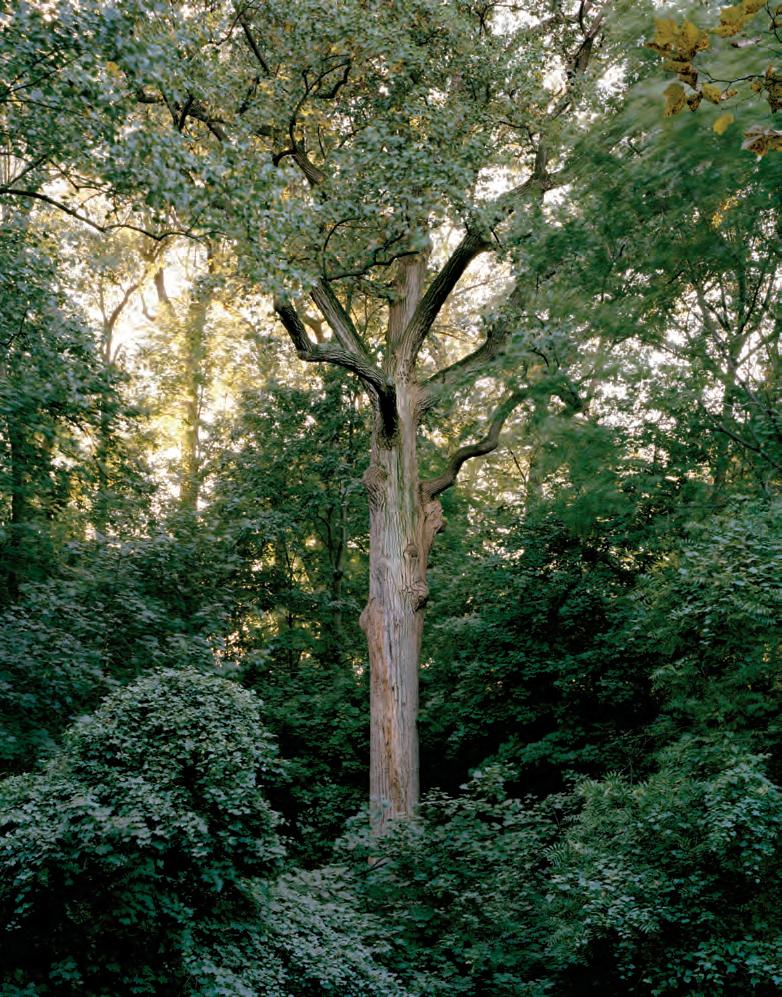
and the MV Film Festival (now Circuit Arts) to create a short film about the tree (see it here: bit.ly/EdgPagoda). “People react to things that have names or stories,” Kelley says. “It makes people care about it more. If that [Japanese pagoda] had no significance that people knew about, people wouldn’t fight for it.”
Kelley wasn’t always on a mission to photograph trees in order to protect and celebrate them. Uninspired by his heavy math and science course-load in high school in the small town of Horseheads,
New York, Kelley took what would become a life-changing multimedia class: “I had a great art teacher named Mrs. Malloy, and she taught us that nothing was ‘wrong.’ It was always, what did you think about to get to that point? Or what was your process here?” He fell in love with photography, which led him to the School of Visual Arts in New York City. He’d grown up skateboarding, and recalls that he “still wanted to somehow be part of the culture. So I started shooting photos [of
skateboarders]. For me as a kid in photo school, that was the first time I felt like there’s something here [as a career].”
Kelley managed to forge a connection with skateboarding icon and designer Keith Hufneigle, which opened the door to a successful and fast-paced career in commercial and still photography.
“Seeing these big trees in person simply stops you in your tracks. How is this real? How old is it? Why aren’t these trees everywhere?” –Brian Kelley
When he lived in New York City, Kelley discovered the photographer Robert Frank, who traveled the country documenting the people. Inspired by Frank’s journeys, Kelley carved out a couple of months to make his own way across the country. He discovered it wasn’t the people who drew his lens, but the forests. “I ended up in the Pacific Northwest, where I was able to see big trees for the first time in my life,” he says. “That was mindblowing. I felt really inspired.” Ablaze with curiosity and excitement, Kelley did some research and discovered American Forests, one of the oldest environmental nonprofits in the country. Founded in the 1940s, the organization created the Champion Tree program to collect archival images of the oldest
Brian Kelley stands next to a cucumber magnolia in Colonial Heights, Virginia, planted about 1718 in what became General Robert E. Lee's headquarters during the Civil War siege of Petersburg.
THE NATION'S CHAMPION TREES • FEATURE 30 MARTHA’S VINEYARD /SPRING 2024
Know as the "Queens Giant," this 133-foot tall tulip tree is located in a park in Queens, New York. It is about 400 years old.

FEATURE • THE NATION'S CHAMPION TREES 31 marthasvineyard. .com
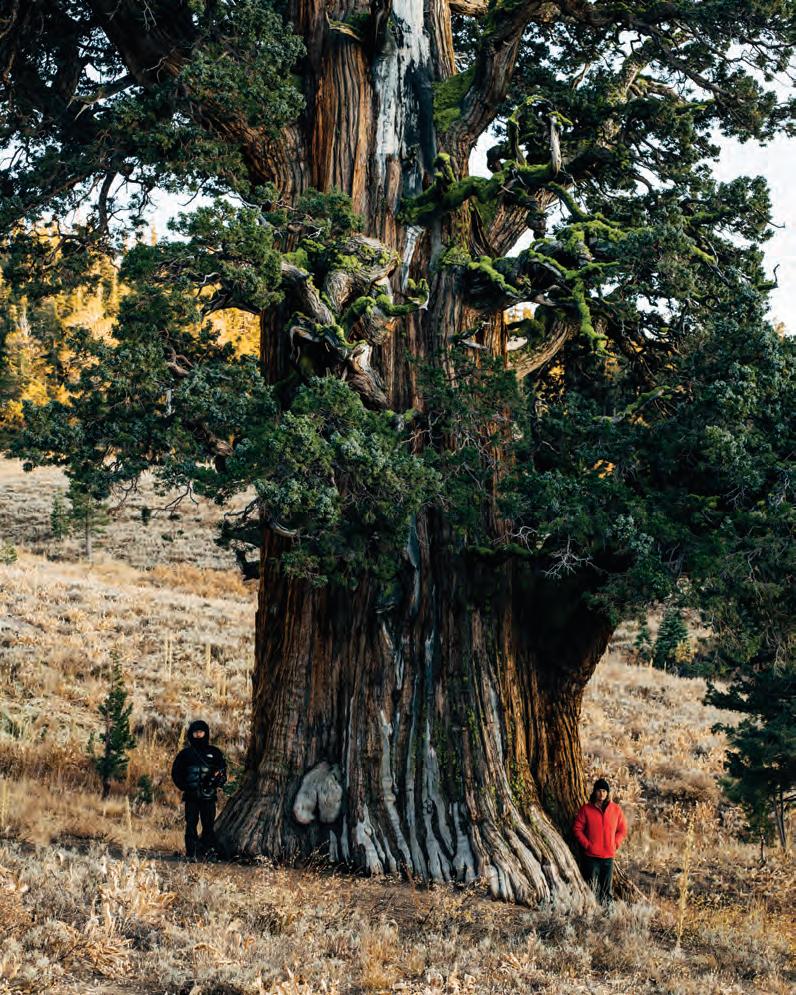
and largest specimens of every tree species in the country. Kelley noticed that many of their archival photos had been snapped by hikers on cell phones, so he reached out to American Forests to propose a professional photography project. American Forests didn’t have the resources to fund the project, but Kelly was undeterred: he eventually found a private donor who supported two years of travel in a Sprinter van, during which Kelley produced some of the most startling photographs of Champion trees to date.
On his website he’s written: “I remember the moment we arrived at the Olympic National Park in Washington State; immediately I felt this sense of calmness and peace wash over me. Being in the presence of towering spruce, fir, and cedars like I’d never seen before.
“Seeing these big trees in person simply stops you in your tracks. How is this real? How old is it? Why aren’t these trees everywhere? I remember coming to a complete halt when we saw the Hall of Mosses, a small pocket of big leaf maples with moss growing all over them. Not only did I feel physically and mentally refreshed but also walked away with a new-found curiosity for trees and forests around the United States. This experience has led me to where I am now, traveling the country, and documenting old growth.
“I've had the privilege of photographing trees as young as 50 years old and as ancient as 4,000 years old. There's something special about sharing this kind of information, like revealing that a tree began its growth before the Roman Empire.”
–Brian Kelley
After two years of documenting trees that met the narrow criteria of “Champion” status, Kelley felt he was missing opportunities to shoot other, equally important trees. “I [decided] to start Gathering Growth Foundation as a way to make the largest archive of the oldest and largest trees in the U.S.,” he says. And in 2019, that’s just what he did, enabling him to not only photograph the trees, but also to learn and share their stories.
Kelley visits his subjects many times throughout a day. He shoots with high quality film: “There’s a richness that comes through film, and a feeling, it’s almost unexplainable: the tones, the depth, the grain structure of film.” He also captures audio recordings of the space around the tree. And he has collaborated
THE NATION'S CHAMPION TREES • FEATURE 32 MARTHA’S VINEYARD /SPRING 2024
The Bennett Sierra juniper tree (with Brian standing to the left) in California's Stanislaus National Forest. The Bennett has a circumference of 481 inches.
on multiple short films that focus on these ancient and sometimes fragile trees. By telling the trees’ stories, he inspires viewers to want to preserve them.
When Kelley shares his work, he observes that viewers’ “primary fascination tends to revolve around the age of the trees. It's often the first thing they inquire about. I've had the privilege of photographing trees as young as 50 years old and as ancient as 4,000 years old. There's something special about sharing this kind of information, like revealing that a tree began its growth before the Roman Empire. And, of course, when you share the possibility that it might be the largest known of its species in the U.S. or the world, it adds an extra layer of wonder. I love sharing this information because I believe it creates a deeper connection between people and the trees or forests, inspiring a greater sense of care and appreciation.”
Kelley recounts a cautionary tale of Washington State’s Champion Sitka Spruce, the largest of its species in the world. In the 1970s, the tree was nearly 800 years old, and it was flourishing. But the tree grew so famous that enthusiastic visitors nearly killed the tree with accidental soil compression and root damage. When Kelley visited this spruce, he recorded serene silence at dawn, with no other visitors nearby. “And then I went back at 4 pm, and it’s like a zoo. It gives you this insight into what that tree most likely experienced for the first 780 years of its life.”
Kelley’s work allows tree enthusiasts and newbies alike to experience the wonder of these trees without the risk of harming them. “I’m not trying to be a gatekeeper to big trees, “ he says. “I want Gathering Growth to be educational, where someone can come and learn. For example, if I’m going to go and see this big tree, I’m not going to climb on it. I’m not going to spend too much time around the base.”
One of the biggest challenges for the Gathering Growth Foundation is finding financial support. Kelley’s work, while educational, exists in the somewhat rarified intersection
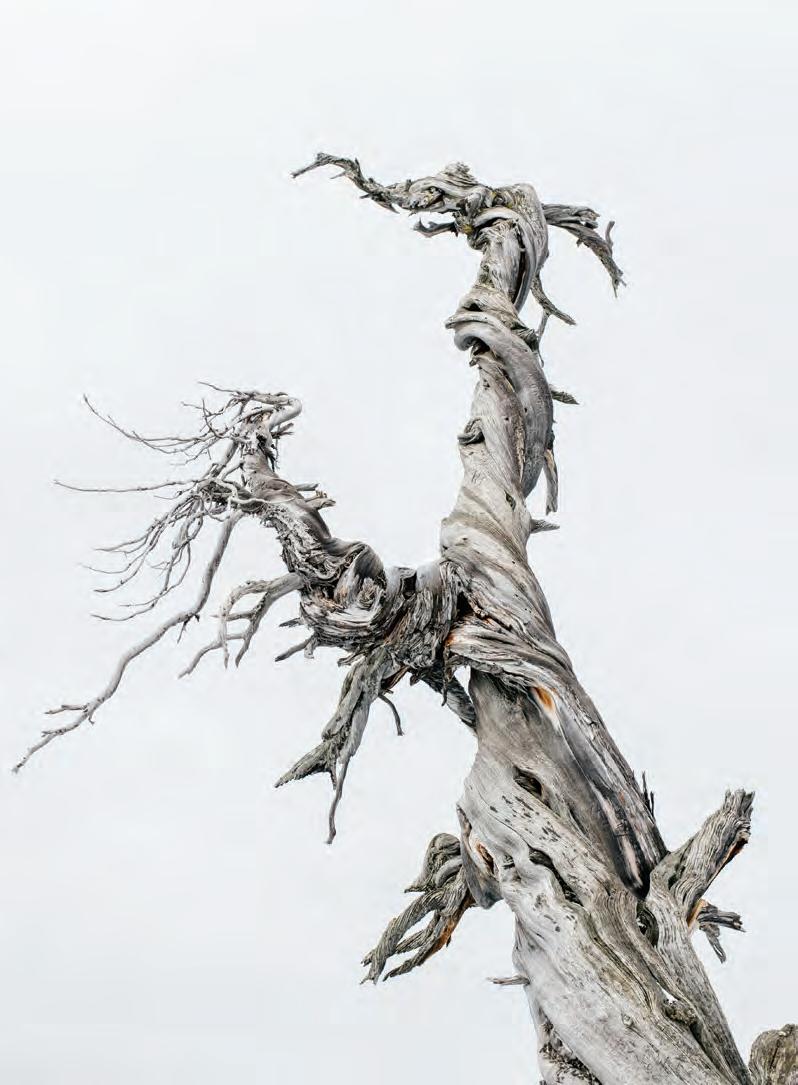
WHAT YOU CAN DO
Visit Gatheringgrowth.org
When visiting trees, don’t climb them, or spend much time around the base
Visit our trees: At Polly Hill Arboretum, Sheriff’s Meadow, Land Bank Trails. Find all Island trails at the trailsmv app on the App Store.
Utah's Jardine juniper is thought to be 1,500 years old.
of ecological preservation and art. But Kelley continues to forge ahead. Currently, he is working with two other tree experts to create a book of New York State’s largest and oldest trees. They work diligently and incrementally, tree by tree, frame by frame. It’s slow work, and in a world of viral clickbait, it can be difficult to continuously grow their audience. Their book of New York trees will not be a vehicle for instant gratification, but rather a work that contains all the dignity and awe of ancient forests.
Of Gathering Growth’s work in general, Kelley says, “Nowhere else does an archive like this exist. I think to date, I have documented over 500 trees and forests. And if I’m able and my body’s willing, I’ll continue for the rest of my life.”
It’s a nice line of work. His first visit to Cedar Tree Neck made an enduring impression, he says. “I immediately had this feeling of being in a special forest. The wind-shaped, stunted forest exuded character, with twisting branches of oak, sassafras, and beach — like nothing I had ever seen before.”

FEATURE • THE NATION'S CHAMPION TREES
33 marthasvineyard. .com
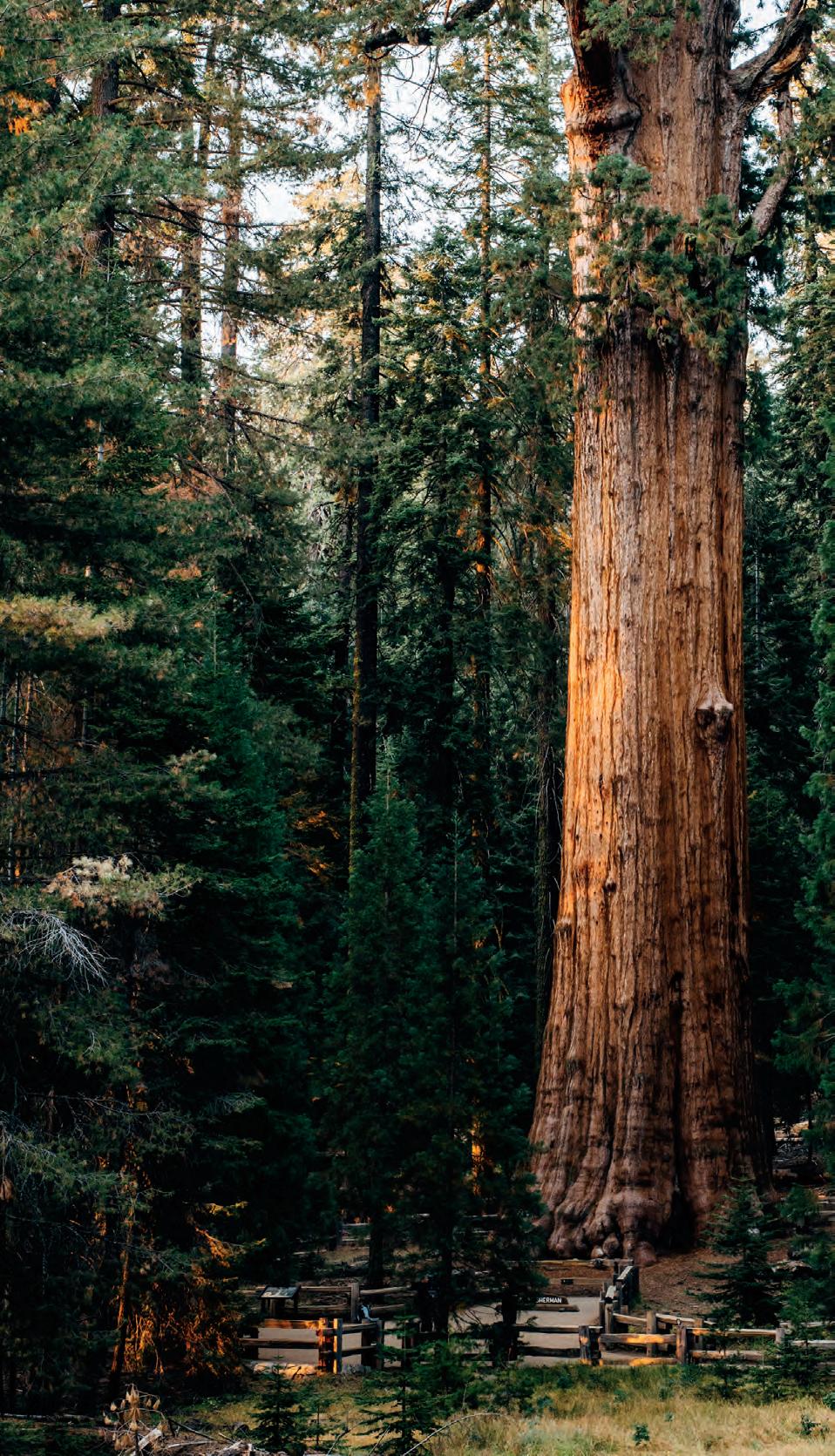
DOES THIS TREE
“Trees take care of each other. … Seeds remember the seasons of their childhood and set buds accordingly. … Trees sense the presence of other nearby life. … Trees feed their young and synchronize their masts and bank resources and warn kin and send out signals to wasps to come and save them from attacks. …
A forest knows things.”
–Richard Powers, The Overstory
The General Sherman is the largest known single-stem tree on Earth. It's located in Sequoia National Park, California.

DO TREES HAVE RIGHTS? • ESSAY 34 MARTHA’S VINEYARD /SPRING 2024
PHOTO BY BRIAN KELLEY
HAVE RIGHTS ?
THE NEW ANIMISM:
The goal is to preserve the natural world of the planet.
Story by Jack Fruchtman
In 2014, an algae bloom polluted Lake Erie so badly that local authorities advised residents in Toledo, Ohio, to avoid drinking tap water and bathing in a tub or shower. The pollution was so unhealthy that a group of citizens organized to bestow on Lake Erie the same rights as a legal person or corporation.
According to the Guardian, in 2019, the Lake Erie Bill of Rights granted “personhood status” to the lake in a referendum that passed with a majority of 61 percent. The citizens were recognized as “the guardian of the body of water” so it may “exist, flourish, and naturally evolve.”
The newspaper also reported that Ecuador declared that “all nature” possessed legal rights in an amendment to its constitution. New Zealand had earlier granted legal status to a forest and India to the Ganges and Yamuna rivers. Colombia did the same to the Amazon.
In 2022, science writer Elizabeth Kolbert reported in The New Yorker that a Florida lake was shrinking so badly under severe pressure by developers that it sued in Florida state court along with other endangered lakes to halt development. Their suit claimed development would “adversely impact the lakes and marsh who are parties to this action,” causing injuries that are “concrete, distinct, and palpable.”
Kolbert also reported that organizations like the Nonhuman Rights Group have gone to court to claim legal rights for Happy, an elephant who lives at the Bronx Zoo (she was named for one of the seven dwarfs). According to the group, because she could recognize her reflection in a mirror, she must possess sufficient self-consciousness that she should reside in an elephant sanctuary. The group filed a habeas corpus petition, seeking her release.
In June of 2022, the New York State Court of Appeals rejected the petition. The court noted that “while no one disputes the impressive capabilities of elephants, we reject petitioner’s arguments that it is entitled to seek the remedy of habeas corpus on Happy’s behalf. Habeas corpus is a procedural
vehicle intended to secure the liberty rights of human beings who are unlawfully restrained, not nonhuman animals.”
Kolbert noted that other cases have been brought by entire species. The Palila, a critically endangered bird, successfully sued Hawaii’s Department of Land and Natural Resources for allowing feral goats to graze on its last remaining bit of habitat. A judge ruled in 1988 that “the bird has legal status and wings its way into federal court in its own right.” The Palila “has earned the right to be capitalized since it is a party to this proceeding.”
Some use the term “new animism” to give a name to the ascribing of personhood to inanimate objects like rivers and trees and to nonhuman animals, a perspective becoming more mainstream. Derived from the Latin anima, the term refers to breath, spirit, soul, or life. Its origins lie in anthropology, going back to Edward Burnett Taylor’s nineteenth century study of Indigenous peoples, Primitive Culture: Researches into the Development of Mythology, Philosophy, Religion, Art, and Custom. It is now applied to nonhumans.
The goal of those who practice animism and support the rights of non-human natural entities is to preserve the natural world of the planet, now in a downward spiral of climate change and degradation: increased floods and wildfires, extreme temperatures of heat and cold, more and worse storms, air pollution. Supporters of the rights of animals, plants, bodies of water, and the like are seeking to prevent ecocide.
And what about trees?
Scientific investigations have demonstrated that trees communicate with one another. In an extensive account at the end of 2020, The New York Times Magazine reported that a scientist at the University of British Columbia, Suzanne Simard, “discovered that fungal threads link nearly every tree in a forest — even trees of different species. Carbon, water, nutrients, alarm signals, and hormones can pass from tree to tree through these subterranean circuits.”
Continued on page 59
ESSAY • DO TREES HAVE RIGHTS? 35 marthasvineyard. .com
WHY SETTLE FOR SOD?
My journey from unsuccessful lawn to wildflower meadow.
Story and Photos by Matt Pelikan
II tried. I really did.
We moved to the Vineyard in August 1997, buying our first-ever house, a modest Cape-style home on a flat, scant quarter-acre in Oak Bluffs. Having grown up in the 1960s and 1970s in the suburbs outside of Boston, I moved in fully expecting to shoulder the burden of conventional lawn care. In fact, no other option even occurred to me: A lush, green lawn fringed by colorful flower beds was the obvious goal. Right?
Accordingly, I watered, weeded, fertilized, dug, planted, pruned, divided, mulched, cultivated, edged, herbicided, and then watered some more. Each summer, I cut additions to the flower borders; each spring, I renewed the steadily expanding roster of ornamental beds and replaced plants that had succumbed to the Vineyard’s erratic winter weather. I mowed
the lawn, first with a human-powered, reel-style mower, then, as our finances grew slightly less precarious, with a fossil-fueled, rotary one.
The land, however, had its own ideas. The topsoil had been stripped from most of the lot for use at another project. The exposed subsoil, a dismal mix of sand and clay, was soggy in wet seasons and baked to imperviousness in dry ones. The hydroseeded lawn devolved into scattered, dejected clumps of grass, with taprooted weeds cheerfully monopolizing the bare soil between tufts.
Gradually, it dawned on me that I was engaged in an exercise of utter futility. The work I put in produced no permanent improvement. The lawn remained lumpy, the exotic ornamentals continued to languish, the non-native weeds continued to flourish. Each “improvement” I attempted came

Gray hairstreak butterfly, Strymon melinus, visits butterfly weed (Asclepis tuberosa) flowers in the author's yard.
THE BUGS IN MY BACKYARD • FEATURE 36 MARTHA’S VINEYARD /SPRING 2024
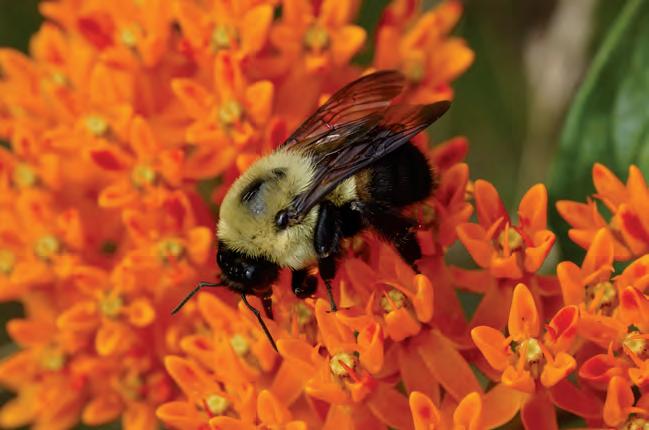
I was onto something. Butterflies visited the coreopsis flowers; later in the summer, goldfinches perched precariously on the flower stalks, winkling coreopsis seeds out of the dried heads.
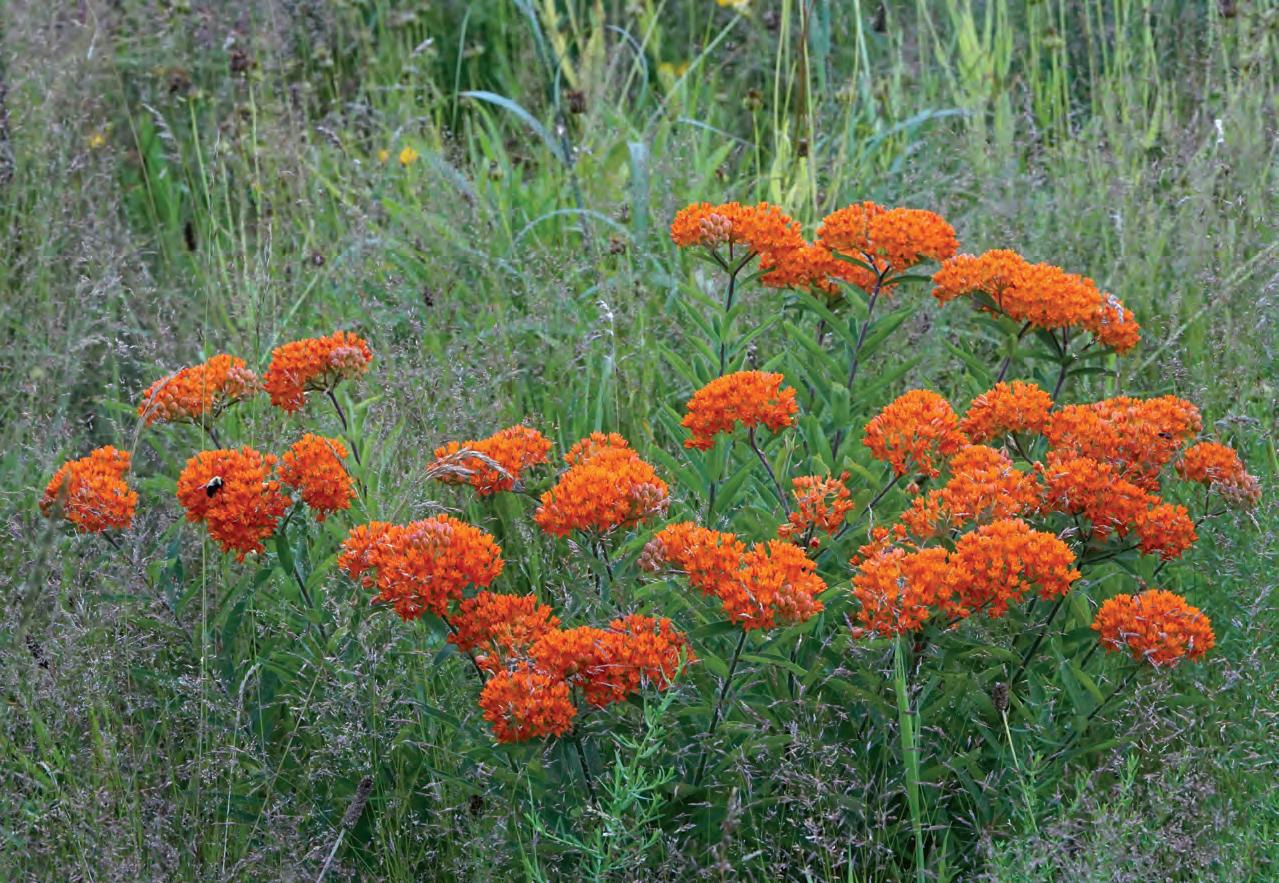
FEATURE • THE BUGS IN MY BACKYARD 37 marthasvineyard. .com
A brown-belted bumble bee, Bombus griseocollis, forages on butterfly weed.
Butterfly weed, Asclepias tuberosa, is a fantastic pollinator plant.

The second personal shift was one that many others on the Vineyard have experienced to some degree: a growing awareness that our individual choices affect the finite and sometimes surprisingly delicate natural resources of the Island we inhabit.
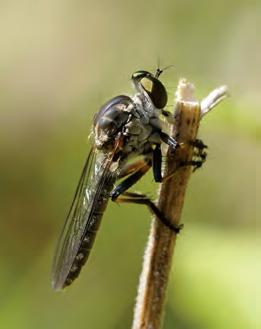

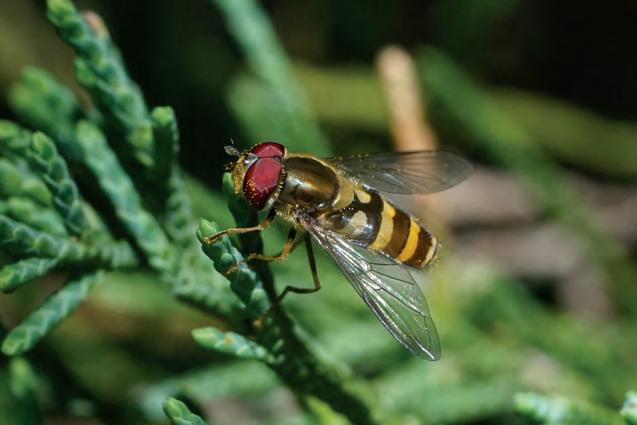
with an ongoing burden of maintenance; the more I worked, the farther behind I fell.
Ultimately, it was the plants themselves that saved me. A coreopsis in one of my floral borders produced viable seeds, some of which landed and germinated amid the scruffy tufts of grass. I mowed around these volunteers, letting them flower and disperse more seed. In a few years, coreopsis had spread throughout our front yard, and during its bloom period in June and early July, it produced a blanket of yellow blossoms.
I was onto something. Butterflies visited the coreopsis flowers; later in the summer, goldfinches perched precariously on the flower stalks, winkling coreopsis seeds out of the dried heads. Here was a plant that advertised its suitability to our yard’s challenging conditions: beautiful when in bloom, supportive of wildlife through the summer, and best of all, demanding no effort from me.
Thus a new set of principles emerged. Instead of fighting the realities of soil and climate in an effort to grow plants that didn’t want to be there, I tolerated and even encouraged plants that chose our yard on their own. And I sought to add species, especially (though not only) ones native to the Vineyard that seemed likely to feel at home. Little bluestem, a characteristic grass of open Island habitats, volunteered for duty. I purchased a few big bluestem plants, which loved where I put them so much that they expanded into a dense clone fifteen feet across. Two species of goldenrod drifted in, along with three or four types of aster, providing bursts of late-season color. The flat seeds of butterfly-weed, snitched from wild plants and unceremoniously spread among the bunchgrass, grew up and produced masses of bright orange flowers. A native prickly pear cactus hugs the south side of our foundation, attracting bees to its showy yellow flowers every June. Highbush blueberries buzz with bees in spring and then fatten our local catbirds with berries in July.
As our yard steadily evolved from unsuccessful lawn into successful meadow, two trajectories of personal change
THE BUGS IN MY BACKYARD • FEATURE 38 MARTHA’S VINEYARD /SPRING 2024
A hoverfly in the genus Syrphus perched on red cedar in the author's yard.
The robber fly Dioctria hyalipennis on a red cedar. This predator fly is common in the yard during its June flight period.
Left: The robber fly Ommatius tibialis perched on a weed stem in the author's yard. This is a common predatory fly on Martha's Vineyard.
Right: Opomyza sp. The larvae of this strange fly genus are stem miners, living inside the hollow stems of grases.
Some of that biodiversity verges on the bizarre. The fly genus Opomyza, for example — a member of the small and obscure family Opomyzidae, or “grass flies” — turns up annually in the big bluestem patch I mentioned. Why? Well, Opomyza larvae are stem miners, spending their childhood developing inside the stems of grasses. The thick, hollow stalks of my big bluestem, which grows six feet tall, evidently offer congenial conditions for Opomyza larvae, and this fly, which appears to be scarce on the Vineyard, somehow sniffed out this new housing stock.
Less strange but much noisier are my Orthoptera — grasshoppers, crickets, and katydids. About 20 species in this interesting order, out of the 67 species (current and historical) known from Martha’s Vineyard, have turned up in our yard. A dozen of those breed annually, laying their eggs in plant stems or in the ground and feeding on the yard’s diverse plant life. On a late summer night, as many as a half-dozen cricket and katydid species may be heard calling at once (see our online story to hear a chorus of katydids).

A female sweat bee, Agapostemon virescens, forages on a coreopsis blossom. This hardy "seminative" wildflower is self-sustaining and supports a wide range of wildlife.

FEATURE • THE BUGS IN MY BACKYARD 39 marthasvineyard. .com
Painted lady butterfly, Vanessa cardui, nectars on native aster flowers.
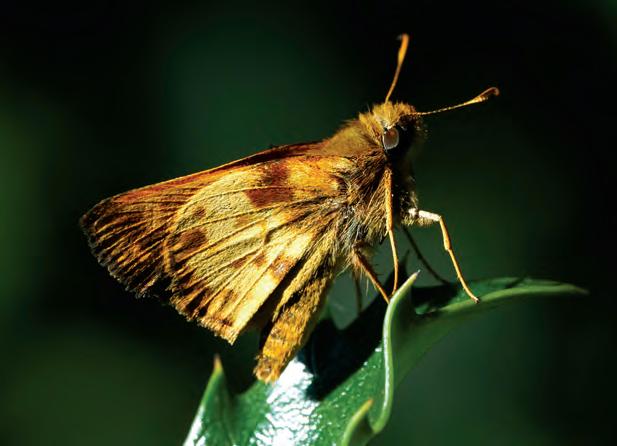
worked to encourage my shift in landscaping goals and aesthetics. The first of these was a steady broadening of my natural history interests. Arriving on the Vineyard in 1997, I was an avid observer of birds, butterflies, and dragonflies — and that was about it. In large measure, those narrow interests simply reflected the times. The nascent internet afforded few resources to a naturalist, and only the most conspicuous and easily observed groups of organisms were covered by existing print field guides. So unless you were game for serious scientific study — collecting specimens, using microscopes,
identifying with scientific keys — there were relatively few groups you could expect to teach yourself about successfully.
But the quarter-century since then has been one of astonishing, ever-accelerating growth in the study of nature. Digital photography has made documenting wildlife easy and, by extension, has encouraged the production of a host of excellent, specialized identification guides. Web platforms like BugGuide.net and iNaturalist.org grew up to link amateurs with experts from literally all over the world. Even the vast morass of Facebook features countless islands of natural history knowledge, groups in which naturalists share photos and information and help each other learn. I’m anything but an early adopter when it comes to technology. But my love of nature pushed me to embrace these new resources, and the newly accessible wealth of information, in turn, broadened my love of nature.
The second personal shift was one that many others on the Vineyard have experienced to some degree: a growing awareness that our individual choices affect the finite and sometimes surprisingly delicate natural resources of the Island we inhabit. Steadily more interested in encouraging native plants and animals and less inclined to add nutrients or pesticides to the local ecosystem, I came to view my “meadowization” process as a way to advance both goals at once. With apologies to my long-suffering neighbors, I didn’t much care about how our yard looked; or, rather, I replaced the arbitrary aesthetic of a groomed lawn with a different set of values favoring minimized impact and high biodiversity.
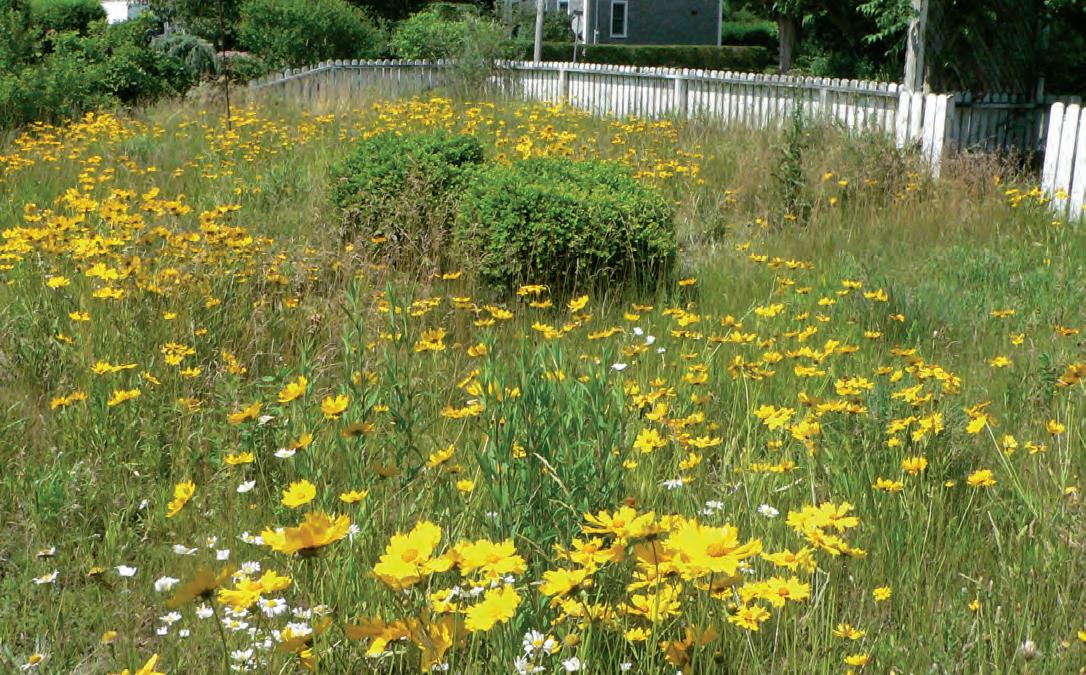
The front yard is now full of coreopsis; it's the only place on the Vineyard where some species of bees have been found.
THE BUGS IN MY BACKYARD • FEATURE 40 MARTHA’S VINEYARD /SPRING 2024
Male Zabulon skipper, Lon zabulon, perched on an American holly leaf.
Male fork-tailed bush katydid, Scudderia furcata.
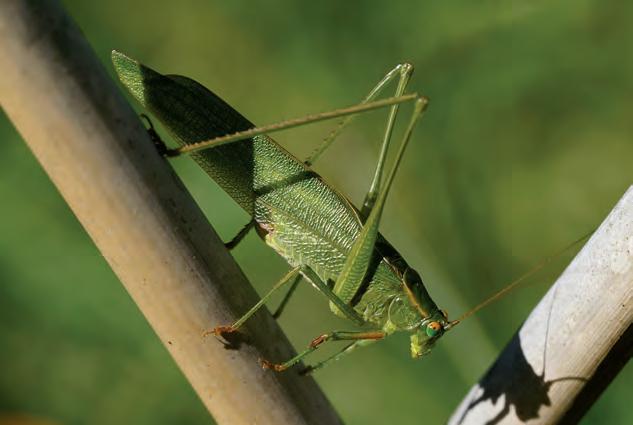
Some of my yard discoveries have been fairly significant. Bees, for example, are a fairly well-studied group on the Vineyard; a major survey in 2010 and 2011 documented 182 species (plus four more found in historical insect collections) on the Island. It’s not easy to add species to such an exhaustive checklist, but subsequent surveys have increased the list by eleven. Five — almost half — of those additions were found and documented in our yard, the result of a season-long parade of native flowers combined with my frequent perusal of those blooms. Melissodes subillatus, to take one of those species, can manage by feeding on and collecting pollen from a wide range of flowers. But given a choice, what it really likes are coreopsis flowers, and the rafts of coreopsis in our front yard are the only place where this bee has been found on the Vineyard. So the hardy plant that launched my meadowization process turns out to reliably support a bee that appears to be uncommon or rare on the Island.
Less strange but much noisier are my Orthoptera — grasshoppers, crickets, and katydids. … On a late summer night, as many as a half-dozen cricket and katydid species may be heard calling at once.
These days, my yard work is minimal. I mow trails through the tall grasses and wildflowers and also mow small portions of our yard so we have open space for outdoor projects. The best time for an annual mowing is during a narrow window in early spring, before much plant growth has started but
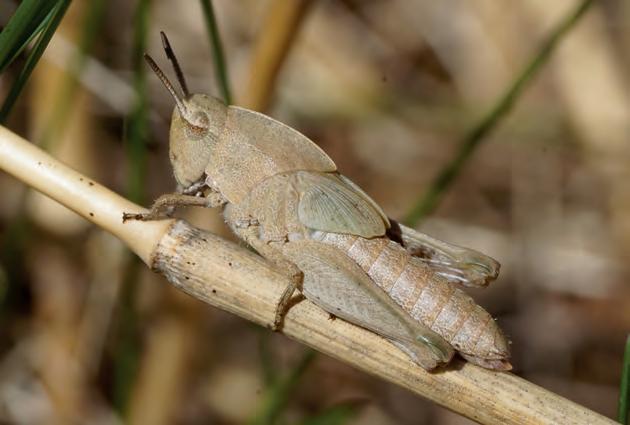
A nymph, or immature, northern green-striped grasshopper. This adaptable species breeds annually in the author's yard.
when it’s warm enough so that insects are mobile and able to get out of the way. In practice, one is likely to mow when it’s convenient — but at least annually or every other year, to avoid a buildup of dead plant material that can block seeds from reaching the soil and prevent new germination. Another good idea is to mow only part of the meadow at a time so there is always a refuge. I divide plants into three classes. Some species, which I deem useless or invasive, I actively discourage, uprooting them or cutting flowers off when the mood for management strikes me. Others, which I want more of, I encourage, collecting and spreading their seed. Everything else is on its own, persisting or fading away depending on its ability to handle the yard’s difficult soil and full sun and the competition from other species. In place of laboring like Sisyphus to maintain a sterile monoculture of non-native grass, I spend my time studying the wealth of biological diversity supported by my ersatz and endlessly interesting meadow.
It's not the outcome I expected when we washed ashore back in 1997 with a vision of the American lawn guiding my land management. But like any aesthetic convention, lawn worship is essentially arbitrary, the result of familiarity (I struggled, there, to avoid writing “brainwashing”) rather than any inherent value. And the huge industry that has evolved to maintain this peculiar form of land use (a quick Google search puts the annual value of the landscaping industry at roughly $130 billion) looks to me, at best, like a missed opportunity. Imagine that amount of money and expertise deployed to create habitat instead of to maintain millions of acres of biological desert! There’s beauty in diversity and in the infinitely complicated web of interactions that make up the natural world. We have the power to encourage and enjoy that beauty if we choose. Why settle for sod?
Interested in landscaping for wildlife habitat?
Natural Neighbors, a program run by BiodiversityWorks, helps landowners plan and carry out nature-friendly improvements. Visit bit.ly/BioDivNatural.
FEATURE • THE BUGS IN MY BACKYARD 41 marthasvineyard. .com
FIELDNote
Climate change is global, but climate adaptation is local. While governments, industry, and large non-governmental organizations struggle to mitigate climate change, all of their combined resources will not be enough to help communities adapt to the coming changes. Each community is, to some degree, on its own. We founded Village and Wilderness in 2021 to help communities develop the climate adaptation tools that work best for them. We made our Microhabitat Program Incubator our flagship project, because bringing nature back to where people live is one of the most effective, natural, and least expensive climate adaptation strategies that any community can implement. Since our focus is on communities, we started first with our own, on Martha’s Vineyard, before branching out to others around the country.
Nature, even in its smallest patches, can provide some of the most effective and sustainable buffers to climate change. For species that are forced by climate to move across landscapes fragmented by buildings and roads, these small habitats can offer refuge and places to breed. For people, small patches provide space for trees to shade streets and homes, and native plants to filter road run-off before it enters the water table. In the process of creating habitat for native plants and pollinators, and allowing for biodiversity in the residential landscape, many property owners report a deep feeling of agency: it's something tangible and rewarding that they can do for the planet, and it offers educational and aesthetic benefits to their families and communities.
To: Bluedot Living
From: Tom Chase, Executive Director
Subject: Village and Wilderness
organizations, such as Homegrown National Park (homegrownnationalpark. org) and the National Wildlife Federation (nwf.org), have provided individual property owners with the fundamental principles of sustainable natural yard management. Meanwhile, many local organizations have joined the movement. Having become established across the suburban landscape, the movement now confronts an inevitable frontier: how can it provide benefits to people — like those living in some urban neighborhoods —
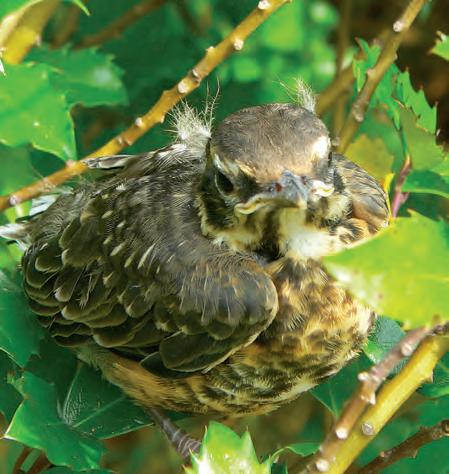
many microhabitats (e.g., providing food, shelter, and water for native plants and wildlife), there are very few universal “best practices.” That’s because each community is different — be it culturally, historically, economically, or ecologically — and each will have different priorities. Moreover, each microhabitat will have limits to the purposes it can effectively serve. Pollinator gardens, for example, do better in sunny rather than shady areas; shade trees grow best where someone is willing to water the saplings; suburban lots accommodate more bird species than urban lots.
For decades, the movement to renaturalize backyards has swept across the suburban landscape. Several national
Small
offer
for
who don’t have or own backyards? How can it help underserved communities and those who live in some of the most climate-vulnerable areas? Fortunately, several organizations have made great progress in this arena, helping residents work with neighborhood public spaces such as school yards, places of worship, roadside verges, municipal properties and even vacant lots. Because these spaces, be they private or communityowned, are often small and scattered, we refer to them as “microhabitats.”
But a challenge remains. While there are common themes for re-naturalizing
To achieve maximum impact and success, microhabitats need to be designed with a view to both the interests of people and the realities of the land in question. In general, community-based organizations — those who live and work nearby and know the local people, land, and wildlife — are best positioned to guide microhabitat designs. Microhabitats do best when guided by naturalists with a working knowledge of landscaping, native plants, and local species, but unfortunately, many community-based organizations are small, understaffed, and under-resourced. They may already be working so hard to solve their communities' most immediate problems that they have neither the time nor capacity to develop, fund and staff a microhabitat program.
Through its Microhabitat Program Incubator, Village and Wilderness helps community-based organizations build new programs, develop strategies to overcome barriers, and share and learn with peer organizations. One example is BiodiversityWorks’ Natural Neighbors program, which we helped to create, working with the program staff to conceive a novel solution for sourcing locally-evolved native plants.
VILLAGE AND WILDERNESS • FIELD NOTE 42 MARTHA’S VINEYARD /SPRING 2024
habitats
refuge
species, such as this fledgling Robin in an American holly bush.
MATT PELIKAN
We made our Microhabitat Program Incubator our flagship project, because bringing nature back to where people live is one of the most effective, natural, and least expensive climate adaptation strategies that any community can implement.
After testing the solution in real life, we collaborated on a case study to share that strategy with others. Our case studies, like our directory of programs, research bibliography, and other information, are freely available through our open access Resource Center (villageandwilderness. org/resource-center-programdirectory/). We offer a newsletter to keep practitioners up to date on emerging issues and have formed a network through which they can pose questions, meet, share experiences and collaborate.
Finally, our recently launched grant program provides funding to help microhabitat programs become more effective and to better reach underserved and climate vulnerable communities. By taking a bird’s eye view of programs around the country, Village and Wilderness is learning not only what the most common needs are among organizations, but also where the frontiers are for the microhabitat movement as a whole. Equity is one of them; low income neighborhoods do
not have the resources that more affluent suburbs do. Other frontiers include developing good science and metrics to objectively evaluate the impact of microhabitats; improving municipal and state policies that encourage the production and use of native plants; and drafting methods to recruit, train and retain field naturalists to help property owners and communities design microhabitats. Village and Wilderness focuses on enabling and amplifying the work of community-based microhabitat programs, be they in urban, suburban or agricultural landscapes. Visit our directory (villageandwilderness.org/ resource-center-program-directory/) to see if there are hands-on, onsite programs to help you develop your microhabitat. Or, if you would like to support the work of Village and Wilderness and the many organizations and communities we serve, please visit our website (villageandwilderness. org) and donate there.

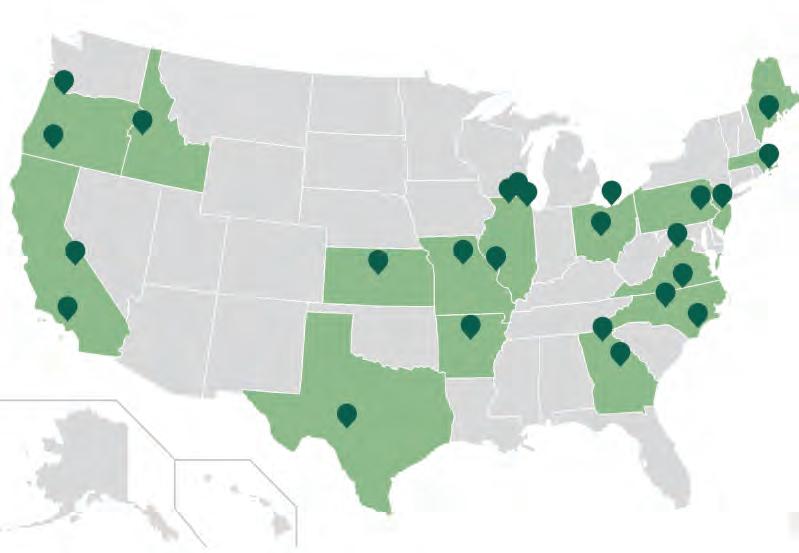
A
map of microhabitat programs in the Village and Wilderness program directory.
FIELD NOTE • VILLAGE AND WILDERNESS 43 marthasvineyard. .com
COURTESY VILLAGE AND WILDERNESS
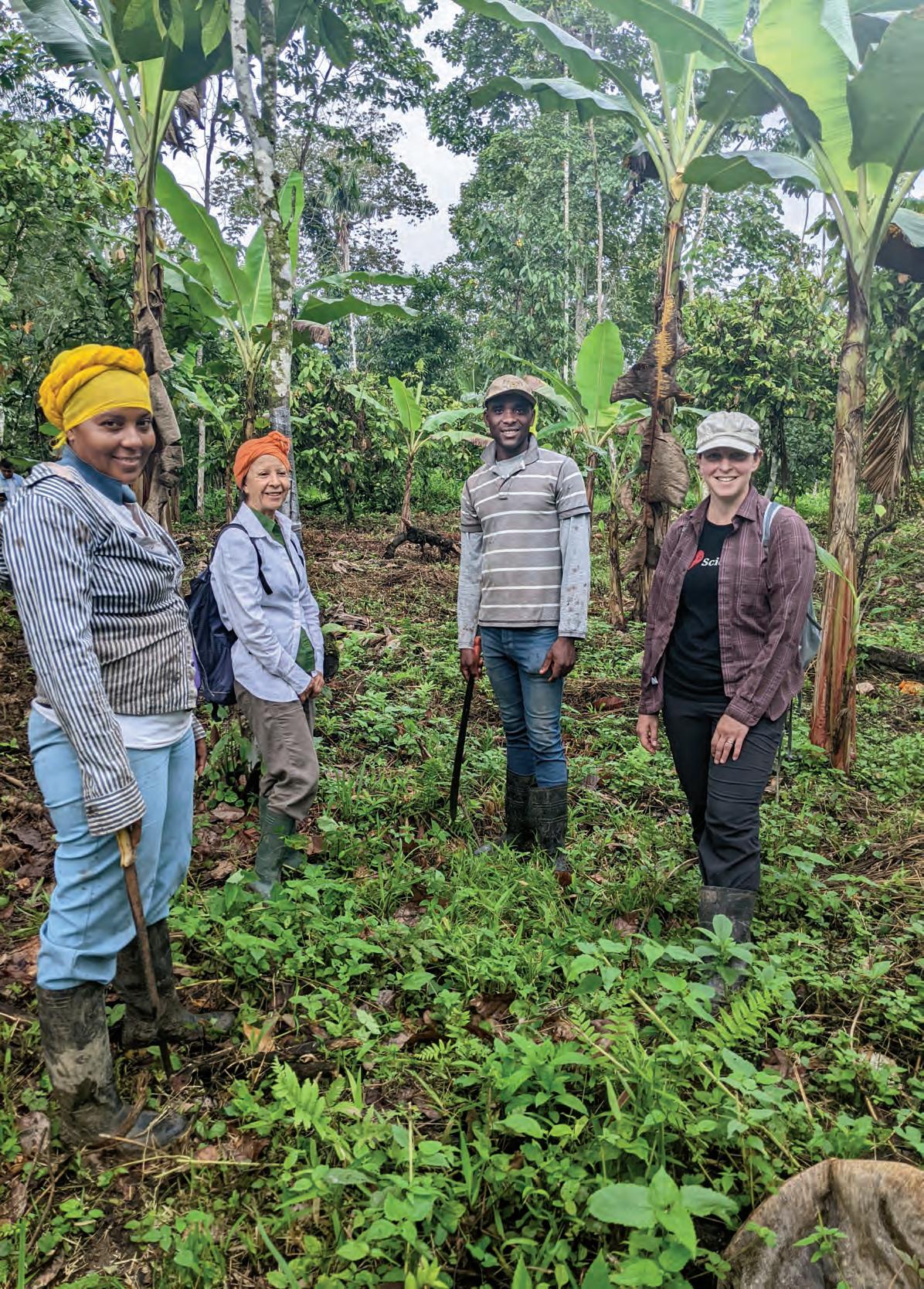
Boston-based chocolatier Lori Shapiro (right) at a cacao forest in Ecuador with farmers. Shapiro saw firsthand that farmers were growing older cacao varieties in sustainable settings, but having trouble selling their product at reasonable rates. So she learned to make chocolate so she could import their cacao at a fair price.
WHAT'S SO BAD ABOUT CHOCOLATE • FEATURE 44 MARTHA’S VINEYARD /SPRING 2024
WHAT’S SO BAD ABOUT
CHOCOLATE?
Most corners of this industry are pretty dark, though there are glimmers of hope for change. For chocolate lovers with a conscience, it’s a matter of knowing where to look — and what to look for.
Story by Leslie Garrett Photos courtesy courtesy Sueños Chocolate
Karen, my Guatemalan friend, had a gift for me — a disc of chocolate she’d brought me from her country. “It’s for hot chocolate,” she said, guiding me through how to make the traditional chocolate drink she’d grown up with. “Chocolate in Guatemala is not considered candy,” she explained. “We drink it more than eat it.” Chocolate is a big part of Guatemalan culture, Karen told me. “Cacao beans were used as currency by the Mayans, so it has always been considered valuable.” Even now, it plays a role in religious and cultural ceremonies like Christmas or First Communion. “It’s as important as coffee. We are always offered both.”
Following Karen’s instructions, I melted the chocolate in a pan with water and poured the mixture into a mug. I took a sip and was struck by its bitterness.
In point of fact, the consumption of sweetened chocolate is only a few centuries old, whereas for many centuries — maybe even millennia — chocolate was consumed principally as a bitter, yet coveted, beverage — the way it’s still typically enjoyed in Guatemala. The Mayans and Azteks drank chocolate during marriages, sacrifices, and other important ceremonies, convinced of its magical properties. And, as Karen told me,
chocolate was so valuable to them that they even used the beans as currency.
But though modern chocolate is sweeter than it once was, it retains a bitter pedigree. Although it’s an economic engine in a few parts of the world, its profits rarely benefit the people who perform the hard labor of growing and picking the cocoa beans from which chocolate is made.
It’s been years since we learned about chocolate’s dark side — that much of the cocoa we consume is produced largely by the slave labor of children in Africa’s Ivory Coast and Ghana. Citizens and advocacy groups
in this way, and those companies issued pledges to address the concern. Certification programs were announced — Fairtrade, Rainforest Alliance, UTZ — and U.S. politicians pressured the industry to tackle the issue. In an article for a 2016 issue of Fortune, reporter Brian O’Keefe wrote that “former Sen. Tom Harkin, a Democrat of Iowa, and Rep. Eliot Engel, a New York Democrat, pushed the big chocolate makers to agree to eradicating the worst forms of child labor, as defined by the International Labor Organization’s Convention No. 182, by July 1, 2005.”
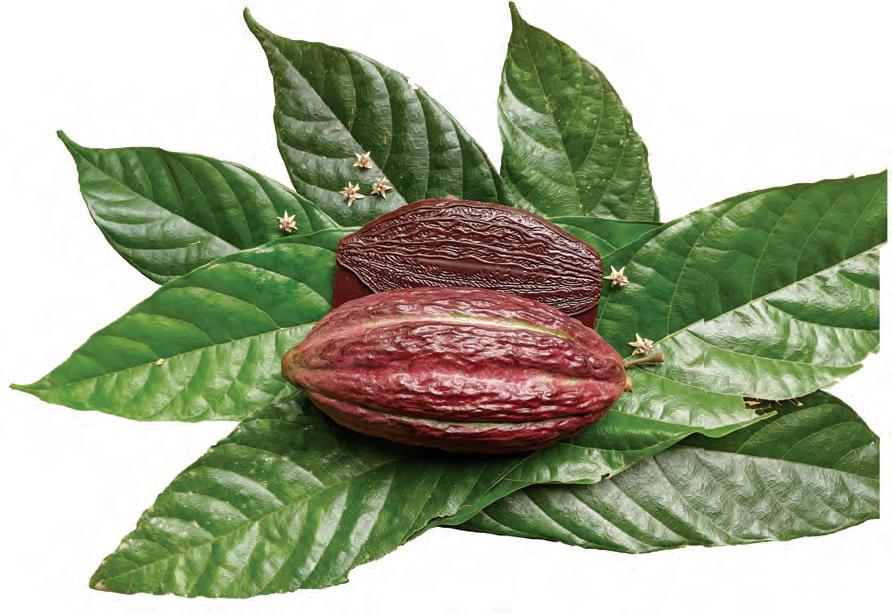
FEATURE • WHAT'S SO BAD ABOUT CHOCOLATE
45 marthasvineyard. .com
deadlines to uproot child labor from their cocoa supply chains in 2005, 2008, and 2010. Next year [2020], they face another target date and, industry officials indicate, they probably will miss that, too.”
Spoiler: They did.
Meanwhile, the world’s hunger for chocolate continues to grow, even as children, some as young as five or six years old, remain in the fields, harvesting
cocoa with machetes, and farmers growing cocoa remain so impoverished that they couldn’t afford to buy the chocolate they help produce.
Danish filmmaker Miki Mistrati just wanted to buy himself a chocolate bar in 2001, when he noticed that one out of the seven available chocolate bars at his local store was marked “Fairtrade.” He asked himself a question that would change his life: Were the other six
Children, some as young as five or six years old, remain in fields with machetes, harvesting cocoa. Farmers who grow the cocoa remain so impoverished that they wouldn’t be able to afford to buy the chocolate they help produce.
unfair trade?
Mistrati hooked up with a photographer who’d been investigating child slavery for Fortune magazine, and the two set off for Mali. “I was just sitting in a bus stop in the southern part of the country,” Mistrati recently told podcaster Jordan Harbinger, “and some local helpers told me, ‘Hey, you just wait for the next bus and you will see that kids — you know, six, eight, ten years old — are getting picked up by traffickers.’ And they literally just did that in front of my face.”
That was more than twenty years ago, back when the truth about cocoa production was just coming to light. It led to Mistrati’s first film, The Dark Side of Chocolate. Since then, he’s kept tabs on the chocolate industry of the Ivory Coast in Africa, where two thirds of the world’s cocoa is grown, and not much has changed.
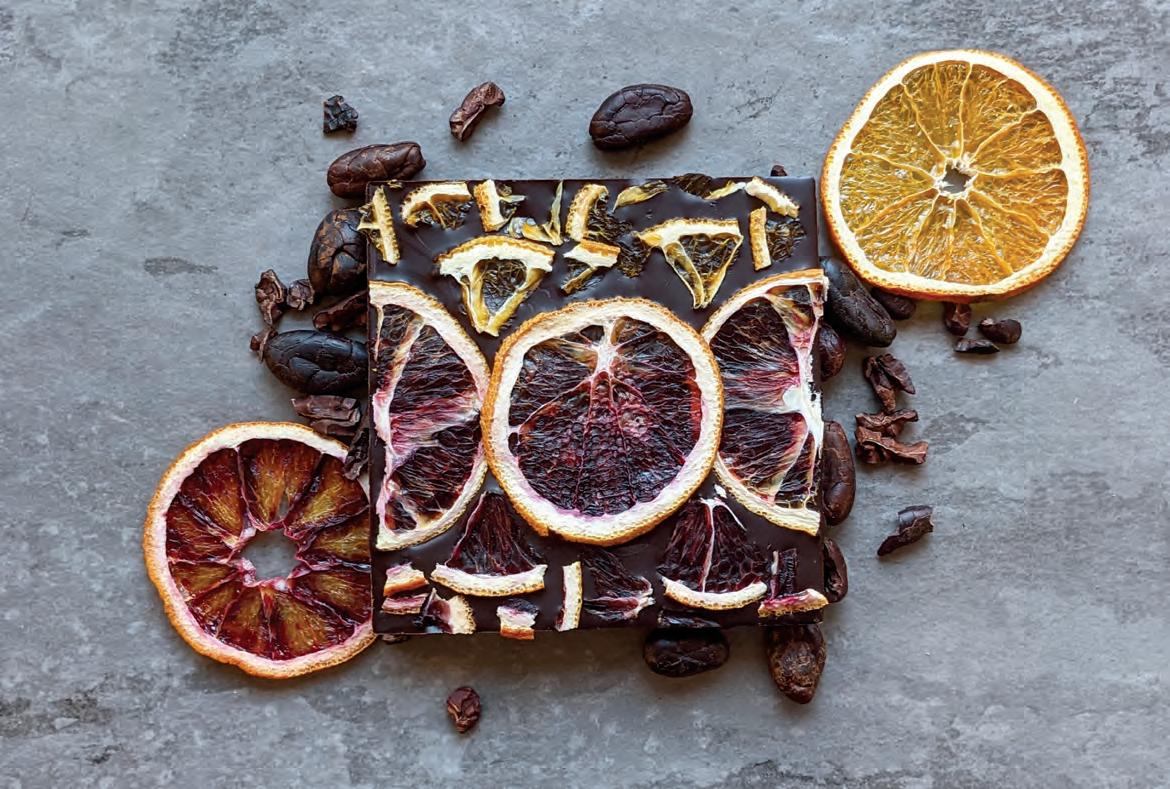
WHAT'S SO BAD ABOUT CHOCOLATE • FEATURE 46 MARTHA’S VINEYARD /SPRING 2024
PHOTOS COURTESY SUENOS CHOCOLATE
“At that time, when I did my first film, they said, ‘Oh my goodness, we didn't know there was a problem,’” Mistrati told podcaster Harbinger. “Well, today they are more like, ‘Well, we know there is a problem and we are doing our best to stop this,’ which is bollocks in my opinion. Because if you wanted to stop this, it would be so easy.”
Kerry Daroci, the Cocoa Sector Lead with Rainforest Alliance, doesn’t believe it’s that simple. Daroci has spent close to a decade investigating chocolate in order to help determine who earns the Rainforest Alliance certification, denoting that the chocolate within the wrapper “was produced using methods that support the three pillars of sustainability: social, economic, and environmental,” according to the organization’s site.
Rainforest Alliance is a well-known certification program, reliant on thirdparty verification, meaning that those determining which cocoa providers subscribe to the Rainforest Alliance’s principles are independent of the organization and industry itself.
Nonetheless, the Sierra Club recently criticized cocoa fairness certification, noting that “Well-known certifiers, such as Fairtrade International and Rainforest Alliance/ UTZ Certifiers, are only required to visit fewer than ten percent of cocoa farms. And they don’t do surprise visits.”
“this plan has greatly strengthened our work in the cocoa sector of West Africa, and the Rainforest Alliance continues to build on these improvements.”
But change doesn’t come easily in the cocoa industry. As Rainforest Alliance’s Daroci says, “it’s been estimated that cocoa farmers receive about six percent
According to Daroci, two interconnected issues — climate change and poverty — drive the sector-wide problems of deforestation and child labor.
Daroci finds hope in what she says is “more public conversation” about these issues, but has that translated into actual change on West African cocoa farms?
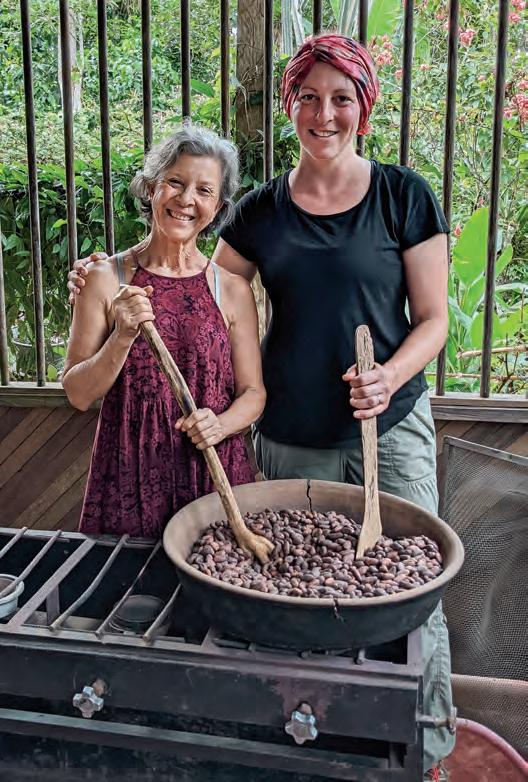
of chocolate bars’ retail price, on average. … They’re clearly on the losing end of a very long, complicated supply chain.”
Rainforest Alliance responded to these allegations, both to Sierra Club and Bluedot, noting that the information Sierra Club referenced dates back to 2019, prior to the launch of the Rainforest Alliance’s significantly strengthened Certification Program and Cocoa Assurance Plan. “After a multiphased rollout and implementation,” a spokesperson for the organization wrote,
What’s more, climate change is making an already challenging crop even more challenging. In early 2024, cocoa futures hit a record high as particularly rainy weather in West Africa’s Ivory Coast and Ghana — where 60 percent of the world’s cocoa is produced — led much of the cocoa crop to spoil due to rot and disease. Farmers are being forced to decide between moving their cocoa farms uphill or quitting altogether.
Miki Mistrati offers an emphatic no, and indeed, a 2019 Washington Post story cites a U.S. Department of Labor survey that put the number of child laborers on cocoa farms at two million.
Which is why International Rights Advocates (IRA), a Washington, D.C.-based human rights firm, is speaking in a language that corporations understand. On February 12, 2021, the firm filed a lawsuit against Nestlé, U.S.A.; Cargill, Incorporated; Cargill Cocoa; Barry Callebaut USA LLC; Mars, Incorporated; Mars Wrigley Confectionery; Olam Americas, Inc.; the Hershey Company; and Mondelēz International, alleging violations of International Labor Organization Convention No. 182 (Worst Forms of Child Labor) on behalf of eight plaintiffs who were trafficked as children from Mali to the Ivory Coast. Terry Collingsworth, a U.S. human rights lawyer and lead counsel for IRA wants consumers to know that companies are lying about what they’re doing. “The cocoa companies … promised twenty years ago … they would stop profiting from child labor,” he told WBUR host Deepa Fernandes in December 2023. “But it’s worse than ever.”
CBS News ran a story in late November, 2023, for which reporters drove up to plantations and found children as young as five years old at work wielding machetes, including children who, according to cocoa companies’ data,
FEATURE • WHAT'S SO BAD ABOUT CHOCOLATE 47 marthasvineyard. .com
Lori Shapiro and Yamile Roldan slow roasting heirloom cacao beans in Puerto Quito, Ecuador.
were ostensibly in school.
The root problem is poverty, Daroci insists, often driving farmers to put their children to work on the farms. Most farmers don’t want their children working on a cocoa farm in dangerous conditions, she says, but “They don’t have other options.”
Deborah Patta, the CBS reporter who found the children on the plantations, wholeheartedly agrees. Farmers simply need to be paid more, she insists.
Rainforest Alliance and others look at the ILO definition of “the worst forms of child labor,” in an attempt to focus on the worst offenders and the trafficking. Daroci says that they want to “ensure that children have access to schooling, that they’re not working during times when they should be in school, that they’re not carrying heavy loads, or using machetes or other machinery that can be dangerous for them, spraying pesticides … that could have negative health impact, especially on a growing body.”
She admits that “it’s a very difficult issue to identify and to address.” Rainforest Alliance has created its “assess and address” approach, requiring farmers who want their certification to meet certain conditions monitored by investigators, including ensuring access for children to a school that is reasonably close, and assessing risks to children on farms. It’s a new approach, she says, based on the recognition that simply demanding that farmers don’t use child labor just leads to the practice being more hidden. With this new system in place, Daroci says, “it’s much more likely to bring the issue out in the open and provide solutions.” Rainforest Alliance sees itself as a partner with these farmers, creating “a more well managed, climate smart, productive farm.”
she acknowledges that there’s plenty of skepticism about any initiatives by these big chocolate brands, she sees reason for optimism. For instance, Nestle, she says, is undertaking what it calls an Income Accelerator Program, which purports to help farmers diversify so that they’re less reliant on cocoa, as well as adopt a regenerative farming model that’s better environmentally. Hershey, taking its cue from Nestle, has adopted the same model.
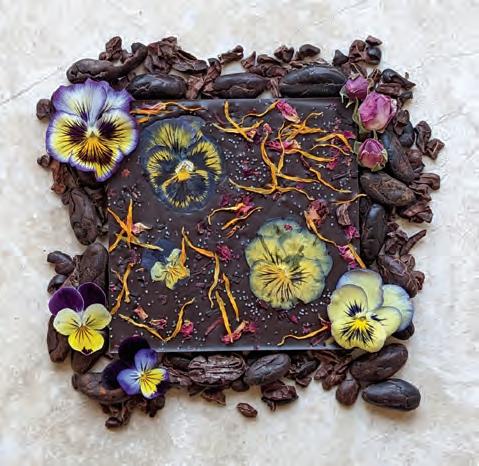
Miki Mistrati doesn’t buy it. In his most recent film, The Chocolate War, he went looking for the schools that chocolate companies claimed to be building for child laborers. When the companies themselves refused to give him a list of the schools, he again went undercover. “We did find schools,” he told podcaster Harbinger, “not even half done. The guy running the school said, ‘Well, yeah, they came, and we were doing the plans, and they did the first foundation of the school, and then they disappeared and never came back.’ … it was, again, just greenwashing.”
That’s exactly what Kyleen Keenan, a vegan chef and founder of Happyist Plant-based Foods, did. The Edgartownbased co-author of Chocolate Every Day (and the former proprietor of “Not Your Sugar Mamas” chocolate, which she has since shuttered) told us that because she believes raw cacao is a superfood, abandoning it was not an option for her. Instead she dedicated herself to finding a supplier she could trust to be growing the beans in a way that didn’t harm the environment and that didn’t exploit workers. And that, she says, tasted good.
Her search led her to partner with a co-operative of 164 family farmers in Satipo, Peru, the basin of the Amazon. “We looked for direct trade,” she says, “because we want complete transparency on who we’re buying from and their practices.” The cocoa there is regeneratively farmed from heirloom trees, she explains, making it “probably the most nutrient dense cacao available.” Workers are paid above fair trade prices, a cost reflected, she says, in what she pays for cocoa.
Companies, Daroci says, need to invest in projects that put kids back in school, and that address deforestation. “Having that overall investment is critical,” she says. While
Even so-called “sustainable cocoa” can’t be relied on, Mistrati said. Instead of claims on chocolate wrappers, Mistrati looks for information on where the chocolate originated. “I buy chocolate from Ecuador or from Peru or South America,” he says.
Boston-based chocolatier Lori Shapiro created her company, Sueños Chocolates, to support the farm — Finca Sueños — where she worked during a college exchange program. Shapiro saw firsthand that Finca Sueños’ owner, Yamile Roldan, was “growing these older [cacao] varieties in these very sustainable settings — agroforestry settings … on a small family farm.” But many of the local, smallscale farmers don’t even have cars or trucks to get their product to market, she says, “so farmers are vulnerable to buyers, they don't have a choice who to sell to. And so they're really at the mercy of these very influential Latino multinationals that only care about price.” These farmers, she says, were doing what everyone said farmers should be doing, but they were having trouble selling their product at reasonable rates. “And so I learned to make chocolate so I can import their cacao at a [fair] price.”
Farmers like these are, increasingly, joining cooperatives, which better
WHAT'S SO BAD ABOUT CHOCOLATE • FEATURE 48 MARTHA’S VINEYARD /SPRING 2024
empowers them to demand fair pricing. Finco Sueños, for instance, is now part of Asociación Nueva Esperanza, an organic growers association in Puerto Quito, Pichincha, Ecuador.
The region — and the farming — is not without issues. Kyleen Keenan went there herself when she was seeking farmers from whom to buy raw cacao. “I was hoping to go there and be like, ‘Oh my gosh, everybody’s doing such a great job protecting the rainforest.’ And that was not the truth that I found.” Instead, she says, there’s “deforestation, midnight logging, murders, and everything that goes along with climate awareness is super corrupt. … But I see that the other crops in that region are more part of the problem than cacao.”
The cooperative that she works with (she won’t disclose the name because she wants to preserve the “trade secret,” she says) supports the farmers to ensure not only that they grow their crops in a way that protects the soil, but also that they are guaranteed buyers. She’s confident

Instead of claims on chocolate wrappers, Mistrati looks for information on where the chocolate originated. “I buy chocolate from Ecuador or from Peru or South America,” he says.
that the cacao she’s buying adheres to her principles.
And there are other pockets of hope. In Ecuador’s Jama-Coaque Reserve, a cloud forest ecosystem, Third Millenium Alliance, a non-profit organization, is working to promote sustainable cacao farming by paying farmers to shift toward more sustainable shade-grown cultivation and helping them access buyers.
But sadly, most major chocolate manufacturers still use cocoa produced unsustainably, and with child labor. It’s something Keenan wishes more people paid attention to. “I wish they
WHAT YOU CAN DO
Steer clear of chocolate from the big chocolate companies and seek out those on Slave Free Chocolate’s recommended list (slavefreechocolate.org/ethical-chocolate-companies), which highlights companies around the world committed to environmentally and socially responsible cocoa. Or ask your local chocolatier where they source their chocolate.
Research shows that adding labels to products has an impact. Climate Basecamp is inviting all of us to join its campaign to add warning labels to chocolate packaging. (Info here: climatebasecamp. org/save-chocolate/) If people knew that climate change threatened the availability of their beloved chocolate, they argue, maybe they'd get involved with fighting climate change.
knew what they were supporting,” she says. These practices continue, she says, because we keep buying what such companies produce. “So I just wish people knew how important their buying power was. It’s a big thing, how we source our food and how we care about the planet. I wish people took more responsibility for their actions.”
Deborah Patta with CBS put it this way in her report: “I think consumers, personally, would be thrilled to know that an extra few cents for chocolate they’re buying is going to send a child to school.”

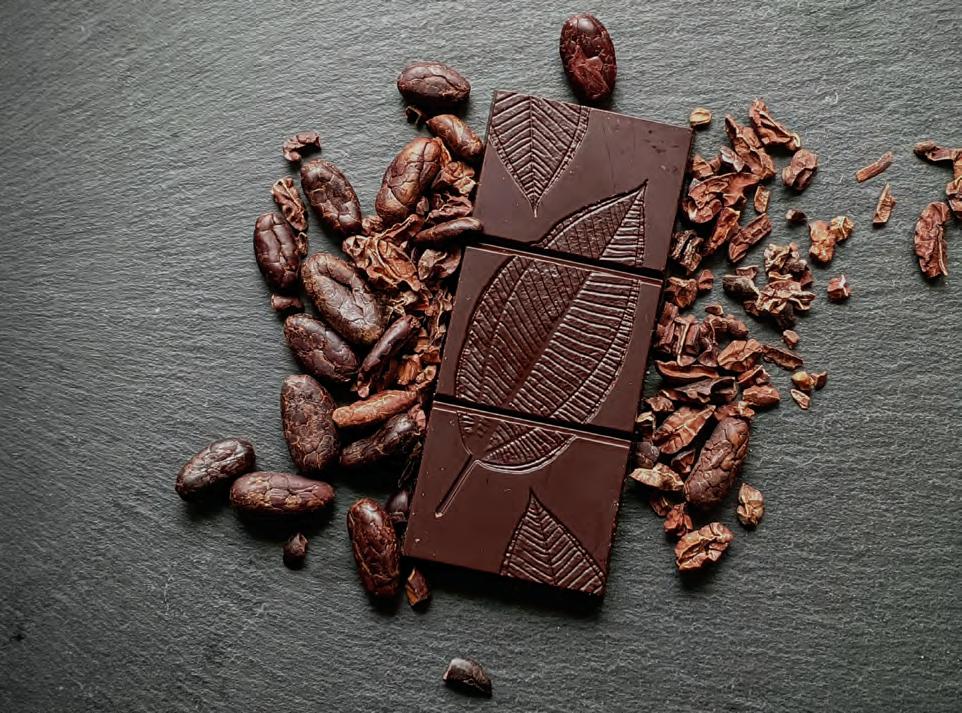
FEATURE • WHAT'S SO BAD ABOUT CHOCOLATE 49 marthasvineyard. .com

Gilligan Cooking with Carol The Bluedot Kitchen
Story by Laura D. Roosevelt
Food photos by Randi Baird
CCarol Gilligan’s groundbreaking 1982 gender studies classic, In a Different Voice, put her on the map as a psychologist, a feminist, and an ethicist. But she’s also an educator who currently teaches a wildly popular course on listening at New York University, a novelist, and an excellent cook. She’s been married for sixty-four years to psychiatrist and violence expert James Gilligan (“Sixty-four years!” she exclaims. “We’re in the Museum of Natural History!”), and she has three children and six grandchildren. When she’s at her Martha’s Vineyard house in Aquinnah in warm weather, she tries to start every day with a swim in the ocean.
Some forty years ago, Carol developed a theory called “the Ethics of Care,” centered around what she learned when interviewing women for In a Different Voice. Rather than focusing on abstract ideals like “justice” or “fairness”, care ethics posits that when people (particularly women) make moral decisions, they consider how their actions might affect others. It takes into account relationships, community, and interdependence. Recently, it’s having a resurgence of popularity, showing up in the curricula of higher education institutions worldwide, as well as at the annual meetings of professionals in fields like nursing. It underlies the many conversations taking place across the globe about the intersection of social justice and environmentalism, and about the rights of species other than human beings.
“I remember having this image of a trampoline,” Carol says; “you step on it in China, and you feel it in Brazil. Climate change just brings all that to the forefront. It’s all about interdependence, and everything being connected. The Ethics of Care used to be seen as a feminine thing, a woman thing, but now, there’s this awareness that we all need to start taking care of the world, of our future, of ourselves and each other.”
Anyone lucky enough to eat dinner at Carol’s house will recognize immediately that the Ethics of Care inform her cooking. She cares about
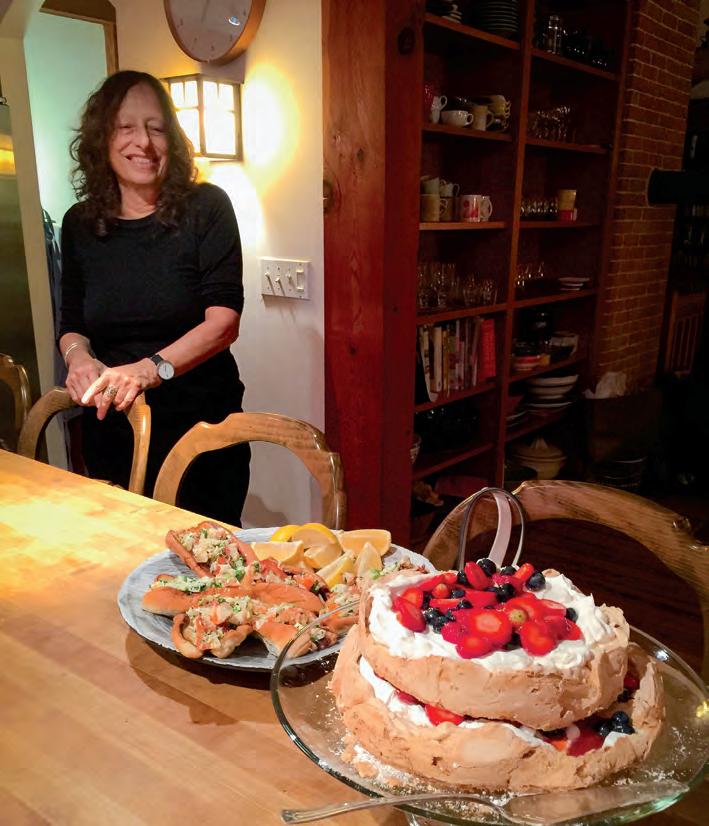
nourishing her guests with fresh, local food cooked simply but deliciously. And she cares about talking and being together: while she cooks, the rest of us sit on tall stools around her kitchen island, chatting and snacking on what is always a bountiful array of appetizers. Generally, there will be sashimi from the Net Result or any of our local fish markets; local farm cheeses from Grey Barn or Mermaid, or others; and farm-grown string beans that have been barely boiled, then tossed with lemon juice, salt, and a dash of olive oil — a technique she learned from a waiter at a restaurant in Italy (and which she also uses with vegetables like asparagus and broccoli, depending on what looks good at the farmers’ market). “I like the idea that you can make your hors d’oeuvres both nutritious and also beautiful,” she says — the bright green of the beans,
Anyone lucky enough to eat dinner at Carol’s house will recognize immediately that the Ethics of Care inform her cooking. She cares about nourishing her guests with fresh, local food cooked simply but deliciously.
the red slices of raw tuna, the creamy center of a cheese encased in an orangecolored rind.
“I love it when one of my guests cooks with me,” she adds. Noting that when on the Vineyard, she and Jim eat mostly fish, she says that “with fish, you want to cook it until it’s just done, not overdone, and there’s a tension in that; I love having someone to share that with. I like it when I can say ‘come and taste this; does it need more salt?’”
Carol grew up in a Jewish household on the Upper West Side of Manhattan. As was true of all her neighborhood friends, the person who cooked in her house was an employee. But though her mother didn’t do the cooking herself, she was, Carol says, “basically an artist by nature, so there were always great aesthetics to food in our house, and an appreciation for good food.” Her mother
COOKING WITH CAROL GILLIGAN • THE BLUEDOT KITCHEN 51 marthasvineyard. .com
COURTESY CAROL GILLIGAN
planned menus and clipped recipes from the New York Times, and their housekeeper, Lily May, cooked them.
“When I got married,” Carol says, “I had never cooked anything. I remember calling Lily May and asking, ‘How do you cook spinach?’ I mean, I had no idea!”
Cooking didn’t become an important part of Carol’s life until the 1960s, when she and Jim had young children and were living in Newton. In those days, children came home from school for lunch every day, and two afternoons a week — left open for music lessons and dentist appointments — they didn’t return to school. “This was a time when a lot of women were going back for their degrees,” Carol says, “but I already had my Ph.D and was at home, so I often took care of a lot of the other children in the neighborhood along with my own. One of my activities with the children on those afternoons
was baking bread.” That, she says, was the beginning of her love affair with cooking. Soon, she and her children were cooking dinner together.
“Late in the day, when the children’s patience was frayed,” she says, “we would gather in the kitchen and chop vegetables and sort of chat, but you didn’t have to talk. It didn’t have to be a conversation; we’d just hang out. My children remember that, and all my boys now cook as a result. And I learned to love cooking; I still do. At the end of a day of writing, or copyediting (the obsessiveness of that drives me crazy), the thought of chopping an onion just seems very peaceful to me.”
While Carol’s cooking on the Vineyard centers around fresh fish and local vegetables, in the wintertime, when she and Jim are in New York City, their evening socializing often takes place at restaurants. At home,
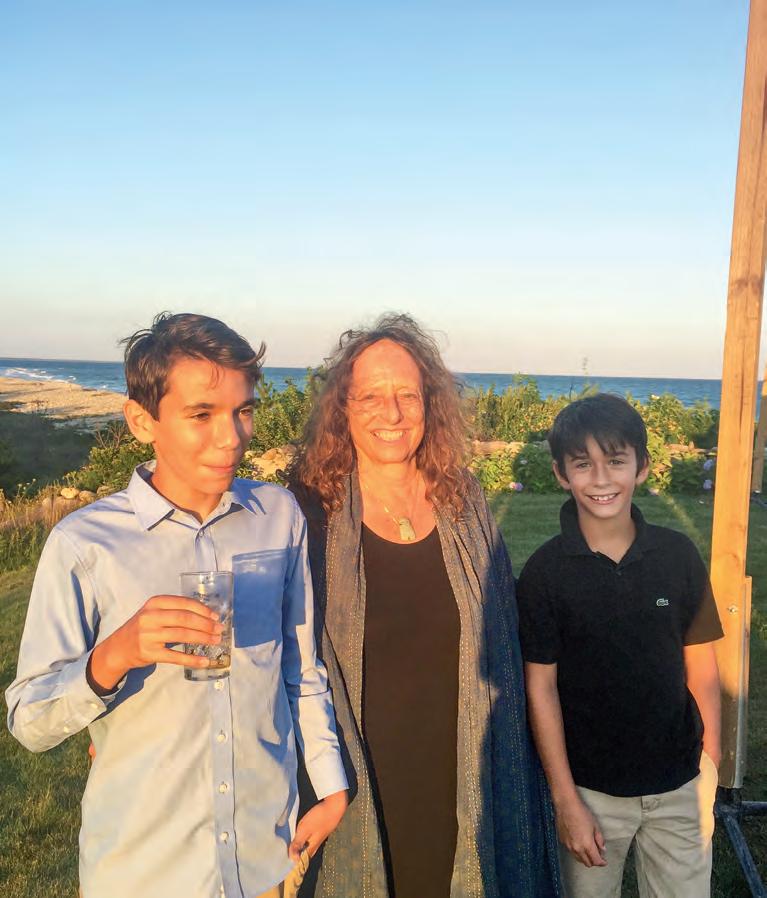
“I had never cooked anything. I remember calling Lily May and asking, ‘How do you cook spinach?’ I mean, I had no idea!”
–Carol Gilligan
she cooks simply and nutritiously, but always with care. “On regular nights, I don’t cook from recipes; I just see what I have, or start with what looks good at the market. Maybe I have some chicken in the fridge, and some bok choy, and some cashews, and I’ll throw them in a wok, and sometimes it comes out fantastically.”
“The Ethics of Care used to be seen as a feminine thing, a woman thing, but now, there’s this awareness that we all need to start taking care of the world, of our future, of ourselves and each other.”
–Carol Gilligan
Like all good cooks, she likes to have certain items always at hand, keeping her kitchen stocked with lemons, onions, eggs, garlic (“definitely, lots of garlic!”), and spices. When she sets out to make a meal, she tends to go in one of two spice-driven directions: Indian, or French/Italian, using either a combination of turmeric, cumin, coriander, and cinnamon, or a mixture of thyme, oregano, and basil. “With some produce, and some protein, and one of those combinations of spices, that’s dinner!” she says. “Sometimes I’ll cook some onions and garlic in a pan, add some chicken thighs and brown them, then I’ll add all the Indian spices, and it’s delicious. That to me is a simple and delicious weeknight dinner, and it doesn’t take a lot.”
The following are two recipes Carol has been enjoying recently.

You can find Carol’s books on Amazon, including In A Different Voice. Here’s the link for that one (Bluedot may earn a commission if you purchase the book via this link): bluedotliving.com/In-ADifferent-Voice-book-Gilligan-Amazon
THE BLUEDOT KITCHEN • COOKING WITH CAROL GILLIGAN
COURTESY CAROL GILLIGAN
Carol Gilligan with her grandsons, Jacob (left) and Noah Gilligan, in Aquinnah.
ANTI-INFLAMMATORY CAULIFLOWER CARROT SOUP
Recipe by Carol Gilligan
Photo by Randi Baird
“I get emails with recipes from The Clean Program [a wellness program based on the bestselling book Clean, by cardiologist Alejandro Junger, MD],” Carol says, “and this one really caught my eye. It seemed healthy, because it had garlic, ginger, and turmeric in it. My granddaughter, who’s particular about what she eats, loves it, and Jim does, too. And it’s beautiful — yellow from the turmeric, with green parsley and browned pine nuts on top. Jim and I will have this as dinner, with maybe some bread or a green salad.”
INGREDIENTS
1/4 cup olive oil
1/2 Tbps. dried turmeric
1 Tbsp. fresh ginger
1 Tbsp. fresh garlic
4 cups chicken stock or vegetable broth
1/2 white onion
2–3 cloves garlic
3–4 large carrots
2 large cauliflower head
1 (14 oz.) can coconut milk
Parsley and pine nuts for topping Avocado oil for roasting
DIRECTIONS
1. Preheat oven to 400°F. Remove stem and leaves from cauliflower and chop. Remove stems from carrots. Slice leek, keeping only the white portion. Peel and chop the onion. Peel and mince the garlic and ginger.
2. Toss cauliflower and carrots with a drizzle of avocado oil, then sprinkle with salt and pepper. Spread onto a baking sheet and roast for 2025 minutes, or until vegetables are caramelized and tender. Toss halfway through baking time.

3. While vegetables are roasting, heat a large pot over medium heat. Add olive oil to the pan, then add leeks and onion. Season with salt and pepper. Cook, stirring occasionally, until fragrant and lightly browned (5-6 minutes). Next, add ginger, garlic, and turmeric to the pot. Cook, occasionally stirring, for 4-5 minutes.
4. Add stock, coconut milk, roasted cauliflower, and carrots to the pot. Turn heat to high and bring the soup to a boil. Reduce heat to a simmer, cover, and cook for 10 minutes. While soup simmers, mince parsley and lightly toast pine nuts (if using for garnish).
5. Remove soup from heat. Process until creamy and smooth in a highspeed blender, or use an immersion blender. Serve immediately. Soup will store in the refrigerator for up to a week, or in the freezer for three months.
Notes: I added a few squirts of ume plum vinegar to this soup at the end, and it gave it a nice extra zing. A little lemon or lime juice might also have worked well.
COOKING WITH CAROL GILLIGAN • THE BLUEDOT KITCHEN 53 marthasvineyard. .com
CAROL GILLIGAN THE BLUEDOT

DIRECTIONS
1. Simmer the bacon pieces in water for about ten minutes to remove some of the fat. Drain.
2. Soak the sauerkraut in cold water until it’s reached the level of saltiness that you want. Pour it into a colander and squeeze out the excess water.
3. In a Dutch oven with a lid, melt the butter, then add the bacon, onion, and carrots and cook until the onions have softened. Add the sauerkraut, toss and mix, then cook for 10 minutes, stirring occasionally.
4. Add 1 cup white wine and enough chicken stock to just cover the sauerkraut.
5. Make a bouquet garni by wrapping the bay leaves, parsley, juniper berries, and peppercorns in a square of cheesecloth and tying it into a bundle with kitchen string. Bury it in the sauerkraut.
6. Preheat oven to 325°F. Bring the pot to a simmer on the stove, then turn off heat, cover the sauerkraut with a round of buttered parchment paper, and place the pot in the oven. Cook 3-5 hours.
CHOUCROUTE
Recipe by Carol Gilligan
Photo by Randi Baird
“This is a no-recipe recipe that I grew up with,” Carol says. “I happen to love sauerkraut, especially the way the French cook it. I get good sauerkraut from somewhere like Hawthorne Valley Farm, or some small batch, probiotic thing, and it’s so good. I serve the choucroute with mashed potatoes. This dish says cold weather to me.”
Note: I put Carol’s no-recipe instructions into recipe form.
INGREDIENTS
10 peppercorns
10 juniper berries*
4 sprigs parsley
2 bay leaves
2 (1.5-pint) jars of sauerkraut
3–4 carrots, cut in thin rounds
1 onion, cut in half lengthwise and then in thin slices crosswise
1 cup white wine
2 Tbsp. butter
1/4 lb. bacon, cut into lardons Chicken stock
Meat of choice**
7. Remove from oven. Remove bouquet garni. Serve with mashed potatoes if desired.
Notes: * If you can’t find juniper berries, allspice berries, lightly crushed with a mortar and pestle, can be substituted.
** Carol says: “If I want to add meat, I brown a small rack of baby back ribs on the stove and bury them in the sauerkraut midway through the cooking, so that when the dish is ready, the meat is almost falling off the bones.” The author browned some turkey sausage on the stove and added it at the end.
54 MARTHA’S VINEYARD / SPRING 2024






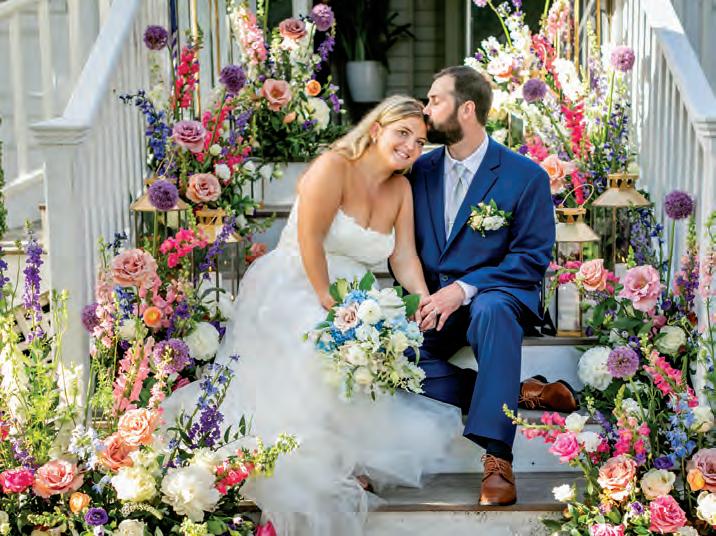
BDL 55 marthasvineyard. .com www.randibaird.com 508-505-5909 Family Portraits EngagEmEnts · WEddings
Room for Change: The Workout
My Name is Mollie, and I am a Stretch Fabric Addict.
Story By Mollie Doyle
Illustrations by Kate Feiffer
Afew years ago, my daughter won the Falmouth Academy Science Fair for a project that measured the microplastics that athletic leggings leach after every wash. (Some WHOI and Marine Biological Lab scientists oversaw this process.) The cheaper pairs broke down and lost about 1 teaspoon of plastic per wash immediately. And, unfortunately, even the more expensive pairs began to break down and leach plastic after a dozen or so washes.
As most readers know by now, I am extremely brand conscious — careful to know that clothing companies are following best manufacturing and labor practices; but I had not deeply considered or quantified what my clothing — particularly my athletic clothing — was doing to the environment when I washed it. Even worse, because I’m a person

than 30 years, leggings are part of my daily clothing life. So, how many teaspoons of plastic had I unwittingly washed into the earth? The thought horrified me.
But in all honesty, I was more upset by the prospect of returning to wearing unforgiving, thigh-grabbing cotton shorts and pants, because, like most yogis and athletes, I love the stretch when I move. And that is when I had to come to terms with the fact that I am a stretch

Airbrush, ReZion, Dri-Fit, LYCRA — oh, what you do for me. You hug me; move with me, expanding and contracting in all the right places; you don’t squeeze me when I’ve gained a few winter pounds; and you’re there for me, holding me close, when I lose them again in the spring. Of course I love you.
I am not alone in my stretch fabric addiction. According to the Textile Exchange, in 2022, polyester and all of its pseudonyms (see above) became the dominant fabric used by the global garment industry. In fact, polyester and synthetic clothing make up 70% of our garb these days.
Unfortunately, these synthetic fibers are not great for the environment. As my daughter showed in her science project, they shed microfibers. Other not so great facts: they are fabricated with fossil fuels such as crude oil (an estimated 342 million barrels of oil per year, according to the Ellen MacArthur Foundation’s A new textiles economy:
THE WORKOUT • ROOM FOR CHANGE 56 MARTHA’S VINEYARD /SPRING 2024

into the cool colors and patterns we have come to love with our athletic wear is also problematic, as it uses a tremendous amount of water as well as toxic chemicals that are hazardous to human health and difficult to dispose of.
Given all of this, I set out to find alternatives made with less environmentally harmful materials, such as cotton, linen, Tencel Lyocell (a type of rayon that is manufactured from sustainably sourced wood pulp), and wool. And let me say, as I was doing this, I still
favorite resource for clothing brand ratings and evaluation: Good On You. This is a site that, in my opinion, has the best, most thorough, and most thoughtful evaluation of thousands of clothing brands. They have an entire section dedicated to athletic wear. I found a pair of cotton sweatpants from Kotn. They were great and long enough for my daughter’s very long legs. But they were very thick. Come Spring, we needed a few lighter options. Back to Good On You. I tried a couple of new
WHAT YOU CAN DO
1. Always use what you have. Wear it out. Even though my synthetic leggings leach plastic, it would be even more wasteful to not use them up, so I’ll wear them until they are worn out. And I wear them only when the situation, such as an
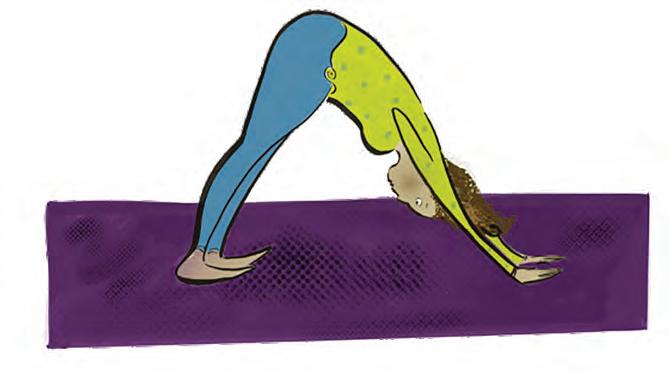
brands —The Girlfriend Collective and Ambiletics (which were ok, did not become my favorite clothing because I did not love the cut and fabric) — and returned to my friends who own Foat Design for yoga shorts and pants made with cotton deadstock. Even though it is cotton, the Foat clothing lasts and holds its shape. Then the summer heat and humidity came, and I ransacked my closet, returning to my thinnest, softest, most moisture wicking fabrics, a.k.a. synthetic stretch clothing that is horrible for the environment but feels great on an 80 degree day on a tennis court. In the fall, I returned to wearing the more sustainable, environmentally responsible garb.
In this year-long journey, I was able to kick the stretch habit with my jeans and other clothing. But when it comes to athletic wear, there is no single, easy product solution or purchase approach. The answer, at least for me — someone who is not willing to go cold turkey from the synthetic stretch for athletic wear — is to instead employ strategies that make me stretch as a consumer.

the most joyous, fun things to buy — especially with all the crazy wonderful patterns and colors — but how many pairs of leggings, tank tops, etc. do we really need? Even I, a person who often exercises more than once a day several days a week, certainly do not need more than one pair of leggings per day of
Always buy consciously. Use websites like Good on You to
guide your purchases, and support companies that are making an effort to make your athletic experience great, but not at the cost of the environment.
4. Consider using cotton-only fabrics during certain times of the year.
5. Launder synthetics in cold water, hang to dry.
6. Check out Dear Dot’s column
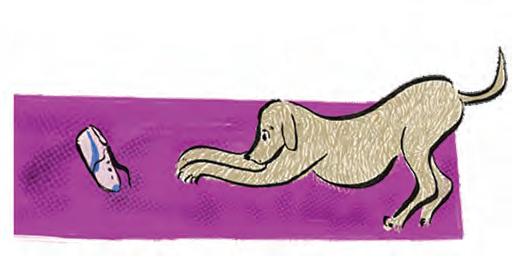
ROOM FOR CHANGE • THE WORKOUT 57 marthasvineyard. .com



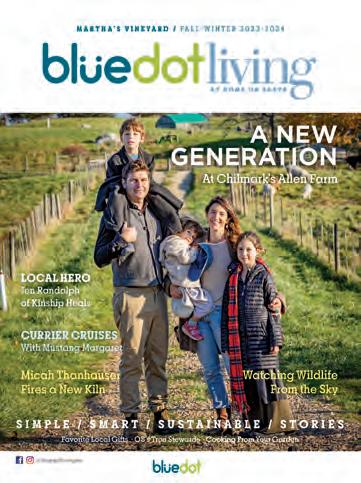
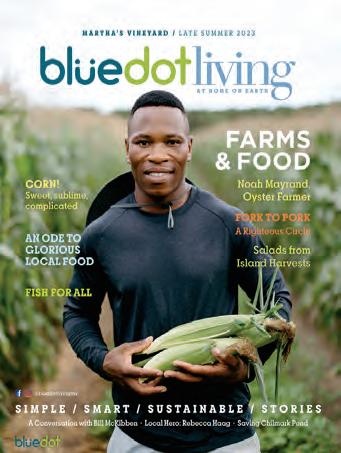


BDL 58 MARTHA’S VINEYARD /SPRING 2024 SUBSCRIBE TODAY! marthasvineyard.bluedotliving.com/magazine-subscriptions Or, email us at subscriptions@bluedotliving.com 4 ISSUES Plus OUR GREEN GUIDE TO MV for only $24.95 Subscribe to our award-winning Bluedot Living magazine Mailed directly to you, or as a gift from you. SIMPLE / SMART / SUSTAINABLE / STORIES Green Guide SIMPLE / SMART / SUSTAINABLE
Continued from page 35
Communication skills like these enhance the argument for tree rights. Trees warn one another of threats to their existence. As the Times revealed, “resources tend to flow from the oldest and biggest trees to the youngest and smallest. Chemical alarm signals generated by one tree prepare nearby trees for danger.”
This thinking has entered popular culture. In his 2019 Pulitzer-Prize winning novel, The Overstory, Richard Powers writes that “trees take care of each other. … Seeds remember the seasons of their childhood and set buds accordingly. … Trees sense the presence of other nearby life. That a tree learns to save water. That trees feed their young and synchronize their masts and bank resources and warn kin and send out signals to wasps to come and save them from attacks. … A forest knows things. They wire themselves up underground. There are brains down there, ones our own brains aren’t shaped to see. Root plasticity, solving problems, and making decisions. Fungal synapses.”
Ecologist Robin Wall Kimmerer, in her bestselling book Braiding Sweetgrass, concludes that “trees act not as individuals, but somehow as a collective. Exactly how they do this, we don’t yet know. But what we see is the power of unity. What happens to one happens to us all. We can starve together or feast together.”
This thinking is also not new. Two major arguments advocating tree rights appeared fifty years ago. University of Southern California law professor Christopher D. Stone titled a law review article, “Should trees have standing — toward legal rights for natural objects.” In it, he contended that “the world of the lawyer is populated with inanimate right-holders: trusts, corporations, joint ventures, municipalities, Subchapter R partnerships, and nation-states, to mention just a few. Ships, still referred to by courts in the feminine gender, have long had an independent jural life.” Why not trees too? He concluded, “I suspect that a society that grew concerned enough about the environment to make it a holder of rights would be able to find quite a
number of ‘rights’ to have waiting for it when it got to court.”
A second early argument appeared in a Supreme Court dissent by Justice William O. Douglas, an early advocate for conservation of the environment. The Sierra Club opposed the development of a ski resort by Walt Disney Productions on sensitive land in California. The organization lost. But Douglas’s dissent in Sierra Club v. Morton cites Stone, arguing that “contemporary public concern for protecting nature’s ecological equilibrium should lead to the conferral of standing upon environmental objects to sue for their own preservation. … Those who have that intimate relation with the inanimate object about to be injured, polluted, or otherwise despoiled are its legitimate spokesmen.”
Happily, the Disney ski area was never built, thanks in no small part to opposition by preservationist groups like the Sierra Club. The land on which it would have been constructed is now part of the Sequoia National Park.
Catholic theologian and scholar Thomas Berry was a highly influential advocate for the rights of nature as they relate to the rights of all beings. In his 1999 book The Great Work, Berry argues that just as human beings possess rights, “trees have tree rights, insects have insect rights, rivers have river rights, and mountains have mountain rights.”
Stephanie Kaza of the University of Vermont credits Berry with observing that “the primary political divisions in today’s world are between those with an ecological or environmental worldview and those with a human-centered, developmental worldview.” She says Berry reconciled the two by viewing the natural world as a united entity on the cusp of environmental collapse. She notes that his view of the seriously degraded condition of the Earth reflects “a deadening or paralysis of some parts of human intelligence and also a suppression of human sensitivities.”
Questioning the new animism
Some arguments against the new animism are expressed as questions along the lines of: If a branch of a large tree falls and
destroys the roof of a house, may the homeowner sue the tree? If a river floods a town, may the mayor and town council sue the river? And what recourse do they have? And of course, there was the ruling against Happy the elephant (though the court allowed her to be moved to a sanctuary, anyway).
Law professor Anna Grear of the University of Cardiff in the U.K. wonders whether applying human legal rights to plants and animals makes sense. She advocates moving beyond Christopher Stone’s fifty-year-old idea of granting rights to trees. She suggests that “the law needs to develop a new framework in which the human is entangled and thrown in the midst of a lively materiality — rather than assumed to be the masterful, knowing center, or the pivot around which everything turns.”
In short, courts must recognize nonhumans on their own terms, and not as a reflection of human beings and their legal rights. She concludes that “laws and rights — for too long tools of human privilege and exceptionalism — need to be reimagined if they are to play a full role in human/nonhuman struggles for a future worth living.”
If human beings are to protect what is left of our environment — our trees, rivers, and nonhuman animals — we must immediately reform the law and grant them the rights they need to go on existing — for us, for themselves and each other, and for the future. And we can all join conservation and ecology organizations and get involved in educating our fellow citizens about this critical matter. We can advocate for changes that will stimulate others to help maintain the quality of our natural environment for future generations.
Jack Fruchtman lives in Aquinnah. He has written, among other books, American Constitutional History, now in its second edition, and is preparing a fourth edition of his book, The Supreme Court and Constitutional Law (both available on Amazon). For a list of additional reading on rights for trees, see our online story on marthasvineyard. bluedotliving.com
ESSAY • DO TREES HAVE RIGHTS? 59 marthasvineyard. .com
Continued from page 64
“A lot of programs the group is doing now are giving people an understanding of the importance of shellfish, and fostering a love for that aspect of Island culture,” Karney said. “Back then, people knew how to shuck. They knew how to rake — there is a need to build that culture up again and keep it going.”
Bluedot Living: Did you always want to become a biologist?
Rick Karney: I have been a biologist since I was a little kid. They used to call me “Butterfly Boy,” because I would have a butterfly net and I would go around the neighborhood and catch butterflies. Where I grew up, in New Jersey, my folks had a little boat. We would go to one of the freshwater lakes about an hour away from my house, or sometimes we would go to the Jersey shore, which was a twohour drive. I was always just fascinated by being on the water — all the life, the birds, the fish, the insects. My father had a net that two people pulled to catch bait. I remember pulling in the net and there would be little blowfish, sometimes crabs, all sorts of cool stuff. So you could say I
always had an interest in biology and the natural world.
I went to Rutgers and was in a biology pre-med program, although I wasn’t even really thinking I wanted to go into medicine. I got out of there and was primed to go to graduate school, but I wanted to take some time off because I didn’t know what I wanted to study. I ended up getting a job as a technician at the Virginia Institute of Marine Science. I was at this little field station on the eastern shore of Virginia. That’s when I really got involved in aquaculture and shellfish culture, and from there I sort of made up my mind: “that’s what I want to do.”
BDL: How did you first find the Island?
RK: I came to the Island in 1976. I had never even been here before. I applied for a job with the Wampanoag Tribe as a shellfish biologist and didn’t get it. At the time, Mike Wild was leading the Martha’s Vineyard Commission’s coastal planning efforts; he called me and said there was a job at the Commission that I might be a good fit for that was pretty similar to the position with the Tribe.
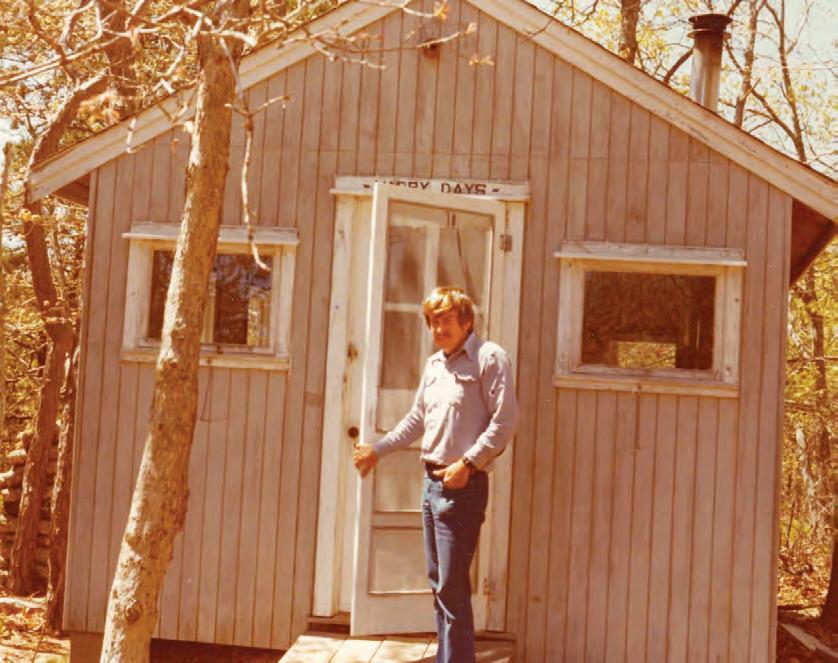
In 1977, Rick Karney worked with the Energy Resource Group to create this solar-powered shellfish hatchery — the first of its kind.
“Back then, you could go into any bar, restaurant, or coffee shop, and within fifteen or twenty minutes, someone would be talking shellfish. That’s how central it was.”
Remember, when I started getting going, all this work was pretty new. We were trying different approaches to starting a hatchery. While all this was going on, the wild fisheries were still very prolific, but [they] started to decline pretty soon after I showed up on the scene. The price of seafood eventually increased to a point where aquaculture started to really take off.
Mike started organizing all these parts together — a representative from each select board, all the shellfish constables — into one big group. Just around that time, there was a big oil spill in Buzzards Bay. There was a settlement, and part of the settlement involved funding to try and reseed the area that was affected, and replenish the shellfish that were lost. So the constables would get this seed from the Aquaculture Research Corporation in Dennis (back then it was known as the Cultured Clam), and were trying out different nursery methods.
BDL: What was shellfishing like back then?
RK: In those days we had a summer that ended on Labor Day, and Islanders made their living on scalloping, and they got family permits and would dig for quahogs; people lived off the water. Once people heard that shellfish aquaculture was possible on the Vineyard, and things like
RICK KARNEY • LOCAL HERO 60 MARTHA’S VINEYARD /SPRING 2024
PHOTO COURTESY MV SHELLFISH GROUP
scallop and oyster seed could be grown locally, that was like the golden goose for that part of the community.
Back then, you could go into any bar, restaurant, or coffee shop, and within fifteen or twenty minutes, someone would be talking shellfish. That’s how central it was. It used to be taught, it was a strong tradition that was passed down generationally.
BDL: How was the Shellfish Group established? What spurred the idea to build the solar hatchery?
RK: The spring after I arrived, the MVC ended up getting a little grant for me. Shortly thereafter, the plans came together for the solar hatchery, and there was a group called the Energy Resource Group that was into alternative energy. We worked with that group and designed the hatchery from the bottom up.
There was a program that provided funding for coastal communities to mitigate any problems that might be associated with offshore oil development. Mike knew about this program, and because nobody else had their act together, we had no competition for the funding. There was a lot of weird politics involved with getting the funding, but we eventually made it through, and we finished construction in around 1981. We were the first public solar-powered shellfish hatchery — it was a brand-new idea.
BDL: Was the community enthusiastic to support this kind of organization when you first began? Has the level of enthusiasm among shellfishermen changed over the years?
RK: The Vineyard has always had this shellfish culture. That’s how people paid their bills. That’s how people ate. There is a huge historical aspect to shellfish on the Island, but a lot of that knowledge and energy is being lost. The Shellfish Group recently hired an outreach coordinator, Nina E. Ferry Montanile. They’ve been doing a program on how to shuck
oysters, and they are starting up their shellfish 4-H program again. Basically, the goal is to get people to understand the importance of shellfish, and foster a love for that aspect of the culture.
There was a time here when everyone knew how to use a rake to dig quahogs, they knew how to shuck. There is a need to build that up and keep it alive here. People go to Disneyland to see Mickey Mouse, and people used to come to the Vineyard because they could grab a rake or just a bucket and go get dinner.
Jack Blake was one of the trainees in my early training group. He has been one of the main proponents of aquaculture and just shellfishing in general. He is the reason many of these younger folks are out there now — he inspired this whole generation of aquaculturists.
BDL: There is a lot of promising research, especially recently, about how good shellfish are for the environment. Does this inspire you? Have you altered your approach to your work?
RK: When I first got involved in aquaculture, you were growing shellfish to be purely a food resource. I don’t know exactly when, but at some point there was a realization that a lot of the pollution issues were related to nitrogen. The more populated areas became, the more we had issues with water quality. People started to look at how shellfish can consume the algae that are growing at densities too high because of that nitrogen overload. Especially oysters — they are a keystone species, so they provide habitat for all these other species. Shellfish create all these little nooks and crannies where marine life can move in and begin to populate that area. This all supports the larger fish population. It’s amazing to see how shellfish can address so many different issues we experience, and more research is coming out all the time. There were a lot of environmental issues occuring in the 80s, and although we didn’t really have a name for it back then, climate change was definitely messing
things up for the marine ecosystem here. The wild shellfish industry started to fail because of a confluence of these things. We used to have really cold winters here, and then year by year we got less ice on all the ponds. Those cold temperatures and ice used to keep green crabs, which are a major predator of shellfish, somewhat at bay. Then we started getting these mild winters, and the crabs started overwhelming the fishery.
When we started hearing about how shellfish can filter out nitrogen and eliminate some of the eutrophication [excessive richness of nutrients in water, often due to runoff, which leads to algae blooms], I was really inspired. It was like this “aha” moment. Then studies started coming out about all the nutritional benefits of shellfish — omega 3s and everything. They become this perfect food, on top of cleaning the water and everything else. The Island started to see shellfish as much more than just a food resource.
BDL: Do you shellfish at all, commercially or recreationally?
RK: I used to shellfish recreationally a lot in Virginia. When I got here, I was doing the work at the hatchery and out on the water all week, so it felt like I didn’t have the time. I used to go out with the shellfish constables and would get my
“People go to Disneyland to see Mickey Mouse, and people used to come to the Vineyard because they could grab a rake or just a bucket and go get dinner.”
LOCAL HERO • RICK KARNEY 61 marthasvineyard. .com
fill of quahogs and oysters and steamers. Now I have bad knees and a bad shoulder, so my rake has been relegated to the closet, more or less. To me, it’s just as satisfying to support the local aquaculturists by buying food from them.
BDL: Do you have a favorite shellfish to eat? What’s your favorite dish involving shellfish?
RK: My favorite shellfish used to be scallops, but it’s hard to say — they’re all amazing. In recent years I have really come to appreciate oysters. Oysters are a little more versatile. You can eat them on the half shell, you can eat them baked, fried, pretty much any way you can think of. And the gastronomical history of oysters is incredible. You look at old oyster cookbooks, and it’s amazing how creative people have been with preparing oysters over the years. I really like oyster stew, but oysters on the half-shell are pretty hard to beat.
I used to bring this sort of oyster casserole to these slow food potlucks that the Ag Society hosted. It’s based on a recipe called oysters primavera that I got from a friend. It’s oysters and broccoli and cheese with pasta and a white sauce — it’s over the top. I also used to make this dish that was essentially clams and linguine. We used to have all the broodstock [mature shellfish used for breeding] quahogs. When we were done with them we were like, “okay, we have to eat these.” A guy who used to be the secretary of the Shellfish Group used to call me “Spawnmeister.” So my recipe was called “Spawnmeister’s Delight.” It called for a dozen spent quahogs — we would use the broodstock after they spawned.
BDL: What are you up to now, apart from your continued work with the Shellfish Group?
RK: I am a gardener. That’s part of why I like the aquaculture thing. Even to the

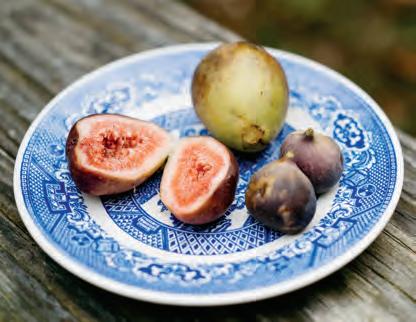
point where young shellfish are called seed and you are basically planting them, letting them grow, you are battling diseases and then harvesting the fruits of your labor. I have a few fig trees. It’s been one big experiment. I started out with just a few, but now it’s a little out of control — I have about twenty-five of them now. I have a few outside that I wrap to protect them from the weather. I have one that lives in the sunroom, and that’s the one that really produces. I got like seventy figs off it last year. Fig trees are a little bit of a challenge, and I like a challenge. Plus, a freshly-picked fig is a pretty amazing piece of fruit. When you think about the heart of civilization in the Mediterranean, it was all figs and olives and everything, so it has that kind of historical allure to it. I also have blueberries and apple trees. I think anybody that’s involved in any kind of aquaculture, a lot of them have gardens and are intimately connected with the land. They live off the land. That’s another thing we are really losing here, but there are still a few people that are holding out and doing things the old way.
BDL: What is something that excites you about the future of shellfish aquaculture on the Vineyard?
RK: One of the most important things the shellfish group has done is help get the private oyster growers going on their farms. That’s one of the things I am the most proud of. The idea that you have private growers spending all their time taking care of all the oyster seed that’s grown at the hatchery — millions of oysters — the success rate and survival rate for that seed is going to be so much better. It’s just great to see people getting
RICK KARNEY • LOCAL HERO
62 MARTHA’S VINEYARD /SPRING 2024
Figs from Rick's backyard trees.
PHOTO SHENY LEON
PHOTO COURTESY MV SHELLFISH GROUP
Rick shows a young biologist the ropes at the hatchery.
into shellfish again. You used to be able to count the number of oyster farmers on the Island on one hand, but now there’s a waiting list for folks who want to start their own farms. I think that’s going to be a huge economic and environmental benefit to the island. The idea that you have local people making a living off shellfish, a local resource, is important. And with the nitrogen issues we’re having, it definitely seems like shellfish are a broad solution to a lot of issues we face as a community.

See related story: What’s So Bad About Nitrogen? : bit.ly/so-bad-nitrogen
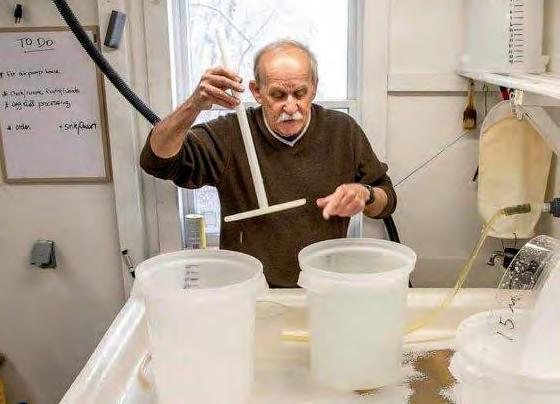

Continued from page 25
engaged with almost 5,000 community members to reduce energy and fossil fuel use.
According to Program Analyst Sophie Pittaluga, Vineyard Power is currently focused on supporting Priority Groups, which include low- and moderate-income individuals and families, English-isolated residents, renters, and residents of environmental justice communities. “There are communities on the Island that are historically barred from engaging meaningfully in this energy transition, whether that’s individuals barred by economic status, access to language, minority status, or those living in environmental justice communities. The transition can only be successful if everyone is involved,” Pittaluga said.
Last year, Vineyard Power was awarded an EmPower grant by the Massachusetts Clean Energy Center. Part of that funding enabled the organization to hire a Portuguese-speaking energy coach — Thamiris Marta — to support the Island’s significant Portuguese-speaking population. Marta has been instrumental in helping Brazilians on-Island participate in the Energy Transition Program.
“When I first heard about this role, I felt like I could really help the Island reach its renewable energy goals,” said Marta, who now serves as Energy Transition Coordinator for Vineyard Power.
Marta is currently training to become an energy coach, and in the meantime is organizing outreach events and connecting with Portuguese-speaking
community members. She recently visited Brazilian churches on-Island to share information about nocost home energy assessments and income-eligible programs that Vineyard Power offers, and to get people involved in the Martha’s Vineyard Commission’s 2024 Climate Action Fair on May 19th.
Marta said that public guidance around applying for and engaging in renewable energy programs needs to be available in Portuguese in order for the entire community to be a part of the energy transition. “Some of the time, when I speak to Brazilians,” Marta said, “they are surprised to hear these programs exist. ‘This has been available this whole time? I had no idea.’ It’s really important to make people aware of these programs, and then work with them through the process. Even if it’s just helping someone fill out paperwork and explaining how this could really benefit their home, or benefit their pockets.”
Anyone looking for more information on electric transportation, building modifications, solar and wind resources, or the Energy Transition Program can visit vineyardpower.com. Vineyard Power also offers energy coaching to help Islanders make informed decisions about purchasing an EV, installing solar panels, improving energy efficiency in their homes, and accessing income-eligible programs.
Para ver este artigo em português, clique aqui: bit. ly/VineyardPowerMV
LOCAL HERO • RICK KARNEY 63 marthasvineyard. .com
FEATURE • DOES THIS TREE HAVE RIGHTS? 59 marthasvineyard. .com
SPONSORED •
Rick at work in the lab at the hatchery. PHOTO COURTESY MV SHELLFISH GROUP
Rick Karney
LOCAL
Interview by Lucas Thors
‘The Spawnmeister’ and the MV Shellfish Group have championed Island aquaculture for nearly fifty years.
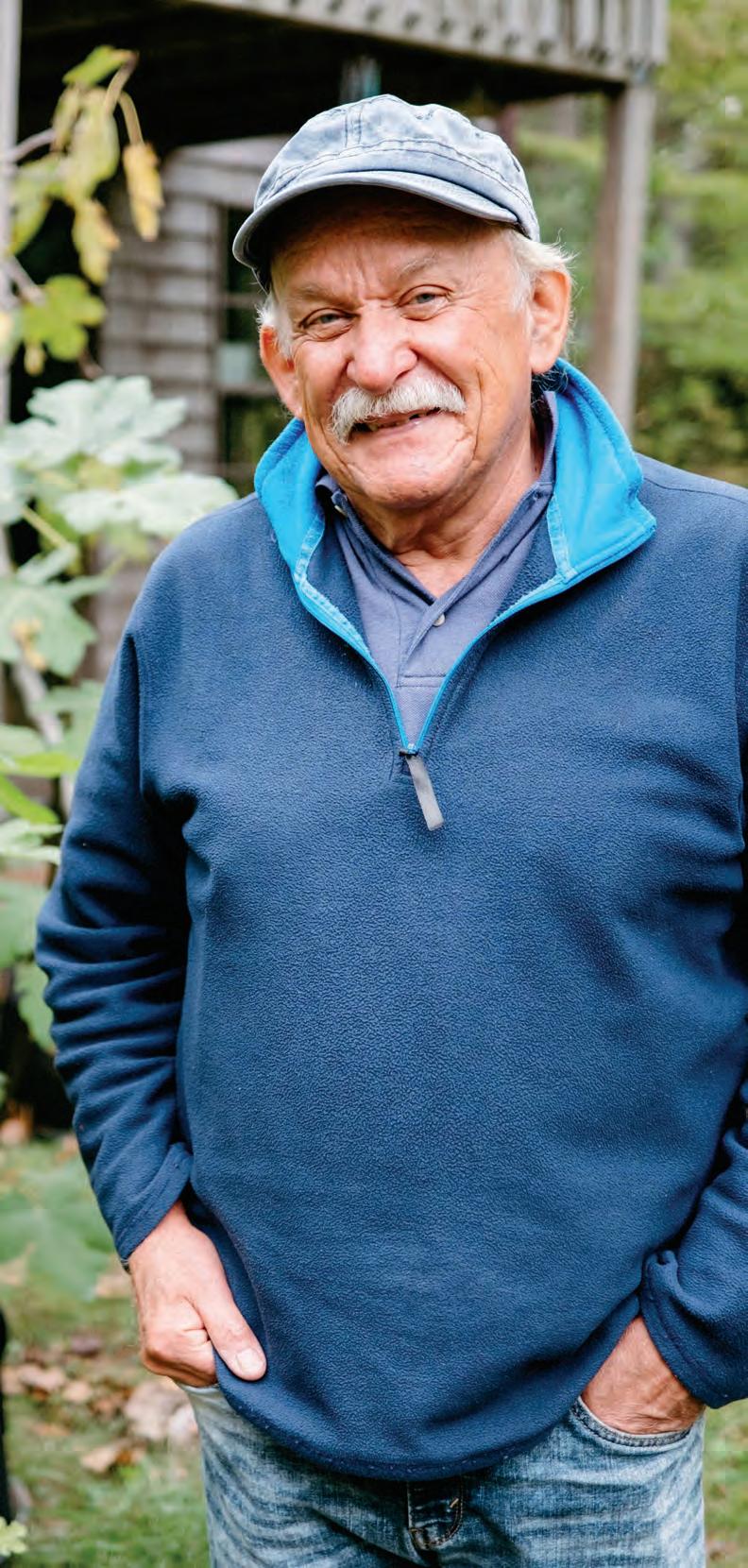
People on Martha’s Vineyard are excited about shellfish, and with good reason. In 2018, the Woods Hole Oceanographic Institution’s marine science journal released a survey study illustrating how bivalves like oysters, quahogs, and soft-shelled clams can filter excess nitrogen in waterways. Long before this scientific epiphany, shellfish were considered an essential economic (and gastronomic) resource on the Island, especially in the early and mideighties, when wild fin fisheries were being decimated due to overfishing, habitat degradation, and pollution.
The wild shellfish industry was booming back in 1976, when Rick Karney washed ashore to take a job with the late Michael Wild, who at the time was serving as Coastal Planner for the Martha’s Vineyard Commission. Wild, a longtime conservationist, sought to bring together all the local shellfish constables, along with representatives from each Island town, to hire a dedicated shellfish biologist who would help establish a regional aquaculture program, and construct and oversee a public hatchery. Karney, who currently holds the title of Founder and Director Emeritus of the Martha’s Vineyard Shellfish Group, recalls that “that first year, a couple shellfish constables got together on basically a nonexistent budget and built a little lean-to greenhouse and started experimenting. Solar energy was just starting to be all the rage; there was a local group that wanted to work with us, and that’s how the solar hatchery was born.”
In 2016, after more than 40 years as Director of the Shellfish Group, Karney stepped down, and Emma GreenBeach, the special projects manager at the Hatchery, assumed the position. Although he’s no longer at the helm of the nonprofit, Karney continues to play an active role in promoting shellfish aquaculture on the Vineyard. He believes the organization has a bright future and that the new team has already accomplished a great deal. Continued on page 60
RICK KARNEY • LOCAL HERO 64 MARTHA’S VINEYARD /SPRING 2024
HEROES
SHENY LEON
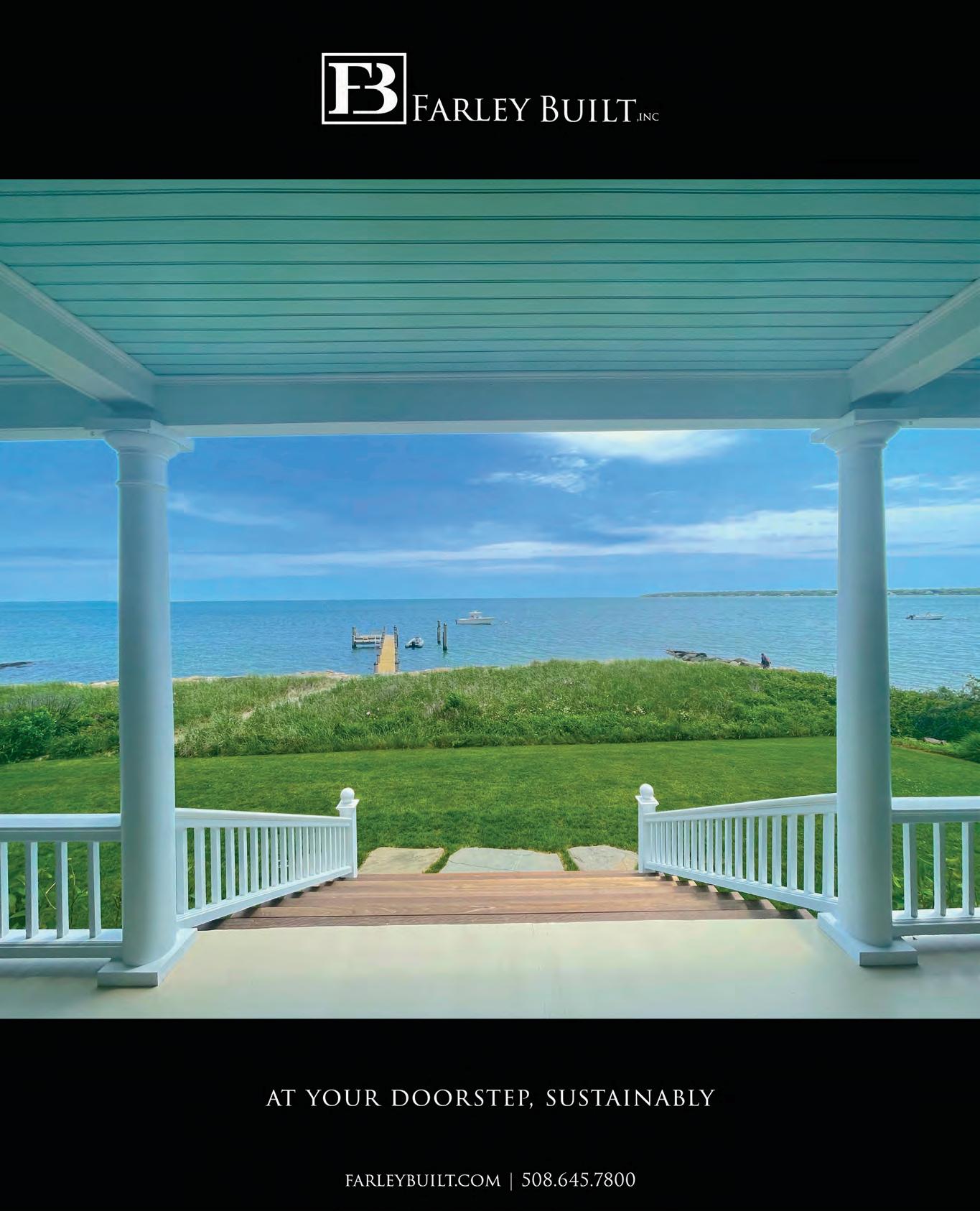


508.696.9999 West Tisbury

508.645.2628 Chilmark

CUSTOM BUILD ON BRUSHY LANE IN EDGARTOWN
This exquisite newly built home located in Katama is a short walk to Edgartown and a bike ride to South Beach. A new owner will appreciate the thought and attention to detail that has been incorporated into this well-designed home. Featuring a combination of contemporary design and finely crafted quality materials, the home has a feeling of luxurious elegance. The living spaces are open, yet well defined with a large chef’s kitchen that flows into the living room, four ensuite bedrooms plus three half bathrooms and a finished lower level, there is plenty of space to relax and entertain. The outdoor area is beautifully landscaped, featuring a gunite pool with a hot tub, outdoor shower, and gas fire pit. Exclusively offered for $5,495,000.

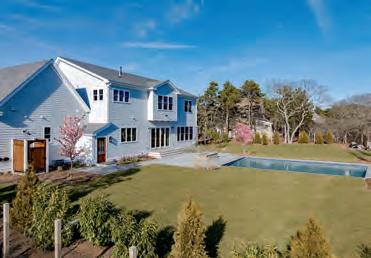


An Independent Firm Specializing in Choice Properties for 50 Years 504 State Road, West Tisbury MA 02575 Beetlebung Corner, Chilmark MA 02535 www.tealaneassociates.com

























































































 Geoff visits with Anna Edey in her living room.
Geoff visits with Anna Edey in her living room.













































































